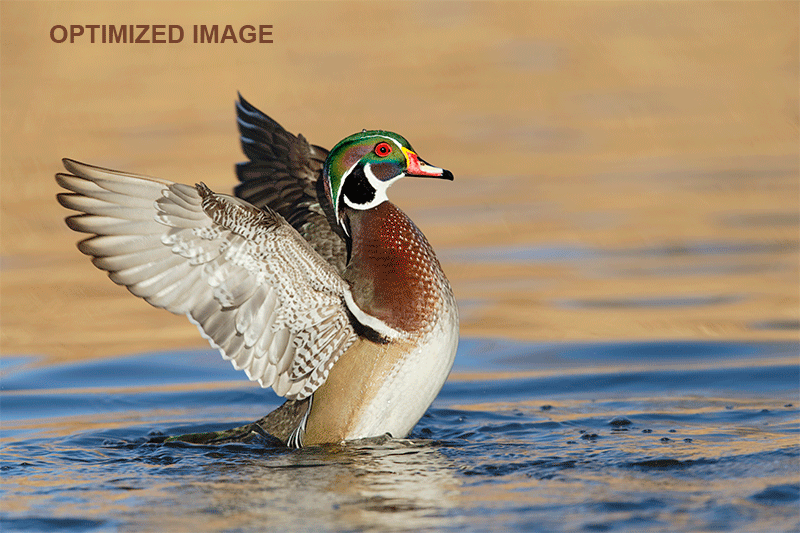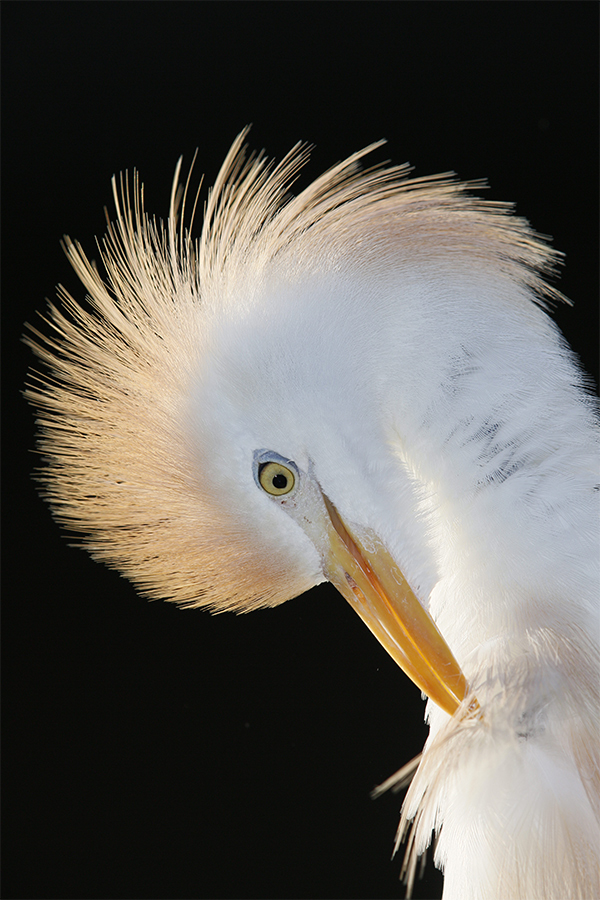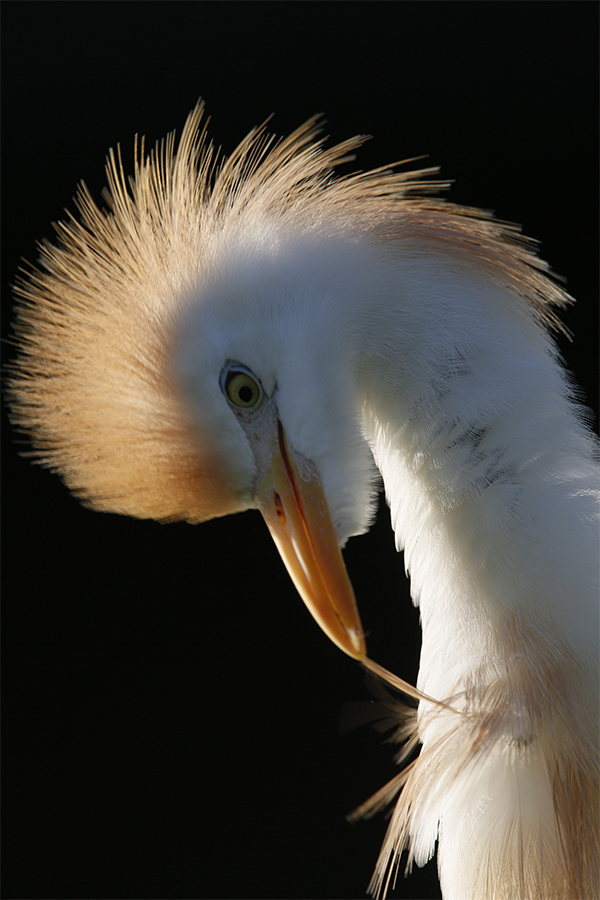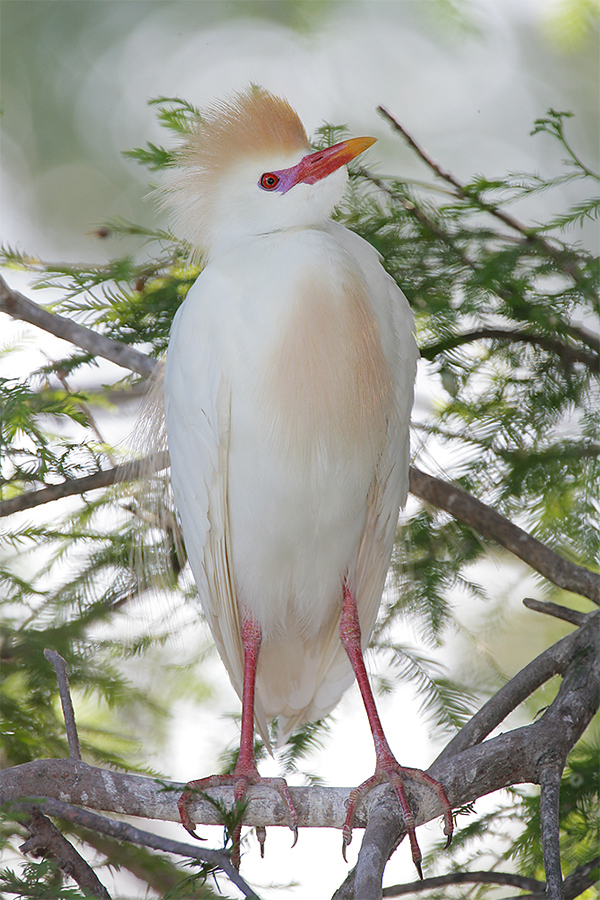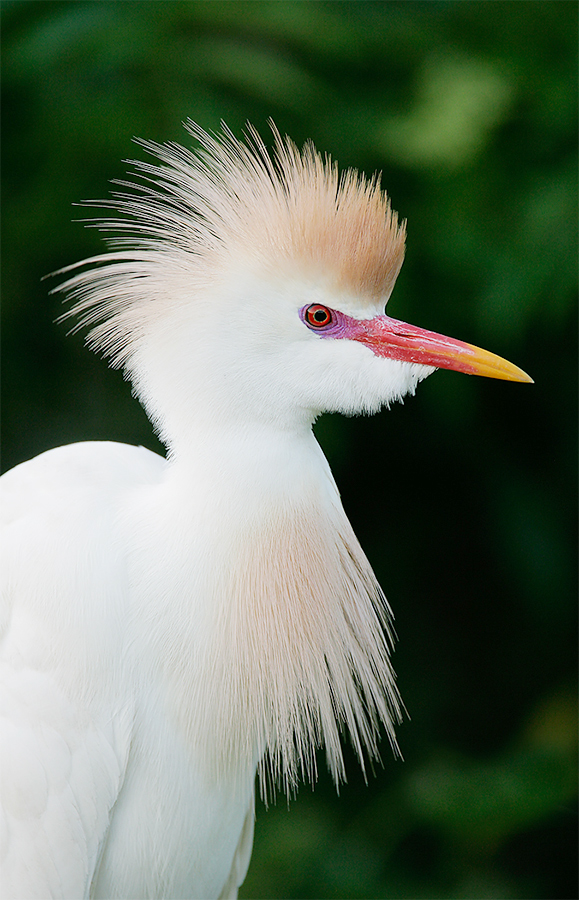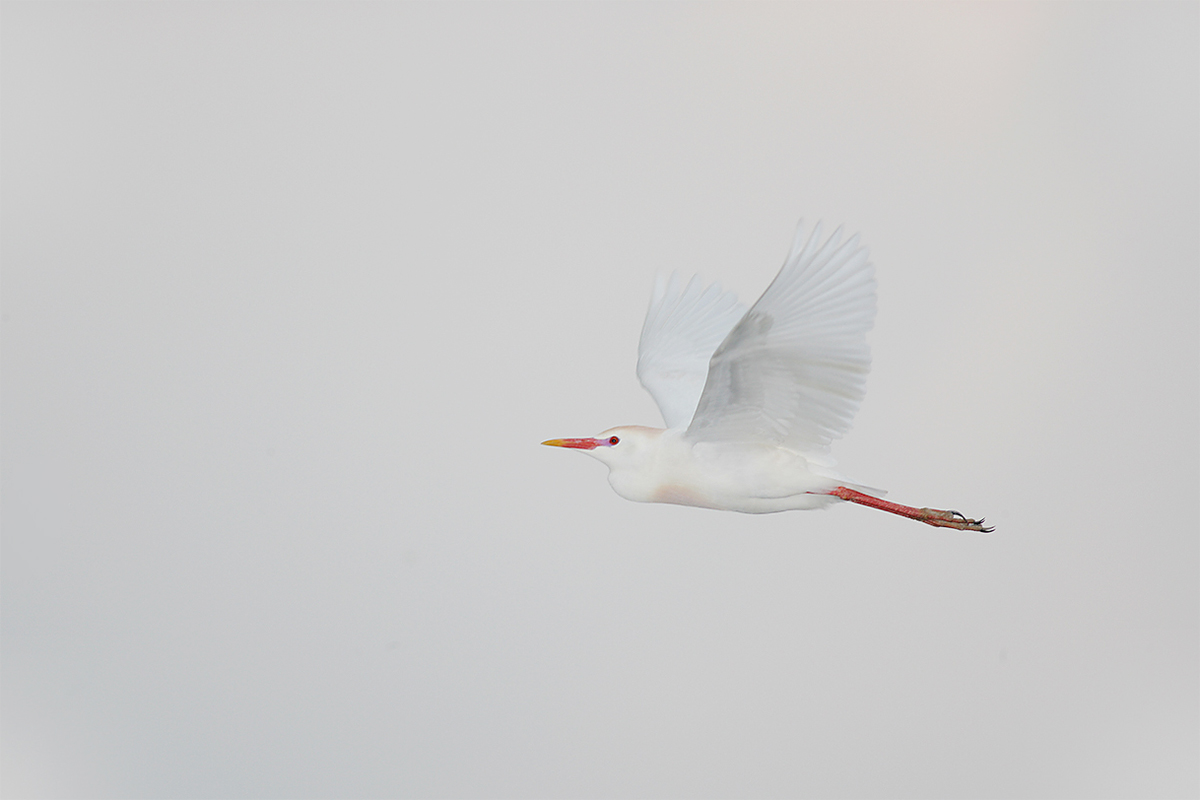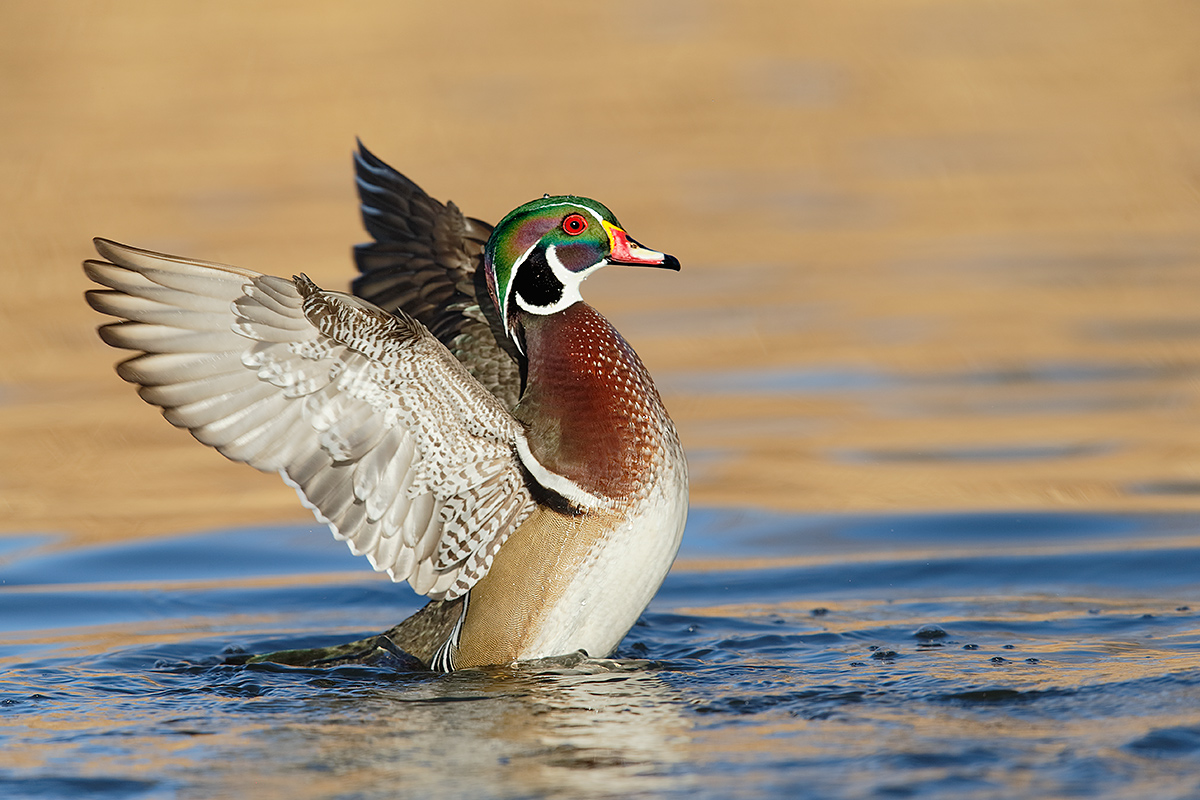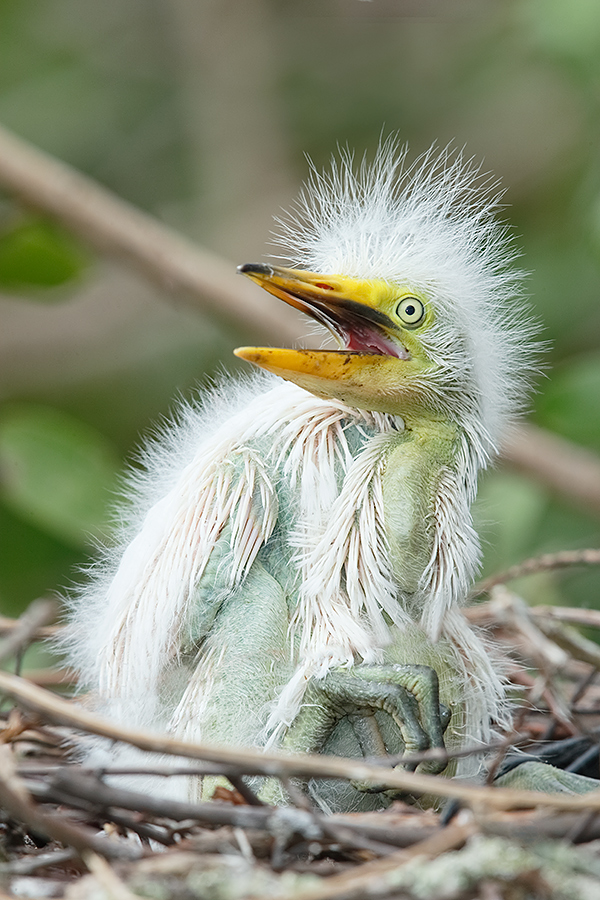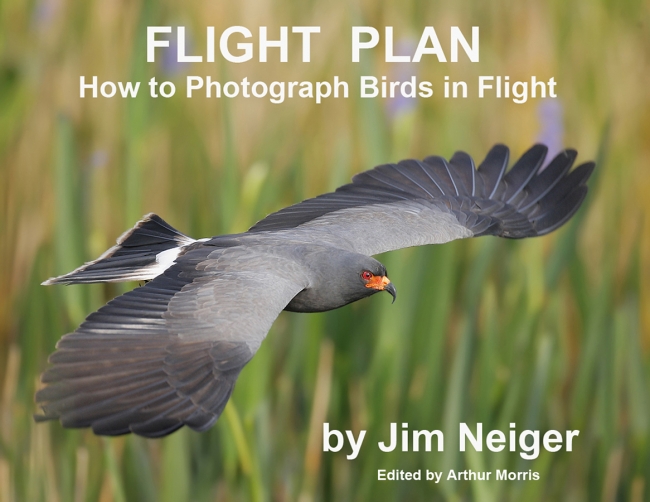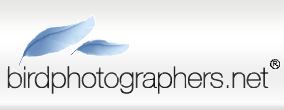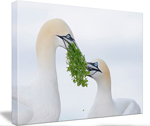April 27th, 2014
|
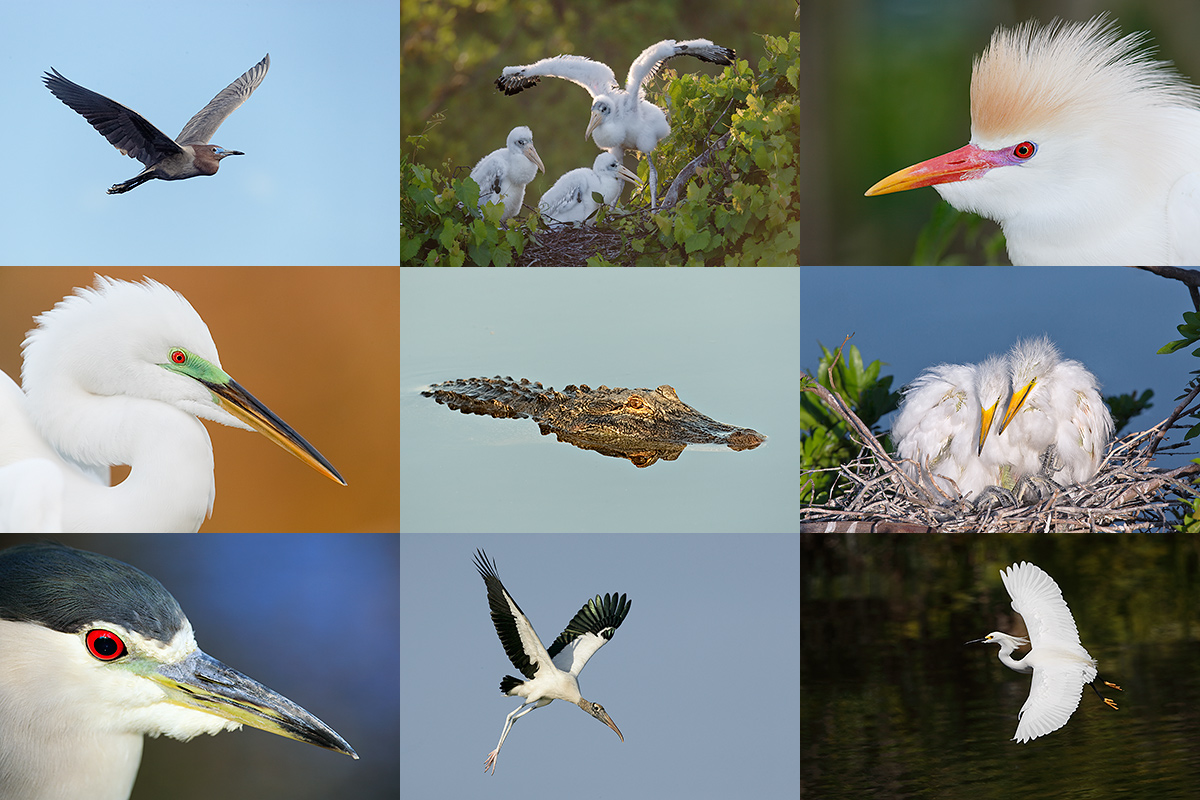
|
|
Join me at Gatorland next Saturday for a ton of learning. If you want to learn to use your flash and to make great photos in cluttered rookeries, you will not want to miss this one. Click on the composite image to enjoy a larger version. Click on the composite to enjoy the larger size.
|
Another Gatorland Short Notice Saturday Full-Day In-the-Field Workshop
Saturday May 3, 2014. 7:15am till 10:15am & 4:00pm till dusk. Lunch, image review, and Photoshop session included. Limit 6. A very small group is again likely: $399.
Late Registration Discount
Right Now It’s Just Me
Call me this weekend at 863-692-0906 or call Jim or Jennifer during the week for info on the late registration discount for the May 3 I-T-F Workshop.
The cost of your Gatorland Photographer’s Pass is not included.
Small and large chicks in the nest. Breeding plumage Cattle and Snowy Egrets. And tons more. You will learn to spot the good situations, to choose the best perspective, to see and understand the light, to get the right exposure every time after making a single test exposure, and to design pleasing images by mastering your camera’s AF system. A big part of the above is that you will learn how and why you must work in Manual mode 90% of the time at Gatorland.
At lunch we will review my images, take a look at five of your best images from the morning session (for those who opt to bring their laptops), and process a few of my images in Photoshop after converting them in DPP. That followed by Instructor Nap Time. Last Saturday all 3 folks had a great time and learned a ton. The long-range weather forecast for next Saturday is looking good with just a chance for afternoon thunderstorms.
Payment in full via credit card is due upon registering. Please call Jim or Jennifer at 863-692-0906 to register.
The Streak Continues: 149
The knee is feeling somewhat better this morning. I got into bed last night for a “nap” at about 7pm. A combination of knee pain and (obviously) jet lag woke me just before midnight. I read until nearly 2:00am and then fell into a deep sleep until just before 6:00am. All in all it was a good night’s sleep and I feel well rested.
This post marks 149 straight days with a new educational blog post. With so many folks getting in the habit of using our B&H links and our Amazon logo-links why quit now? To show your appreciation for my efforts here, we do ask that you use our the B&H and Amazon affiliate links on the right side of the blog for all of your purchases. Please check the availability of all photographic accessories in the BIRDS AS ART Online Store, especially Gitzo tripods, Wimberley tripod heads, and the like. We sell only what I used, tested, and can depend on. We will not sell you junk. We know the tools that you need to make creating great images easy and fun. And we are always glad to answer your gear questions via e-mail.
You can find the following items in the store: Gitzo tripods, Mongoose M3.6 and Wimberley heads, plates, low feet, and accessories, flash brackets, , Delkin e-film Pro Compact Flash Cards, LensCoat products, and our unique line-up of educational materials including ABP I & II, Digital Basics, Site and Set-up e-Guides, Canon and Nikon Camera Users and AF e-Guides, and MP-4 Photoshop video tutorials among others.
I would of course appreciate your using our B&H affiliate links for all of your major gear, video, and electronic purchases. For the photographic stuff mentioned in the paragraph above we, meaning BAA, would of course greatly appreciate your business. Here is a huge thank you to the many who have been using our links on a regular basis and visiting the BAA Online store as well.
This blog post took about 2 1/2 hours to create. Enjoy!
ps: I finished this one in less than 2 days:
It was a head-scratching who-done-it right up until the very end. I need to read more by Mary Higgins Clark.
|
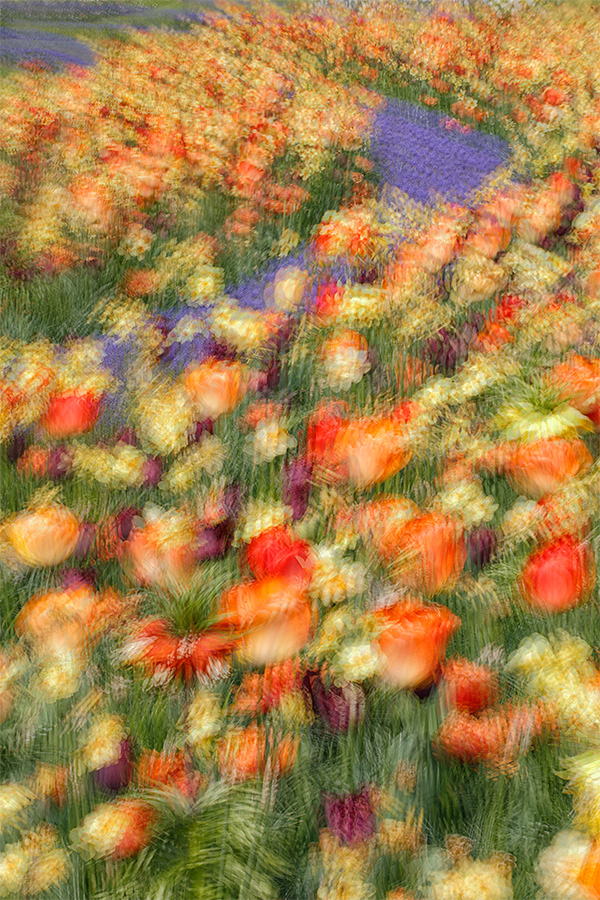
|
|
This image was created just before 4pm on our last day at Keukenhof Gardens on the Holland Tulip IPT with the tripod-mounted Canon EF 100mm f/2.8L IS macro lens and the Canon EOS 5D Mark III Digital camera body. ISO 50. Evaluative metering +1/3 stop: 1/6 sec. at f/32 in Av mode.
The Blur-Haters really came out of the carpeting when commenting on this image. Click here and scroll down to see what they had to say.
|
Responding to the Blur Haters
Jack Goodman Comment
Jack Goodman commented as below on the Keukenhof Farewell Painting image. Frankly, his comment on turning a photograph into a painting left me utterly baffled….
Artie, I hate it. It is an attempt to turn a photograph into a painting. A gimmick. Jack
I responded:
Jack, thanks for sharing your thoughts so honestly. But with all due respect, I must ask, what is wrong with creating a photograph with a painterly look? What you see as a gimmick, I see as being creative. While many others profess to “hate it,” others see the image as a Renoir or a Monet….I love it as well. artie
Andy Hays Comment
Andy Hays also commented on the Keukenhof Farewell Painting image:
Arthur Morris, generous, sharing person.
With all due respect to a great teacher and photographer, if I look at that image for any length of time, my eyes hurt.
One of these days, when you are between trips and other obligations, please give us a rationale as to why blurring is a tack one should take to become an accomplished photographer. Blurs were what I had in my first classes with you, which you referenced, in essence, demonstrated ineptness as a photographer. We have come full circle.
I responded:
Hi Andy, As I have said here often, blurs, for some, are an acquired taste. Others will always hate them. One does not need to learn to create pleasing blurs in order to become an accomplished photographer, but many who have mastered the art of making sharp images (and a few who have not) enjoy learning to create pleasing blurs as a way to step out of the box and become a more creative photographer. Others choose to stay in the box.
Like you, one of my very best students did not see the point of creating pleasingly blurred images, at least when he first started traveling with us. He began having fun at Bosque by learning to create blurred images of salt cedar foliage. More recently, his “Great Blue Heron Leg/Moving Water Blur” image has been honored in several major photographic competitions….
99% of successful blurs need to be in sharp focus. 99.99% of pleasing blurs are planned and skillfully executed. That leaves the .01% that are successful accidents. Lastly, as noted above in part, creative, well done pleasing blurs have been earning high honors in all major international photographic competitions for several decades.
I should have mentioned in the Keukenhof Farewell Painting blog post that those with an open mind who would like to learn to create pleasing blurs should get themselves a copy of A Guide to Pleasing Blurs by Denise Ippolito and yours truly.
ps: folks whose “eyes hurt” or “get a headache” when viewing pleasingly blurred images like the one we are talking about here might wish to have their eyes checked. Denise Ippolito noted that many folks with poor vision, especially the elderly, have vision-related problems when viewing multiple exposures or other types of pleasing blurs.
The Promised Flapper; Well Worth the Wait?
In the “The Promised Flapper; Well Worth the Wait?” blog post here, I wrote in part:
For the Eagle-Eyed Photoshop Police
In the previous blog post (Asking a Lot), several eagle-eyed Photoshop policemen pointed out problems with my optimized image. They did of course, have the advantage of seeing the original. It is always easier to spot processing imperfections when you know exactly where to look. Today they have a second chance. I will tell you that I did some substantial Photoshop work in two areas of this image.
Do you see anything funky? Do let us know exactly where I went to work and I will tip my hat to you if you are correct.
The Truth Be Told
Though many folks–even those who brought the image into Photoshop and used advanced Photoshop police-work detection techniques–saw problems with the golden water background in various places, nothing, as you can see by taking a good look at the Animated GIF above, was done to the background.
After rotating the image I first did some Eye Doctor work–eliminating the second or extra eye highlight, the one caused by the reflection of the sun off the water. Then I used the Patch Tool, Content-Aware Fill, the Spot Healing Brush, and the Clone Stamp Tool to eliminate the ugly specular highlights on the side of the breast. Aside from my usual color correction and NIK work, that was it.
It has long been my contention that when you know in advance what changes have been made in Photoshop it is easy to be critical. When you have no idea, folks often imagine changes that were not made while missing what was actually done. Just as happened here.
Digital Basics
Are you tired of making your images look worse in Photoshop? Do you have no clue as to how I optimized the image above? The Photoshop stuff mentioned above plus tons more is detailed in my Digital Basics File, an instructional PDF that is sent via e-mail. It includes my complete digital workflow, dozens of great Photoshop tips, the use of Contrast Masks, several different ways of expanding canvas, all of my time-saving Keyboard Shortcuts, Quick Masking, Layer Masking, and NIK Color Efex Pro basics, my killer image clean-up techniques, Digital Eye Doctor, creating time-saving actions, and lots more.
The DPP RAW Conversion Guide
To learn why I use Canon’s Digital Photo Professional (DPP) to convert every image that I work on, click here.
|
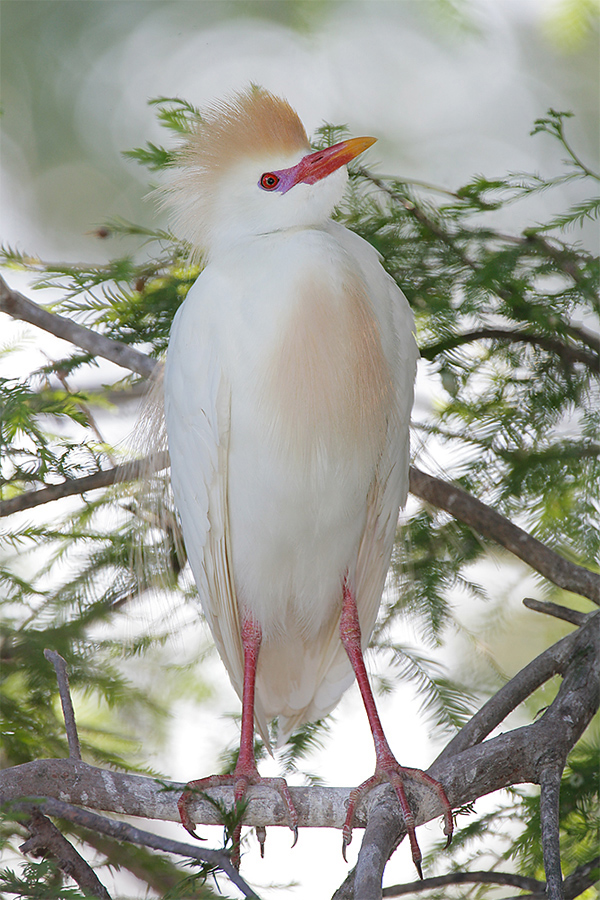
|
|
Above is the image with the offending branch removed. I used the Divide and Conquer technique detailed in Digital Basics. This technique uses both the Clone Stamp Tool and the Patch Tool.
|
One of My Very Favorite Wading Bird Species…
In the “One of My Very Favorite Wading Bird Species…” blog post here, I asked, What is the single-most distracting element in this image?
The only thing that bugged me–as noted by several folks, was the dark stick to our right of the bird’s head.
|

|
|
All of the images created at the St. Augustine Alligator Farm and copyright Arthur Morris/BIRDS AS ART
From top left clockwise to center: Snowy Egret pair in breeding plumage, breeding plumage Cattle Egret with fill flash, large Great Egret chicks in the nest, killer breeding plumage Snowy Egret displaying, flash-as-main light Great Egret chick happy to see mom, Little Blue Heron chicks, Cattle Egret breeding plumage head portrait, flash flight Wood Stork with nesting material, Great Egret landing at the nest, large Snowy Egret chicks.
Click on the image to enjoy a larger version.
|
St. Augustine Alligator Farm Short-Notice IPT. 3-FULL DAYS. Early entry/Late stay. May 5-7, 2014. Meet and greet at 8pm on Sunday May 4: $1299. Two Great Leaders: Arthur Morris and Denise Ippolito
This trip is a go.
Breeding herons, egrets, and Wood Storks. Eggs and chicks in the nest. Some fledged young possible. Breeding behaviors including displaying and copulations. Flight and flash flight. Great Egret, Snowy Egret, Little Blue Heron, Cattle Egret, Tricolored Heron, Wood Stork. Early May rocks at the Farm as the weather is usually gorgeous and there should be lots of both small and large chicks in the nest. And you avoid the possibly oppressive heat of June and July.
Includes in-the-field instruction, early entry, late stay, $5/person late-stay gratuity, informal, small group Photoshop and image review sessions. Three lunches.
Not included: your lodging, your St. Augustine Alligator Farm photographer’s pass ($79.95 for the year); we will be more than glad to pre-order your pass for you. Please let us know when you register.
What you will learn:
How to see the good situations.
How to best avoid the clutter of a rookery by choosing the very best perspective.
How to properly evaluate the histogram and come up with the right exposure every time after making a single test exposure
How to see and understand the light.
How to to design pleasing images by mastering your camera’s AF system.
Why you must work in Manual mode 95% of the time when photographing at a rookery and how to do it.
How to evaluate and process your images.
Via intensive instruction how to use fill flash flash as main light, and Manual flash.
Flash flight techniques including the necessary use of high speed sync.
And tons more.
Please call Jim or Jen at 863-692-0906 to hold your spot with your non-refundable $299 credit card deposit and then put your check in the mail along with your signed registration form; you can find the form here.
Suitable airports: Jacksonville (JAX), Daytona Beach (DAB), Orlando MCO).
We look forward to seeing you in the nation’s oldest city for three days of fun and learning.
|
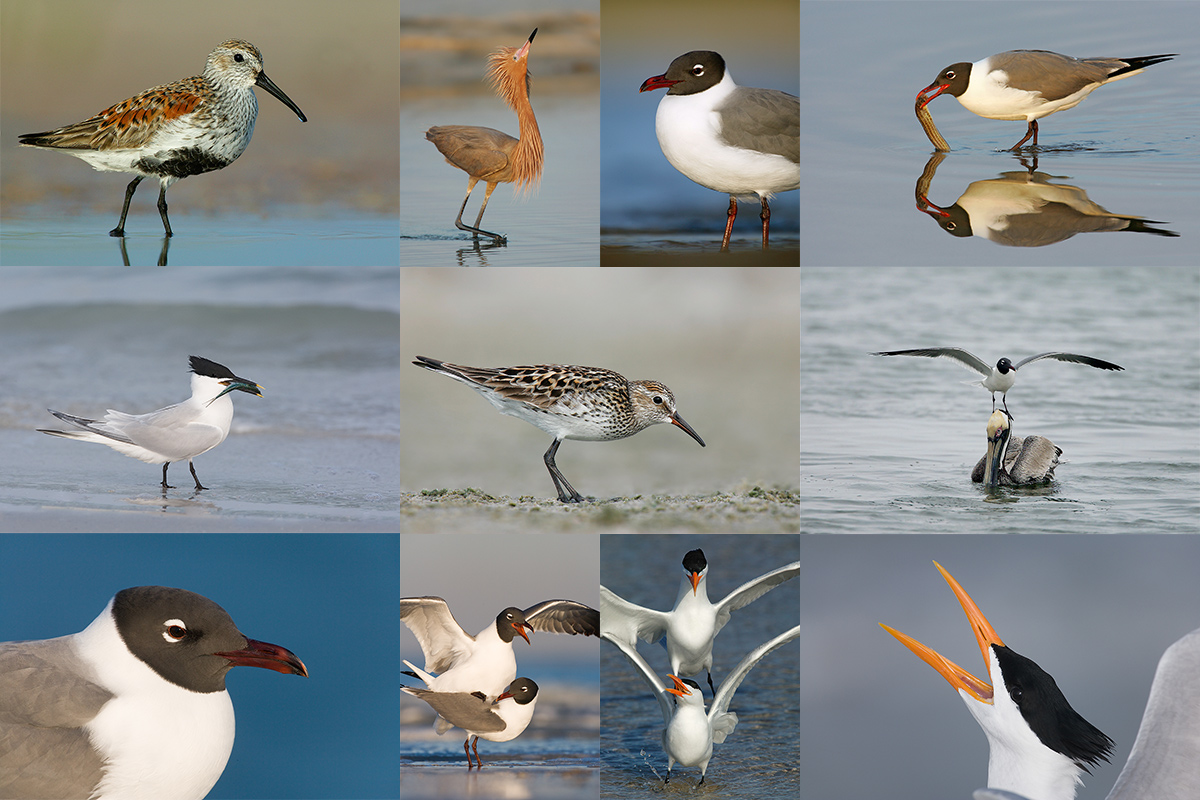
|
|
Fort DeSoto in spring is rich with tame birds. With many in breeding plumage it is a photographer’s paradise. I hope that you can join me there in mid-May.
|
Short Notice Fort DeSoto IPT/In-the-Field Workshops: May 9, 10, & 11, 2014
IPT–3 FULL DAYs: $1099
In-the-Field Workshops: $399/day
Fort DeSoto in spring is so good that I needed to create two cards in order to give folks an idea of what is possible. Even then I have barely scratched the surface. If you are coming from out of town you will surely want to do all 3 days, the entire IPT. Local folks may wish to join me for one or more full days.
There will Lots of tame birds including breeding plumage Laughing Gull and Royal and Sandwich Terns courting and copulating. American Oystercatcher plus lots of sandpipers and plovers, some in breeding plumage. Red Knot in breeding plumage likely. Lots of wading birds including Great and Snowy Egrets, both color morphs of Reddish Egret, Great Blue, Tricolored and Little Blue Heron, and Yellow-crowned Night-Heron. Roseate Spoonbill and WOod Stork between possible and likely…. Lots of flight photography with the gulls and terns and with Brown Pelican.
You will learn how to approach free and wild birds without disturbing them, to understand and predict bird behavior, to identify many species of shorebirds, to spot the good situations, to choose the best perspective, to see and understand the light, to get the right exposure every time after making a single test exposure, and to design pleasing images by mastering your camera’s AF system. And you will learn learn how and why to work in Manual mode (even if you are scared of it).
At lunch we will review my images–folks learn a ton watching me edit–why keep this one and delete that one. If you opt to bring your laptop, we will take a look at five of your best images from the morning session. We will process a few of my images in Photoshop after converting them in DPP. That followed by Instructor Nap Time.
This is the IPT hotel: Comfort Inn St. Petersburg, FL. 2260 54th Ave N., St. Petersburg, FL 33714. tel: 1-727-362-0075. The best airport is Tampa (TPA).
Payment in full via credit card is due upon registering. Please call Jim or Jennifer at 863-692-0906 to register.
|
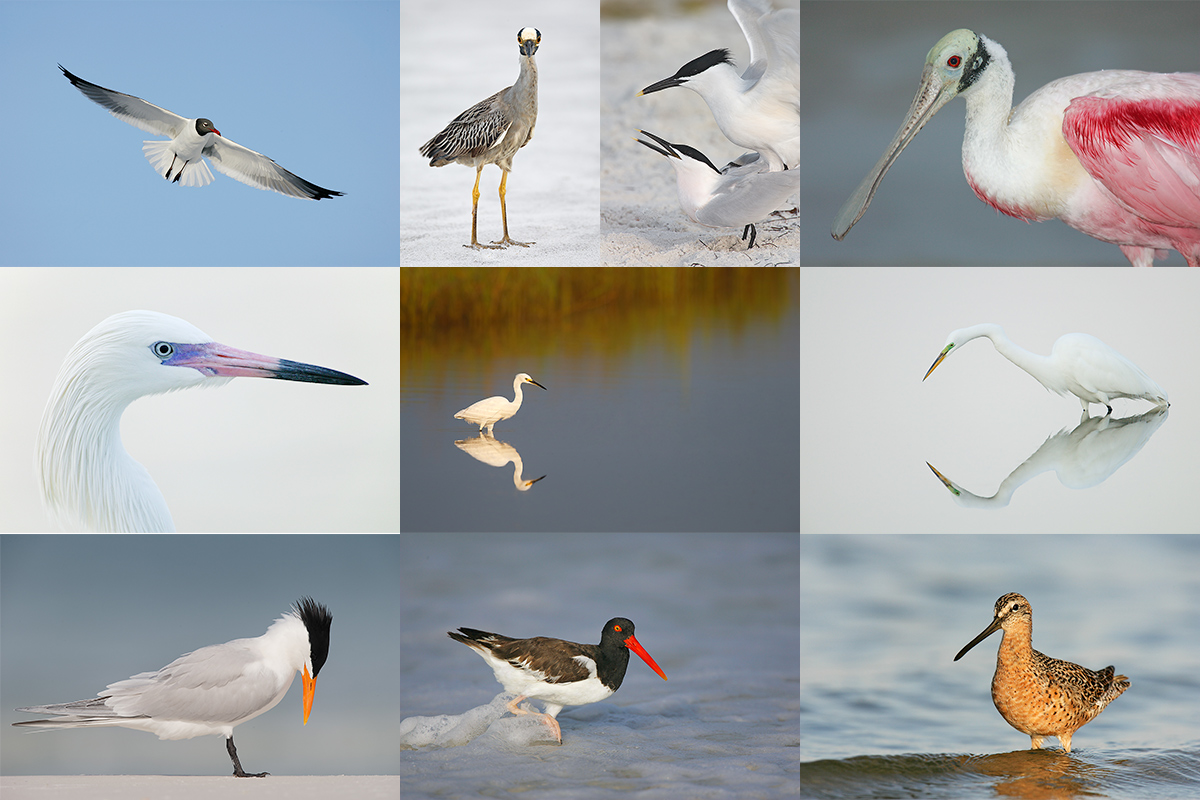
|
|
Fort DeSoto in spring is rich with tame birds. With many in breeding plumage it is a photographer’s paradise. I hope that you can join me there in mid-May.
|
Fort DeSoto Site Guide
Can’t make it in mid-May? Get yourself a copy of the Fort DeSoto Site Guide. Learn the best spots, where to be when in what season in what weather. Learn the best wind directions for the various locations. BAA Site Guides are the next best thing to being on an IPT. You can see all of them here.
Shorebirds/Beautiful Beachcombers
If the shorebirds in the ID quiz gave you pause, get yourself a copy of my Shorebirds/Beautiful Beachcombers. Includes ID tips, shorebird biology, migration, and tons more. All in my simple-to-read easy-to-read style.
Support the BAA Blog. Support the BAA Bulletins: Shop B&H here!
We want and need to keep providing you with the latest free information, photography and Photoshop lessons, and all manner of related information. Show your appreciation by making your purchases immediately after clicking on any of our B&H or Amazon Affiliate links in this blog post. Remember, B&H ain’t just photography!
….. …..
Typos
In all blog posts and Bulletins, feel free to e-mail or to leave a comment regarding any typos, wrong words, misspellings, omissions, or grammatical errors. Just be right. 🙂
April 26th, 2014 The Streak Continues: 148
I woke yesterday at 4:15am Holland time, 10:15pm the day before in Florida. My flight to Detroit was a breeze–I read and dozed, dozed and read, Customs and my connection went smoothly and daughter Jennifer and grandson Sam picked me up at about 3:30pm at the Orlando Airport. It was good to get home.
This post marks 148 straight days with a new educational blog post. With so many folks getting in the habit of using our B&H links and our Amazon logo-links why quit now? To show your appreciation for my efforts here, we do ask that you use our the B&H and Amazon affiliate links on the right side of the blog for all of your purchases. Please check the availability of all photographic accessories in the BIRDS AS ART Online Store, especially Gitzo tripods, Wimberley tripod heads, and the like. We sell only what I used, tested, and can depend on. We will not sell you junk. We know the tools that you need to make creating great images easy and fun. And we are always glad to answer your gear questions via e-mail.
You can find the following items in the store: Gitzo tripods, Mongoose M3.6 and Wimberley heads, plates, low feet, and accessories, flash brackets, , Delkin e-film Pro Compact Flash Cards, LensCoat products, and our unique line-up of educational materials including ABP I & II, Digital Basics, Site and Set-up e-Guides, Canon and Nikon Camera Users and AF e-Guides, and MP-4 Photoshop video tutorials among others.
I would of course appreciate your using our B&H affiliate links for all of your major gear, video, and electronic purchases. For the photographic stuff mentioned in the paragraph above we, meaning BAA, would of course greatly appreciate your business. Here is a huge thank you to the many who have been using our links on a regular basis and visiting the BAA Online store as well.
This blog post took about 2 hours to create. Enjoy!
|
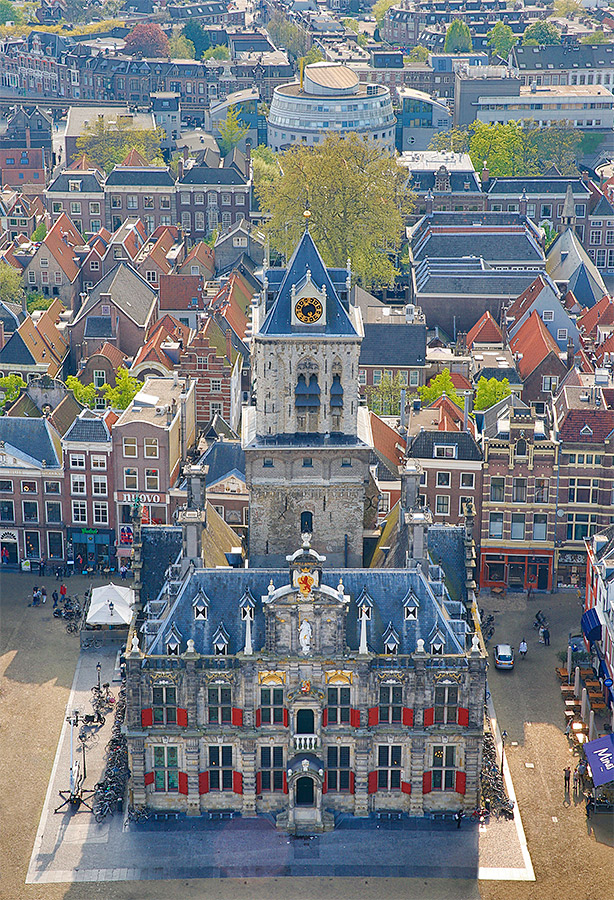
|
|
This +/-2 stop/3-frame in-camera HDR Natural image of City Hall in Delft, The Netherlands, was created at 5:11pm on April 22, 2014 with the Canon EF 24-70mm f/2.8L II USM lens (sort of hand held at 70mm) and the Canon EOS 5D Mark III. ISO 400. Evaluative metering +1 stop yielded a base exposure of 1/25 sec. at f/22 in Av mode. Color temperature: AWB.
Five sensors down from the central sensor/AI Servo/Rear Focus AF on the white statue below the red & yellow lion emblem was framed active at the moment of each exposure. Click here to see the latest version of the Rear Focus Tutorial. Click on the image to see a larger version.
|
The View From the Top
On Tuesday afternoon past we visited the city of Delft as part of the Touch of Holland portion of the Tulip IPT. There was lots to see and lots of interesting street photography. Mike Gotthelf and I decided to climb the tower of Nieuwe Kerk, the New Church with our photo gear. The tower is the second highest church tower in the Netherlands. The spiral stairway was extremely narrow. And very steep. At 108.75 meters (357 feet) high–356 steps in all, making the climb up the spire was a challenge for both of us. But we made it. The views from the top were–as expected–spectacular.
We had been hoping for clouds to cut down on the contrast, but the skies cleared and it turned out to be a sunny afternoon. Going HDR Natural was the obvious choice. Without thinking too hard I set the aperture at f/22. This left the base shutter speed at 1/25 sec. and the shutter speed for the lightest image in the series at 1/6 sec. Even with an image stabilized lens, creating a sharp image hand held at 1/6 sec. would have been a challenge so I rested the butt-end of the 5D Mark III on the angled top of the 6-inch thick restraining wall. I fine-tuned the up and down framing by moving the camera slightly forward or back. I shared my jury-rigged solution with Mike and we were both able to create sharp series of images in a challenging situation.
In retrospect, f/11(with 2 stops more shutter speed) would have been fine at 70mm…
5D Mark III User’s Guide
You can learn the fine points of creating creating in-camera HDRs and in-camera Multiple Exposures along with everything that I know about this great camera in my 5D Mark III User’s Guide here.
Get a Free Copy of Our 5D Mark III User’s Guide
Purchase a Canon EOS-5D Mark III using one of our product-specific B&H affiliate links above or by clicking on the logo link below and shoot me your B&H receipt via e-mail. Once and if the purchase appears in my account–it should unless you screwed up somehow and did not use the link :), I will be glad to have Jim send you a free copy of our 5D Mark III User’s Guide.
Am I Indestructible?
Even approaching age 68, with my five trigger fingers and my aching right shoulder, I usually think of myself as indestructible. About three months ago my left knee flared up. Within a few days of intense alternative medicine therapy it was a good as new. The week before we left for Holland it flared up again. The surgeon told me in 2006 that I would be back within a year for a new knee. I begged to differ. The day before I got on the plane Rock-taped it.
By the time we hit Delft a week later, the knee was feeling pretty good.
I did not think twice about climbing the tower. Cardio-wise I was fine barely stopping to rest. And I easily beat the younger Mike Gotthelf to the top. On the way down the knee acted up a bit but on Wednesday it felt fine. By Thursday I was hurting and last night the pain (and the jet lag) woke me at 1:00am. I was out of bed and working by 2:00am.
I need to learn to take things a bit easier….
Was it Worth It?
In a word, no. But I am sure that it will be feeling a lot better in a week. (PMA= positive mental attitude.)
Very Small Group Instruction 🙂
Nobody has signed up for the next Gatorland In-the-field Saturday Workshop :). Both the St. Augustine and the Fort DeSoto IPTs have a single registrant. Both will run. See additional details for all three below.
|

|
|
Join me at Gatorland next Saturday for a ton of learning. If you want to learn to use your flash and to make great photos in cluttered rookeries, you will not want to miss this one. Click on the composite image to enjoy a larger version. Click on the composite to enjoy the larger size.
|
Another Gatorland Short Notice Saturday Full-Day In-the-Field Workshop
Saturday May 3, 2014. 7:15am till 10:15am & 4:00pm till dusk. Lunch, image review, and Photoshop session included. Limit 6. A very small group is again likely: $399.
Late Registration Discount
Right Now It’s Just Me
Call me this weekend at 863-692-0906 or call Jim or Jennifer during the week for info on the late registration discount for the May 3 I-T-F Workshop.
The cost of your Gatorland Photographer’s Pass is not included.
Small and large chicks in the nest. Breeding plumage Cattle and Snowy Egrets. And tons more. You will learn to spot the good situations, to choose the best perspective, to see and understand the light, to get the right exposure every time after making a single test exposure, and to design pleasing images by mastering your camera’s AF system. A big part of the above is that you will learn how and why you must work in Manual mode 90% of the time at Gatorland.
At lunch we will review my images, take a look at five of your best images from the morning session (for those who opt to bring their laptops), and process a few of my images in Photoshop after converting them in DPP. That followed by Instructor Nap Time. Last Saturday all 3 folks had a great time and learned a ton. The long-range weather forecast for next Saturday is looking good with just a chance for afternoon thunderstorms.
Payment in full via credit card is due upon registering. Please call Jim or Jennifer at 863-692-0906 to register.
|

|
|
All of the images created at the St. Augustine Alligator Farm and copyright Arthur Morris/BIRDS AS ART
From top left clockwise to center: Snowy Egret pair in breeding plumage, breeding plumage Cattle Egret with fill flash, large Great Egret chicks in the nest, killer breeding plumage Snowy Egret displaying, flash-as-main light Great Egret chick happy to see mom, Little Blue Heron chicks, Cattle Egret breeding plumage head portrait, flash flight Wood Stork with nesting material, Great Egret landing at the nest, large Snowy Egret chicks.
Click on the image to enjoy a larger version.
|
St. Augustine Alligator Farm Short-Notice IPT. 3-FULL DAYS. Early entry/Late stay. May 5-7, 2014. Meet and greet at 8pm on Sunday May 4: $1299. Two Great Leaders: Arthur Morris and Denise Ippolito
This trip needs four to run.
Breeding herons, egrets, and Wood Storks. Eggs and chicks in the nest. Some fledged young possible. Breeding behaviors including displaying and copulations. Flight and flash flight. Great Egret, Snowy Egret, Little Blue Heron, Cattle Egret, Tricolored Heron, Wood Stork. Early May rocks at the Farm as the weather is usually gorgeous and there should be lots of both small and large chicks in the nest. And you avoid the possibly oppressive heat of June and July.
Includes in-the-field instruction, early entry, late stay, $5/person late-stay gratuity, informal, small group Photoshop and image review sessions. Three lunches.
Not included: your lodging, your St. Augustine Alligator Farm photographer’s pass ($79.95 for the year); we will be more than glad to pre-order your pass for you. Please let us know when you register.
What you will learn:
How to see the good situations.
How to best avoid the clutter of a rookery by choosing the very best perspective.
How to properly evaluate the histogram and come up with the right exposure every time after making a single test exposure
How to see and understand the light.
How to to design pleasing images by mastering your camera’s AF system.
Why you must work in Manual mode 95% of the time when photographing at a rookery and how to do it.
How to evaluate and process your images.
Via intensive instruction how to use fill flash flash as main light, and Manual flash.
Flash flight techniques including the necessary use of high speed sync.
And tons more.
Please call Jim or Jen at 863-692-0906 to hold your spot with your non-refundable $299 credit card deposit and then put your check in the mail along with your signed registration form; you can find the form here.
Suitable airports: Jacksonville (JAX), Daytona Beach (DAB), Orlando MCO).
We look forward to seeing you in the nation’s oldest city for three days of fun and learning.
|

|
|
Fort DeSoto in spring is rich with tame birds. With many in breeding plumage it is a photographer’s paradise. I hope that you can join me there in mid-May.
|
Short Notice Fort DeSoto IPT/In-the-Field Workshops: May 9, 10, & 11, 2014
IPT–3 FULL DAYs: $1099
In-the-Field Workshops: $399/day
Fort DeSoto in spring is so good that I needed to create two cards in order to give folks an idea of what is possible. Even then I have barely scratched the surface. If you are coming from out of town you will surely want to do all 3 days, the entire IPT. Local folks may wish to join me for one or more full days.
There will Lots of tame birds including breeding plumage Laughing Gull and Royal and Sandwich Terns courting and copulating. American Oystercatcher plus lots of sandpipers and plovers, some in breeding plumage. Red Knot in breeding plumage likely. Lots of wading birds including Great and Snowy Egrets, both color morphs of Reddish Egret, Great Blue, Tricolored and Little Blue Heron, and Yellow-crowned Night-Heron. Roseate Spoonbill and WOod Stork between possible and likely…. Lots of flight photography with the gulls and terns and with Brown Pelican.
You will learn how to approach free and wild birds without disturbing them, to understand and predict bird behavior, to identify many species of shorebirds, to spot the good situations, to choose the best perspective, to see and understand the light, to get the right exposure every time after making a single test exposure, and to design pleasing images by mastering your camera’s AF system. And you will learn learn how and why to work in Manual mode (even if you are scared of it).
At lunch we will review my images–folks learn a ton watching me edit–why keep this one and delete that one. If you opt to bring your laptop, we will take a look at five of your best images from the morning session. We will process a few of my images in Photoshop after converting them in DPP. That followed by Instructor Nap Time.
This is the IPT hotel: Comfort Inn St. Petersburg, FL. 2260 54th Ave N., St. Petersburg, FL 33714. tel: 1-727-362-0075. The best airport is Tampa (TPA).
Payment in full via credit card is due upon registering. Please call Jim or Jennifer at 863-692-0906 to register.
|

|
|
Fort DeSoto in spring is rich with tame birds. With many in breeding plumage it is a photographer’s paradise. I hope that you can join me there in mid-May.
|
Fort DeSoto Site Guide
Can’t make it in mid-May? Get yourself a copy of the Fort DeSoto Site Guide. Learn the best spots, where to be when in what season in what weather. Learn the best wind directions for the various locations. BAA Site Guides are the next best thing to being on an IPT. You can see all of them here.
Shorebirds/Beautiful Beachcombers
If the shorebirds in the ID quiz gave you pause, get yourself a copy of my Shorebirds/Beautiful Beachcombers. Includes ID tips, shorebird biology, migration, and tons more. All in my simple-to-read easy-to-read style.
Support the BAA Blog. Support the BAA Bulletins: Shop B&H here!
We want and need to keep providing you with the latest free information, photography and Photoshop lessons, and all manner of related information. Show your appreciation by making your purchases immediately after clicking on any of our B&H or Amazon Affiliate links in this blog post. Remember, B&H ain’t just photography!
….. …..
Typos
In all blog posts and Bulletins, feel free to e-mail or to leave a comment regarding any typos, wrong words, misspellings, omissions, or grammatical errors. Just be right. 🙂
April 25th, 2014 The Streak Continues: 147
I am not sure when this will be published but it will likely be online before 7:00am Florida time on Friday, April 25th. My flight departs AMS for DTW (Detroit) at 8:15am and daughter Jennifer is picking me up at about 3:30pm at MCO. It will be good to get home. We enjoyed yet another great day at Keukenhof. When you have visited a location for more than a week and everyone ends up wishing that there was more time to photograph, more time to create new and exciting images, more time to try the new techniques, the leaders feel pretty darned good. And that is exactly how Denise and I feel.
This post marks 147 straight days with a new educational blog post. With so many folks getting in the habit of using our B&H links and our Amazon logo-links why quit now? To show your appreciation for my efforts here, we do ask that you use our the B&H and Amazon affiliate links on the right side of the blog for all of your purchases. Please check the availability of all photographic accessories in the BIRDS AS ART Online Store, especially Gitzo tripods, Wimberley tripod heads, and the like. We sell only what I used, tested, and can depend on. We will not sell you junk. We know what you need to make creating great images easy and fun. And we are always glad to answer your gear questions via e-mail.
You can find the following items in the store: Gitzo tripods, Mongoose M3.6 and Wimberley heads, plates, low feet, and accessories, flash brackets, , Delkin e-film Pro Compact Flash Cards, LensCoat products, and our unique line-up of educational materials including ABP I & II, Digital Basics, Site and Set-up e-Guides, Canon and Nikon Camera Users and AF e-Guides, and MP-4 Photoshop video tutorials among others.
I would of course appreciate your using our B&H affiliate links for all of your major gear, video, and electronic purchases. For the photographic stuff mentioned in the paragraph above we, meaning BAA, would of course greatly appreciate your business. Here is a huge thank you to the many who have been using our links on a regular basis and visiting the BAA Online store as well.
This blog post took about 1 hour to create. Enjoy!
Keukenhof Farewell Painting
4pm at the fish sign was our meeting place. Having arrived a few minutes early I was again inspired by friend and multiple IPT veteran Mike Gotthelf. He was doing in-camera Multiple Exposure zoom blurs. As I only had my 100mm macro with me I decided on a 7-frame in-camera Multiple Exposure. I wanted to get a blog post done before bed as I need to be up at 4:30am and on my way to Schipol Airport by 5:30. I was thrilled when I saw this image, the very last image that I created on what turned out to be a great trip with great folks and perfect weather.
I simply created 7 images with the tripod head locked up while barely moving the lens a fraction of an inch between each frame.
Which classical painter worked in this style?
Gotta pack and hit the sack.
Like it or hate it?
Let us know and be sure to let us know why.
5D Mark III User’s Guide
You can learn the fine points of in-camera Multiple Exposures and creating in-camera HDRs plus everything that I know about this great camera in my 5D Mark III User’s Guide here.
Get a Free Copy of Our 5D Mark III User’s Guide
Purchase a Canon EOS-5D Mark III using one of our product-specific B&H affiliate links above or by clicking on the logo link below and shoot me your B&H receipt via e-mail. Once and if the purchase appears in my account–it should unless you screwed up somehow and did not use the link :), I will be glad to have Jim send you a free copy of our 5D Mark III User’s Guide.
|

|
|
Join me at Gatorland for a ton of learning. If you want to learn to use your flash, you will not want to miss this one. Click on the composite image to enjoy a larger version. Click on the composite to enjoy the larger size.
|
The Gatorland Short Notice Saturday Full-Day In-the-Field Workshop
Saturday May 3, 2014. 7:15am till 10:15am & 4:00pm till dusk. Lunch, image review, and Photoshop session included. Limit 6. A very small group is again likely: $399.
The cost of your Gatorland Photographer’s Pass is not included.
Chicks in nests likely. Breeding plumage Cattle and Snowy Egrets. And tons more. You will learn to spot the good situations, to choose the best perspective, to see and understand the light, to get the right exposure every time after making a single test exposure, and to design pleasing images by mastering your camera’s AF system. A big part of the above is that you will learn how and why you must work in Manual mode 90% of the time at Gatorland.
At lunch we will review my images, take a look at five of your best images from the morning session (for those who opt to bring their laptops), and process a few of my images in Photoshop after converting them in DPP. That followed by Instructor Nap Time.
Payment in full via credit card is due upon registering. Please call Jim or Jennifer at 863-692-0906 to register.
Another Used 400 DO For Sale
I will be offering a very well taken care of 400 DO lens for sale when I get back. If you are interested, please shoot me an e-mail. The lens is currently owned by Peter Kes.
|

|
|
All of the images created at the St. Augustine Alligator Farm and copyright Arthur Morris/BIRDS AS ART
From top left clockwise to center: Snowy Egret pair in breeding plumage, breeding plumage Cattle Egret with fill flash, large Great Egret chicks in the nest, killer breeding plumage Snowy Egret displaying, flash-as-main light Great Egret chick happy to see mom, Little Blue Heron chicks, Cattle Egret breeding plumage head portrait, flash flight Wood Stork with nesting material, Great Egret landing at the nest, large Snowy Egret chicks.
Click on the image to enjoy a larger version.
|
St. Augustine Alligator Farm Short-Notice IPT. 3-FULL DAYS. Early entry/Late stay. May 5-7, 2014. Meet and greet at 8pm on Sunday May 4: $1299. Two Great Leaders: Arthur Morris and Denise Ippolito
This trip needs four to run.
Breeding herons, egrets, and Wood Storks. Eggs and chicks in the nest. Some fledged young possible. Breeding behaviors including displaying and copulations. Flight and flash flight. Great Egret, Snowy Egret, Little Blue Heron, Cattle Egret, Tricolored Heron, Wood Stork. Early May rocks at the Farm as the weather is usually gorgeous and there should be lots of both small and large chicks in the nest. And you avoid the possibly oppressive heat of June and July.
Includes in-the-field instruction, early entry, late stay, $5/person late-stay gratuity, informal, small group Photoshop and image review sessions. Three lunches.
Not included: your lodging, your St. Augustine Alligator Farm photographer’s pass ($79.95 for the year); we will be more than glad to pre-order your pass for you. Please let us know when you register.
What you will learn:
How to see the good situations.
How to best avoid the clutter of a rookery by choosing the very best perspective.
How to properly evaluate the histogram and come up with the right exposure every time after making a single test exposure
How to see and understand the light.
How to to design pleasing images by mastering your camera’s AF system.
Why you must work in Manual mode 95% of the time when photographing at a rookery and how to do it.
How to evaluate and process your images.
Via intensive instruction how to use fill flash flash as main light, and Manual flash.
Flash flight techniques including the necessary use of high speed sync.
And tons more.
Please call Jim or Jen at 863-692-0906 to hold your spot with your non-refundable $299 credit card deposit and then put your check in the mail along with your signed registration form; you can find the form here.
Suitable airports: Jacksonville (JAX), Daytona Beach (DAB), Orlando MCO).
We look forward to seeing you in the nation’s oldest city for three days of fun and learning.
Support the BAA Blog. Support the BAA Bulletins: Shop B&H here!
We want and need to keep providing you with the latest free information, photography and Photoshop lessons, and all manner of related information. Show your appreciation by making your purchases immediately after clicking on any of our B&H or Amazon Affiliate links in this blog post. Remember, B&H ain’t just photography!
….. …..
Typos
In all blog posts and Bulletins, feel free to e-mail or to leave a comment regarding any typos, wrong words, misspellings, omissions, or grammatical errors. Just be right. 🙂
April 24th, 2014
|

|
|
Join me at Gatorland for a ton of learning. If you want to learn to use your flash, you will not want to miss this one. Click on the composite image to enjoy a larger version. Click on the composite to enjoy the larger size.
|
The Gatorland Short Notice Saturday Full-Day In-the-Field Workshop
Saturday May 3, 2014. 7:15am till 10:15am & 4:00pm till dusk. Lunch, image review, and Photoshop session included. Limit 6. A very small group is again likely: $399.
The cost of your Gatorland Photographer’s Pass is not included.
Chicks in nests likely. Breeding plumage Cattle and Snowy Egrets. And tons more. You will learn to spot the good situations, to choose the best perspective, to see and understand the light, to get the right exposure every time after making a single test exposure, and to design pleasing images by mastering your camera’s AF system. A big part of the above is that you will learn how and why you must work in Manual mode 90% of the time at Gatorland.
At lunch we will review my images, take a look at five of your best images from the morning session (for those who opt to bring their laptops), and process a few of my images in Photoshop after converting them in DPP. That followed by Instructor Nap Time.
Payment in full via credit card is due upon registering. Please call Jim or Jennifer at 863-692-0906 to register.
The Streak Continues: 146
I will publish this post just after 6:00am Amsterdam time, just after midnight on the east coast. We enjoyed another great morning at Keukenhof–the place is amazing, and then enjoyed a touch of Holland on our afternoon visit to Delft. Not to mention one of the best meals that any of us had ever enjoyed.
This post marks 146 straight days with a new blog post. With so many folks getting in the habit of using our B&H links and our Amazon logo-links why quit now? To show your appreciation for my efforts here, we do ask that you use our the B&H and Amazon affiliate links on the right side of the blog for all of your purchases. Please check the availability of all photographic accessories in the BIRDS AS ART Online Store, especially Gitzo tripods, Wimberley tripod heads, and the like. We sell only what I used, tested, and can depend on. We will not sell you junk. We know what you need to make creating great images easy and fun. And we are always glad to answer your gear questions via e-mail.
You can find the following items in the store: Gitzo tripods, Mongoose M3.6 and Wimberley heads, plates, low feet, and accessories, flash brackets, , Delkin e-film Pro Compact Flash Cards, LensCoat products, and our unique line-up of educational materials including ABP I & II, Digital Basics, Site and Set-up e-Guides, Canon and Nikon Camera Users and AF e-Guides, and MP-4 Photoshop video tutorials among others.
I would of course appreciate your using our B&H affiliate links for all of your major gear, video, and electronic purchases. For the photographic stuff mentioned in the paragraph above we, meaning BAA, would of course greatly appreciate your business. Here is a huge thank you to the many who have been using our links on a regular basis and visiting the BAA Online store as well.
This blog post took about 1 1/2 hours to create. Enjoy!
Flashing the Dark Side
Image #1 is a JPEG that accurately represents the original RAW image capture. I set the flash to +1/3 stop to light what was in effect the shaded side of the bird’s face. The image definitely looks flashed and perhaps over-flashed. Perhaps -1/3 stop on the flash would have been a better choice.
Flash Did Not Fire
The image immediately above was taken just an instant after the opening image. Again, this is a JPEG that accurately represents the original RAW image capture. As the flash did not fire the bird’s face appears dark. Had I been fast enough to add some light–not possible by the way, that would have left the rim light well over-exposed…. On the surface here it seems that the first image, the over-flashed image, would sure be your first choice. Or not?
|
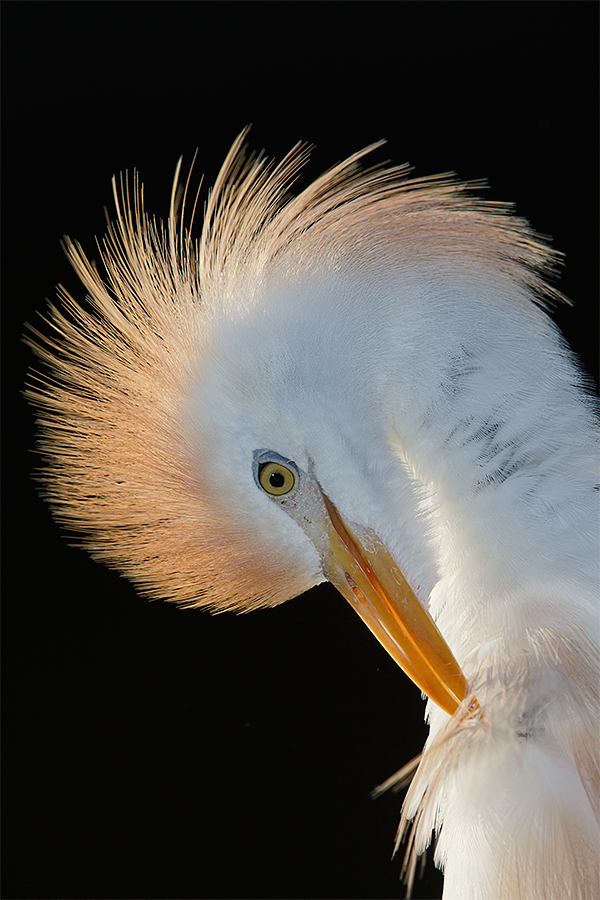
|
Image #3: The Optimized Version of Image #1
|
The Optimized Version of Image #1
Image #3 is the optimized version of Image #1. Please compare this image carefully with Image #4 below.
|
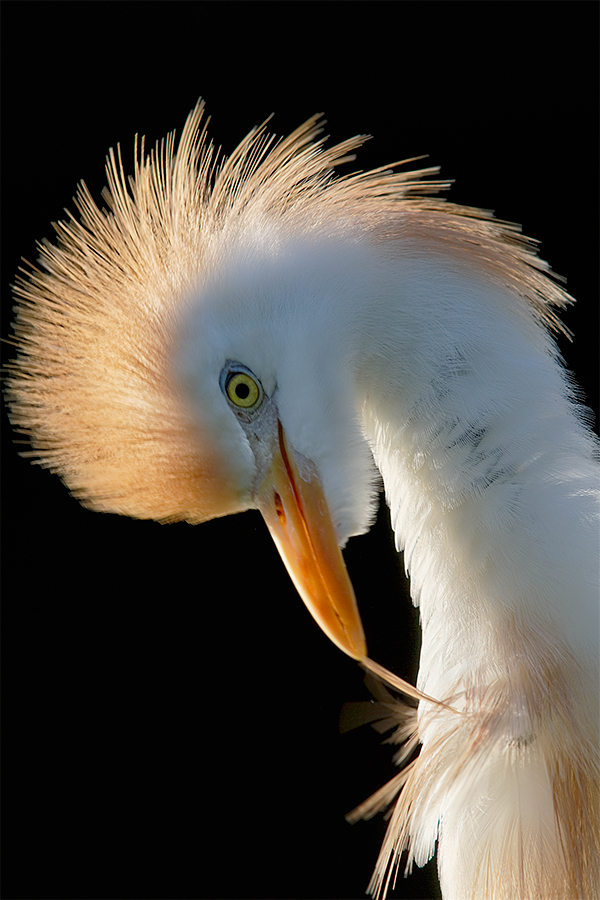
|
Image #4: The Optimized Version of Image #2
|
The Optimized Version of Image #2
Image #4 is the optimized version of Image #2. Please compare this image carefully with Image #3 immediately above.
The Questions
Question 1: Which image features the strongest post, Image #3 or Image #4? Why?
Question 2: Which image has the smoothest white tones on the bird’s face, Image #3 or Image #4?
Question 2: Overall, which optimized image is stronger, Image #3 or Image #4? Why?
Using Flash: First Impressions Can Be Deceiving…
It is important to realize that when you are comparing similar images created with and without flash that you must compare the optimized images rather than the original captures….
BTW
There is a tall viewing tower at Gatorland that overlooks the large gator moat. Climbing the tower with your gear can offer some good and different photographic opportunities. If you are working from the swamp boardwalk and have the tower in your background, it will, 9 times out of 10, ruin an image. In the images here, the shaded tower provided the perfect black background for these strongly backlit Cattle Egret images. Joining any IPT will teach you to recognize the good situations that everyone else walks right by….
Another Used 400 DO For Sale
I will be offering a very well taken care of 400 DO lens for sale when I get back. If you are interested, please shoot me an e-mail. The lens is currently owned by Peter Kes.
|

|
|
All of the images created at the St. Augustine Alligator Farm and copyright Arthur Morris/BIRDS AS ART
From top left clockwise to center: Snowy Egret pair in breeding plumage, breeding plumage Cattle Egret with fill flash, large Great Egret chicks in the nest, killer breeding plumage Snowy Egret displaying, flash-as-main light Great Egret chick happy to see mom, Little Blue Heron chicks, Cattle Egret breeding plumage head portrait, flash flight Wood Stork with nesting material, Great Egret landing at the nest, large Snowy Egret chicks.
Click on the image to enjoy a larger version.
|
St. Augustine Alligator Farm Short-Notice IPT. 3-FULL DAYS. Early entry/Late stay. May 5-7, 2014. Meet and greet at 8pm on Sunday May 4: $1299. Two Great Leaders: Arthur Morris and Denise Ippolito
This trip needs four to run.
Breeding herons, egrets, and Wood Storks. Eggs and chicks in the nest. Some fledged young possible. Breeding behaviors including displaying and copulations. Flight and flash flight. Great Egret, Snowy Egret, Little Blue Heron, Cattle Egret, Tricolored Heron, Wood Stork. Early May rocks at the Farm as the weather is usually gorgeous and there should be lots of both small and large chicks in the nest. And you avoid the possibly oppressive heat of June and July.
Includes in-the-field instruction, early entry, late stay, $5/person late-stay gratuity, informal, small group Photoshop and image review sessions. Three lunches.
Not included: your lodging, your St. Augustine Alligator Farm photographer’s pass ($79.95 for the year); we will be more than glad to pre-order your pass for you. Please let us know when you register.
What you will learn:
How to see the good situations.
How to best avoid the clutter of a rookery by choosing the very best perspective.
How to properly evaluate the histogram and come up with the right exposure every time after making a single test exposure
How to see and understand the light.
How to to design pleasing images by mastering your camera’s AF system.
Why you must work in Manual mode 95% of the time when photographing at a rookery and how to do it.
How to evaluate and process your images.
Via intensive instruction how to use fill flash flash as main light, and Manual flash.
Flash flight techniques including the necessary use of high speed sync.
And tons more.
Please call Jim or Jen at 863-692-0906 to hold your spot with your non-refundable $299 credit card deposit and then put your check in the mail along with your signed registration form; you can find the form here.
Suitable airports: Jacksonville (JAX), Daytona Beach (DAB), Orlando MCO).
We look forward to seeing you in the nation’s oldest city for three days of fun and learning.
Support the BAA Blog. Support the BAA Bulletins: Shop B&H here!
We want and need to keep providing you with the latest free information, photography and Photoshop lessons, and all manner of related information. Show your appreciation by making your purchases immediately after clicking on any of our B&H or Amazon Affiliate links in this blog post. Remember, B&H ain’t just photography!
….. …..
Typos
In all blog posts and Bulletins, feel free to e-mail or to leave a comment regarding any typos, wrong words, misspellings, omissions, or grammatical errors. Just be right. 🙂
April 23rd, 2014
The Streak Continues: 145
I published this post just after 7:00am Amsterdam time, about 1:00am on the east coast. We enjoyed another great morning at Keukenhof–the place is amazing, and then enjoyed a touch of Holland on our afternoon visit to Delft. Not to mention one of the best meals that any of us had ever enjoyed.
This post marks 145 straight days with a new blog post. With so many folks getting in the habit of using our B&H links and our Amazon logo-links why quit now? To show your appreciation for my efforts here, we do ask that you use our the B&H and Amazon affiliate links on the right side of the blog for all of your purchases. Please check the availability of all photographic accessories in the BIRDS AS ART Online Store, especially Gitzo tripods, Wimberley tripod heads, and the like. We sell only what I used, tested, and can depend on. We will not sell you junk. We know what you need to make creating great images easy and fun. And we are always glad to answer your gear questions via e-mail.
You can find the following items in the store: Gitzo tripods, Mongoose M3.6 and Wimberley heads, plates, low feet, and accessories, flash brackets, , Delkin e-film Pro Compact Flash Cards, LensCoat products, and our unique line-up of educational materials including ABP I & II, Digital Basics, Site and Set-up e-Guides, Canon and Nikon Camera Users and AF e-Guides, and MP-4 Photoshop video tutorials among others.
I would of course appreciate your using our B&H affiliate links for all of your major gear, video, and electronic purchases. For the photographic stuff mentioned in the paragraph above we, meaning BAA, would of course greatly appreciate your business. Here is a huge thank you to the many who have been using our links on a regular basis and visiting the BAA Online store as well.
This blog post took exactly 1 hour to create. Enjoy!
|
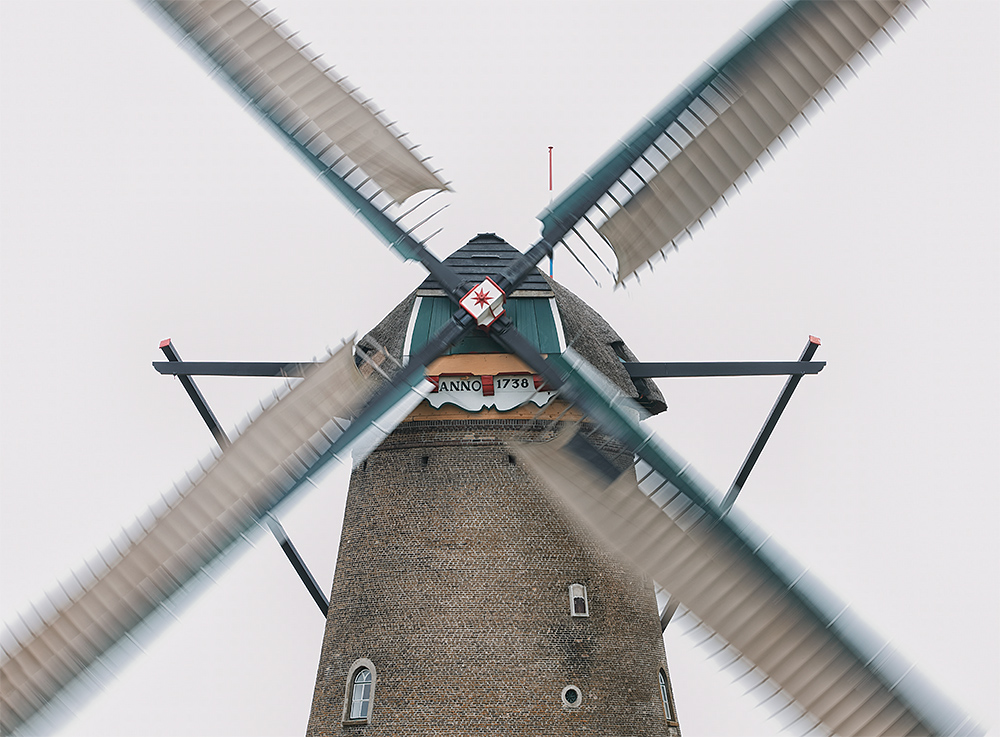
|
|
This image was created on the thankfully cloudy afternoon of April 21 at Kinderdijk, Holland with the Gitzo GT1542T Tripod, the Mongoose M3.6 head, Canon EF 70-200mm f/2.8L IS II USM lens, the Canon Extender EF 1.4X III (at 150mm), and the Canon EOS 5D Mark III. ISO 50. Evaluative metering +1 1/3 stops as framed: 1/8 sec. at f/13 in Av Mode. Color temperature: AWB.
Central sensor only Rear Focus AF on the small red star and re-compose. Click here to see the latest version of the Rear Focus Tutorial. Click on the image to see a larger version.
|
Round and Round…
The obvious choice when photographing a working windmill, that is, one with the blades rotating, is to play with blurs. It took lots of experimenting to come up with some workable techniques. The image above is a straight subject motion blur.
Thankfully Cloudy
Why thankfully cloudy? Two reasons. The main one: the windmill in this photograph was on the west side of a canal. Had it been sunny, the windmill would have been strongly backlit. At best, those difficult conditions would have required a totally different photographic approach. I am pretty sure that I would not even have tried…. In addition, working in low light makes creating pleasing blurs easier and makes for wider apertures at a given shutter speed thus resulting in fewer dust spots….
|
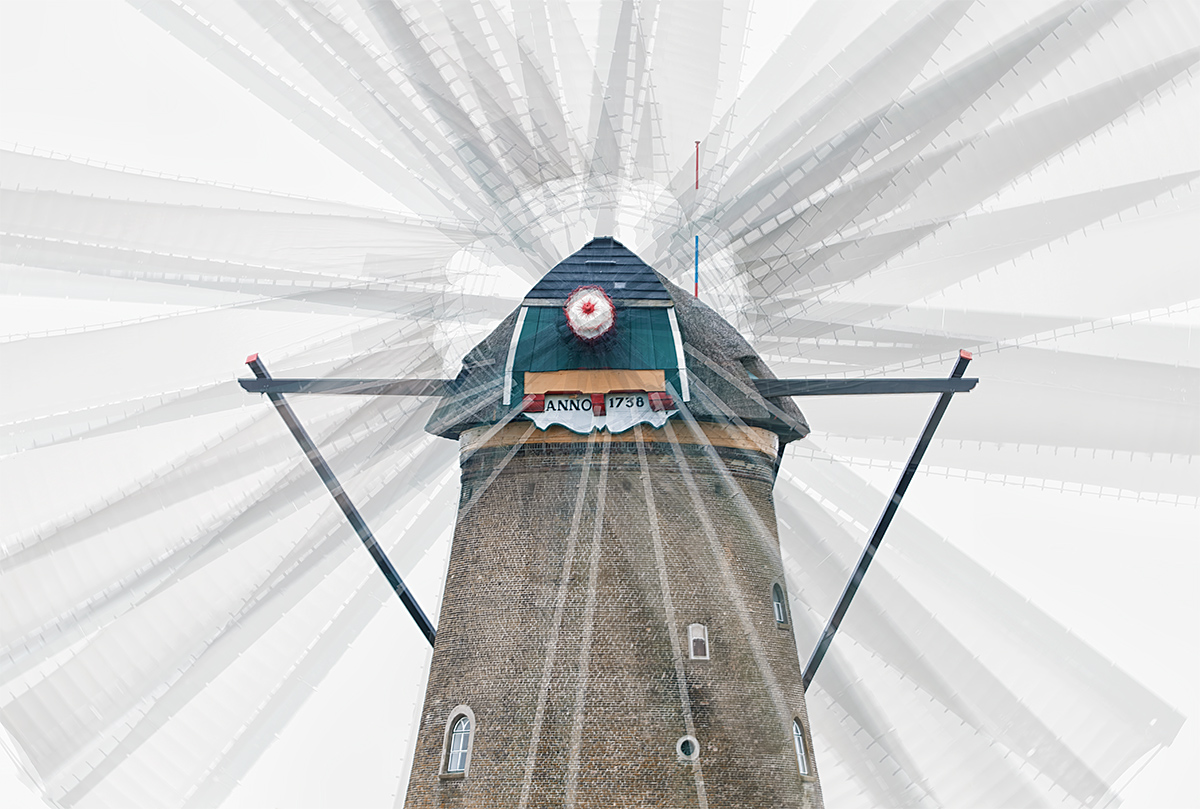
|
|
This image was also created on the thankfully cloudy afternoon of April 21 at Kinderdijk, Holland with the Gitzo GT1542T Tripod, the Mongoose M3.6 head, Canon EF 70-200mm f/2.8L IS II USM lens, the Canon Extender EF 1.4X III (at 150mm), and the Canon EOS 5D Mark III. ISO 50. Evaluative metering +1 1/3 stops as framed: 1/13 sec. at f/9 in Av Mode. Color temperature: AWB.
Central sensor only Rear Focus AF on the small red star and re-compose. Click here to see the latest version of the Rear Focus Tutorial. Click on the image to see a larger version.
|
Image Question
Put on your thinking caps and let me know how you think that I created the image above.
Your Favorite?
Please take a moment to leave a comment and let us know which of the two images here that you like best, and why.
A Guide to Pleasing Blurs
If you would like to learn more about creating pleasing blurs, check out “A Guide to Pleasing Blurs” by Denise Ippolito and yours truly. Illustrated with 144 different, exciting, inspiring, and artistic images the guide covers the basics of creating pleasingly blurred images, the factors that influence the degree of blurring, the use of filters in creating pleasing blurs, and a great variety of both in-the-field and Photoshop techniques that can be used to create the pleasingly blurred, out-of-the box images that do so well in major photographic compositions.
Canon Gear for Sale
Doug Bolt’s 400 DO sold yesterday. Doug is still offering a used EOS-5D Mark II in very good to excellent condition for $1199. There is a shallow scratch on the body and a faint smudge on the top LCD. The sale includes a RRS L-plate, a vertical grip, and the original box and all the stuff that came in it. The seller will pay shipping to US addresses only. This one is a great body for flowers and landscapes. Mine saved me on a Southern Oceans cruise when I trashed two EOS-1D Mark IV bodies in a rainstorm; it was a great back-up camera body. The item will ship only when the check clears.
Please contact Doug for additional info and/or a link to photos via e-mail or try him by phone at home: at 301-937-3112 or on his cell at 301-537-8073.
Another Used 400 DO For Sale
I will be offering a very well taken care of 400 DO lens for sale when I get back. If you are interested, please shoot me an e-mail. The lens is currently owned by Peter Kes.
|

|
|
All of the images created at the St. Augustine Alligator Farm and copyright Arthur Morris/BIRDS AS ART
From top left clockwise to center: Snowy Egret pair in breeding plumage, breeding plumage Cattle Egret with fill flash, large Great Egret chicks in the nest, killer breeding plumage Snowy Egret displaying, flash-as-main light Great Egret chick happy to see mom, Little Blue Heron chicks, Cattle Egret breeding plumage head portrait, flash flight Wood Stork with nesting material, Great Egret landing at the nest, large Snowy Egret chicks.
Click on the image to enjoy a larger version.
|
St. Augustine Alligator Farm Short-Notice IPT. 3-FULL DAYS. Early entry/Late stay. May 5-7, 2014. Meet and greet at 8pm on Sunday May 4: $1299. Two Great Leaders: Arthur Morris and Denise Ippolito
This trip needs four to run.
Breeding herons, egrets, and Wood Storks. Eggs and chicks in the nest. Some fledged young possible. Breeding behaviors including displaying and copulations. Flight and flash flight. Great Egret, Snowy Egret, Little Blue Heron, Cattle Egret, Tricolored Heron, Wood Stork. Early May rocks at the Farm as the weather is usually gorgeous and there should be lots of both small and large chicks in the nest. And you avoid the possibly oppressive heat of June and July.
Includes in-the-field instruction, early entry, late stay, $5/person late-stay gratuity, informal, small group Photoshop and image review sessions. Three lunches.
Not included: your lodging, your St. Augustine Alligator Farm photographer’s pass ($79.95 for the year); we will be more than glad to pre-order your pass for you. Please let us know when you register.
What you will learn:
How to see the good situations.
How to best avoid the clutter of a rookery by choosing the very best perspective.
How to properly evaluate the histogram and come up with the right exposure every time after making a single test exposure
How to see and understand the light.
How to to design pleasing images by mastering your camera’s AF system.
Why you must work in Manual mode 95% of the time when photographing at a rookery and how to do it.
How to evaluate and process your images.
Via intensive instruction how to use fill flash flash as main light, and Manual flash.
Flash flight techniques including the necessary use of high speed sync.
And tons more.
Please call Jim or Jen at 863-692-0906 to hold your spot with your non-refundable $299 credit card deposit and then put your check in the mail along with your signed registration form; you can find the form here.
Suitable airports: Jacksonville (JAX), Daytona Beach (DAB), Orlando MCO).
We look forward to seeing you in the nation’s oldest city for three days of fun and learning.
|

|
|
Join me at Gatorland for a ton of learning. If you want to learn to use your flash, you will not want to miss this one. Click on the composite image to enjoy a larger version. Click on the composite to enjoy the larger size.
|
The Gatorland Short Notice Saturday Full-Day In-the-Field Workshop
Saturday May 3, 2014. 7:15am till 10:15am & 4:00pm till dusk. Lunch, image review, and Photoshop session included. Limit 6. A very small group is again likely: $399.
The cost of your Gatorland Photographer’s Pass is not included.
Chicks in nests likely. Breeding plumage Cattle and Snowy Egrets. And tons more. You will learn to spot the good situations, to choose the best perspective, to see and understand the light, to get the right exposure every time after making a single test exposure, and to design pleasing images by mastering your camera’s AF system. A big part of the above is that you will learn how and why you must work in Manual mode 90% of the time at Gatorland.
At lunch we will review my images, take a look at five of your best images from the morning session (for those who opt to bring their laptops), and process a few of my images in Photoshop after converting them in DPP. That followed by Instructor Nap Time. Last Saturday all 3 folks had a great time and learned a ton.
Payment in full via credit card is due upon registering. Please call Jim or Jennifer at 863-692-0906 to register.
Support the BAA Blog. Support the BAA Bulletins: Shop B&H here!
We want and need to keep providing you with the latest free information, photography and Photoshop lessons, and all manner of related information. Show your appreciation by making your purchases immediately after clicking on any of our B&H or Amazon Affiliate links in this blog post. Remember, B&H ain’t just photography!
….. …..
Typos
In all blog posts and Bulletins, feel free to e-mail or to leave a comment regarding any typos, wrong words, misspellings, omissions, or grammatical errors. Just be right. 🙂
April 22nd, 2014
The Streak Continues: 144
I published this post at 6:00am Amsterdam time; that is noon on the east coast. We enjoyed a great morning at Keukenhof and then had too much fun photographing the windmills and Great Crested Grebes at Kinderdijk.
This post marks 144 straight days with a new blog post. With so many folks getting in the habit of using our B&H links and our Amazon logo-links why quit now? To show your appreciation for my efforts here, we do ask that you use our the B&H and Amazon affiliate links on the right side of the blog for all of your purchases. Please check the availability of all photographic accessories in the BIRDS AS ART Online Store, especially Gitzo tripods, Wimberley tripod heads, and the like. We sell only what I used, tested, and can depend on. We will not sell you junk. We know what you need to make creating great images easy and fun. And we are always glad to answer your gear questions via e-mail.
You can find the following items in the store: Gitzo tripods, Mongoose M3.6 and Wimberley heads, plates, low feet, and accessories, flash brackets, , Delkin e-film Pro Compact Flash Cards, LensCoat products, and our unique line-up of educational materials including ABP I & II, Digital Basics, Site and Set-up e-Guides, Canon and Nikon Camera Users and AF e-Guides, and MP-4 Photoshop video tutorials among others.
I would of course appreciate your using our B&H affiliate links for all of your major gear, video, and electronic purchases. For the photographic stuff mentioned in the paragraph above we, meaning BAA, would of course greatly appreciate your business. Here is a huge thank you to the many who have been using our links on a regular basis and visiting the BAA Online store as well.
This blog post took 2 hours to put together. Enjoy!
One of My Very Favorite Wading Bird Species
One of my very favorite wading bird species is Cattle Egret. They are handsome even in their winter or non-breeding garb but when they are decked out in full breeding plumage they are a sight to be seen with their rich buff crests and all that magenta, cherry red, and yellow on or around their faces and those bright pink legs and feet. St. Augustine Alligator Farm in early May is prime time for photographing this species which usually begins nesting much later than Snowy and Great Egrets and the Tricolored Herons. There is a good chance that the Snowy Egrets will have chick in the nest. The Great Egrets will have both large and fledged chicks.
Image Question
What is the single-most distracting element in this image?
Relatively Distant Backgrounds
As we saw at Keukenhof this morning using a longer lens with a teleconverter and searching for tulips with relatively distant backgrounds, from 2 to ten feet or so behind an individual flower is a great way to isolate your subjects against clean backgrounds. And that is just what I did here. Though it has been a very years since I visited St. Augustine, one of the things that I always liked about it was that there were always a lot more isolated perches there than at Gatorland….
White Sky Flight
I love using flash on white sky days or at dusk for flight photography. When you get a good one it can look like a studio shot. Join us on the St. Augustine Alligator Farm and learn how to create images like this, and to avoid the clutter of rookeries….
Your Favorite?
Please take a moment to leave a comment and let us know which of today’s 3 images you like best. And be sure to let us know why.
Canon Gear for Sale
Doug Bolt is offering a used Canon 400mm f/4L IS DO lens in very good to excellent condition for $4599. The sale includes the lens trunk and lens cover; the seller will pay shipping to US addresses only. This one should sell in minutes to someone looking for a lightweight super-telephoto. The item will ship only when the check clears.
Please contact Doug for additional info and/or a link to photos via e-mail or try him by phone at home: at 301-937-3112 or on his cell at 301-537-8073.
Doug is also offering a used EOS-5D Mark II in very good to excellent condition for $1199. There is a shallow scratch on the body and a faint smudge on the top LCD. The sale includes a RRS L-plate, a vertical grip, and the original box and all the stuff that came in it. The seller will pay shipping to US addresses only. This one is a great body for flowers and landscapes. Mine saved me on a Southern Oceans cruise when I trashed two EOS-1D Mark IV bodies in a rainstorm; it was a great back-up camera body. The item will ship only when the check clears.
Again, please contact Doug for additional info and/or a link to photos via e-mail or try him by phone at home: at 301-937-3112 or on his cell at 301-537-8073.
|

|
|
All of the images created at the St. Augustine Alligator Farm and copyright Arthur Morris/BIRDS AS ART
From top left clockwise to center: Snowy Egret pair in breeding plumage, breeding plumage Cattle Egret with fill flash, large Great Egret chicks in the nest, killer breeding plumage Snowy Egret displaying, flash-as-main light Great Egret chick happy to see mom, Little Blue Heron chicks, Cattle Egret breeding plumage head portrait, flash flight Wood Stork with nesting material, Great Egret landing at the nest, large Snowy Egret chicks.
Click on the image to enjoy a larger version.
|
St. Augustine Alligator Farm Short-Notice IPT. 3-FULL DAYS. Early entry/Late stay. May 5-7, 2014. Meet and greet at 8pm on Sunday May 4: $1299. Two Great Leaders: Arthur Morris and Denise Ippolito
This trip needs four to run.
Breeding herons, egrets, and Wood Storks. Eggs and chicks in the nest. Some fledged young possible. Breeding behaviors including displaying and copulations. Flight and flash flight. Great Egret, Snowy Egret, Little Blue Heron, Cattle Egret, Tricolored Heron, Wood Stork. Early May rocks at the Farm as the weather is usually gorgeous and there should be lots of both small and large chicks in the nest. And you avoid the possibly oppressive heat of June and July.
Includes in-the-field instruction, early entry, late stay, $5/person late-stay gratuity, informal, small group Photoshop and image review sessions. Three lunches.
Not included: your lodging, your St. Augustine Alligator Farm photographer’s pass ($79.95 for the year); we will be more than glad to pre-order your pass for you. Please let us know when you register.
What you will learn:
How to see the good situations.
How to best avoid the clutter of a rookery by choosing the very best perspective.
How to properly evaluate the histogram and come up with the right exposure every time after making a single test exposure
How to see and understand the light.
How to to design pleasing images by mastering your camera’s AF system.
Why you must work in Manual mode 95% of the time when photographing at a rookery and how to do it.
How to evaluate and process your images.
Via intensive instruction how to use fill flash flash as main light, and Manual flash.
Flash flight techniques including the necessary use of high speed sync.
And tons more.
Please call Jim or Jen at 863-692-0906 to hold your spot with your non-refundable $299 credit card deposit and then put your check in the mail along with your signed registration form; you can find the form here.
Suitable airports: Jacksonville (JAX), Daytona Beach (DAB), Orlando MCO).
We look forward to seeing you in the nation’s oldest city for three days of fun and learning.
|

|
|
Join me at Gatorland for a ton of learning. If you want to learn to use your flash, you will not want to miss this one. Click on the composite image to enjoy a larger version. Click on the composite to enjoy the larger size.
|
The Gatorland Short Notice Saturday Full-Day In-the-Field Workshop
Saturday May 3, 2014. 7:15am till 10:15am & 4:00pm till dusk. Lunch, image review, and Photoshop session included. Limit 6. A very small group is again likely: $399.
The cost of your Gatorland Photographer’s Pass is not included.
Chicks in nests likely. Breeding plumage Cattle and Snowy Egrets. And tons more. You will learn to spot the good situations, to choose the best perspective, to see and understand the light, to get the right exposure every time after making a single test exposure, and to design pleasing images by mastering your camera’s AF system. A big part of the above is that you will learn how and why you must work in Manual mode 90% of the time at Gatorland.
At lunch we will review my images, take a look at five of your best images from the morning session (for those who opt to bring their laptops), and process a few of my images in Photoshop after converting them in DPP. That followed by Instructor Nap Time. Last Saturday all 3 folks had a great time and learned a ton.
Payment in full via credit card is due upon registering. Please call Jim or Jennifer at 863-692-0906 to register.
Support the BAA Blog. Support the BAA Bulletins: Shop B&H here!
We want and need to keep providing you with the latest free information, photography and Photoshop lessons, and all manner of related information. Show your appreciation by making your purchases immediately after clicking on any of our B&H or Amazon Affiliate links in this blog post. Remember, B&H ain’t just photography!
….. …..
Typos
In all blog posts and Bulletins, feel free to e-mail or to leave a comment regarding any typos, wrong words, misspellings, omissions, or grammatical errors. Just be right. 🙂
April 21st, 2014
The Streak Continues: 143
I published this post at 6:30am Amsterdam time, 12:30 in the morning on the east coast. We enjoyed a great morning of flower field photography
This post marks 143 straight days with a new blog post. With so many folks getting in the habit of using our B&H links and our Amazon logo-links why quit now? To show your appreciation for my efforts here, we do ask that you use our the B&H and Amazon affiliate links on the right side of the blog for all of your purchases. Please check the availability of all photographic accessories in the BIRDS AS ART Online Store, especially Gitzo tripods, Wimberley tripod heads, and the like. We sell only what I used, tested, and can depend on. We will not sell you junk. We know what you need to make creating great images easy and fun. And we are always glad to answer your gear questions via e-mail.
You can find the following items in the store: Gitzo tripods, Mongoose M3.6 and Wimberley heads, plates, low feet, and accessories, flash brackets, , Delkin e-film Pro Compact Flash Cards, LensCoat products, and our unique line-up of educational materials including ABP I & II, Digital Basics, Site and Set-up e-Guides, Canon and Nikon Camera Users and AF e-Guides, and MP-4 Photoshop video tutorials among others.
I would of course appreciate your using our B&H affiliate links for all of your major gear, video, and electronic purchases. For the photographic stuff mentioned in the paragraph above we, meaning BAA, would of course greatly appreciate your business. Here is a huge thank you to the many who have been using our links on a regular basis and visiting the BAA Online store as well.
This blog post took 1 1/2 hours to put together. Enjoy!
|
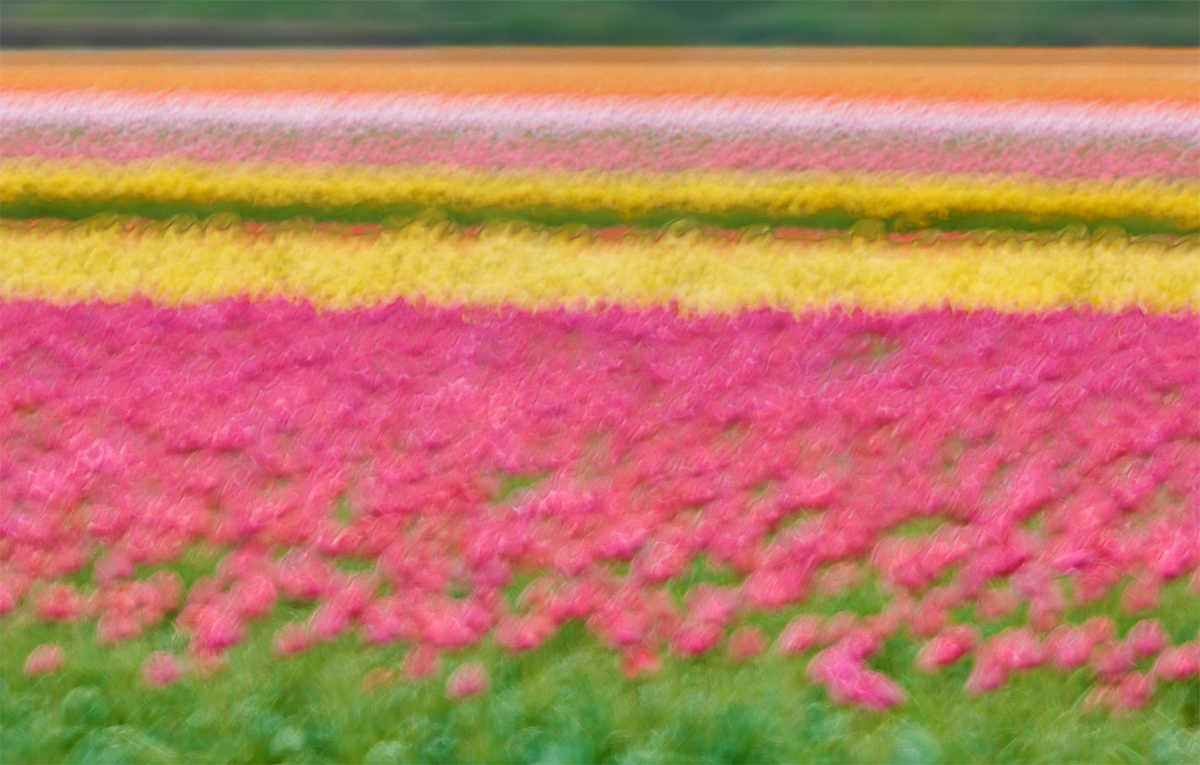
|
|
This in-camera HDR Art Vivid image was created at the tulip fields across from the Main Entrance to Keukenhof Gardens, Lisse, Holland (The Netherlands) with the Gitzo GT1542T Tripod, the Mongoose M3.6 head, the Canon EF 70-200mm f/2.8L IS II USM Lens, the Canon Extender EF 2X III (at 205mm), and the and the Canon EOS 5D Mark III. ISO 400. Evaluative metering +2 stops as framed left a base exposure of 6/10 sec. at f/29 in Tv Mode. Color temperature: 4000. To get a good histogram with Art Vivid you need to add a lot more light than you would when creating straight blurs and even when using HDR Natural images.
Central sensor/AI Servo/Surround Rear Focus AF on the pink flowers, re-compose, and shake the lens. Click here to see the latest version of the Rear Focus Tutorial. Click on the image to see a larger version.
Image #1: Child’s Play
|
Trying New Things
After entering Kuekenhof on the sunny Saturday morning of April 19th, I asked if anyone in the group would like to take the long walk from the Extra Entrance to the Main Entrance. First-timer Terry Jackson and multiple IPT veteran Mike Gotthelf joined me for the hike. We wound up trapped by a series of canals on the wrong side of the light. My bad. But we persisted and eventually wound up in the right spot.
Most in our group of 8 have enjoyed learning to create a variety of pleasing blurs. These techniques work well when photographing the amazing flower fields. Mike in particular has had great success in creating horizontal pan blurs. After a while, he experimented with shaking the camera rather violently during the long exposures in a manner similar to the Jiggle Technique that Denise Ippolito has been teaching folks for years. Mike named this twist on her technique “Shake and Bake.” With the image framed and the tripod head locked up you grab the camera and shake it forcefully during the exposure. Then we took things a step further by using the same technique while creating in-camera HDR Art Vivid images.
5D Mark III User’s Guide
You can learn the fine point of creating in-camera HDRs and in-camera Multiple Exposures plus everything that I know about this great camera in my 5D Mark III User’s Guide here.
Get a Free Copy of Our 5D Mark III User’s Guide
Purchase a Canon EOS-5D Mark III using one of our product-specific B&H affiliate links above or by clicking on the logo link below and shoot me your B&H receipt via e-mail. Once and if the purchase appears in my account–it should unless you screwed up somehow and did not use the link :), I will be glad to have Jim send you a free copy of our 5D Mark III User’s Guide.
Flowers are Red
The image above was a result of our willingness to experiment with new things, to think out of the box. The image reminds me of something a four-year old might create when asked to paint flowers.
I have long loved Harry Chapin and his story songs but the first time that I heard Flowers are Red I had hoped for an ending that would shed a more positive light on teachers…. You can click on the link to hear the song. Not all teachers insisted in rigid conformity. If you had a teacher in grade school who inspired you to be creative, please feel free to share that story here.
“Flowers are Red” Lyrics from the Harry Chapin Archives.
“The little boy went first day of school
He got some crayons and started to draw
He put colors all over the paper
For colors was what he saw
And the teacher said.. What you doin’ young man
I’m paintin’ flowers he said
She said… It’s not the time for art young man
And anyway flowers are green and red
There’s a time for everything young man
And a way it should be done
You’ve got to show concern for everyone else
For you’re not the only one
And she said…
Flowers are red young man
Green leaves are green
There’s no need to see flowers any other way
Than they way they always have been seen
But the little boy said…
There are so many colors in the rainbow
So many colors in the morning sun
So many colors in the flower and I see every one
Well the teacher said.. You’re sassy
There’s ways that things should be
And you’ll paint flowers the way they are
So repeat after me…..
And she said…
Flowers are red young man
Green leaves are green
There’s no need to see flowers any other way
Than they way they always have been seen
But the little boy said…
There are so many colors in the rainbow
So many colors in the morning sun
So many colors in the flower and I see every one
The teacher put him in a corner
She said.. It’s for your own good..
And you won’t come out ’til you get it right
And are responding like you should
Well finally he got lonely
Frightened thoughts filled his head
And he went up to the teacher
And this is what he said.. and he said
Flowers are red, green leaves are green
There’s no need to see flowers any other way
Than the way they always have been seen
Time went by like it always does
And they moved to another town
And the little boy went to another school
And this is what he found
The teacher there was smilin’
She said…Painting should be fun
And there are so many colors in a flower
So let’s use every one
But that little boy painted flowers
In neat rows of green and red
And when the teacher asked him why
This is what he said.. and he said
Flowers are red, green leaves are green
There’s no need to see flowers any other way
Than the way they always have been seen.”
|
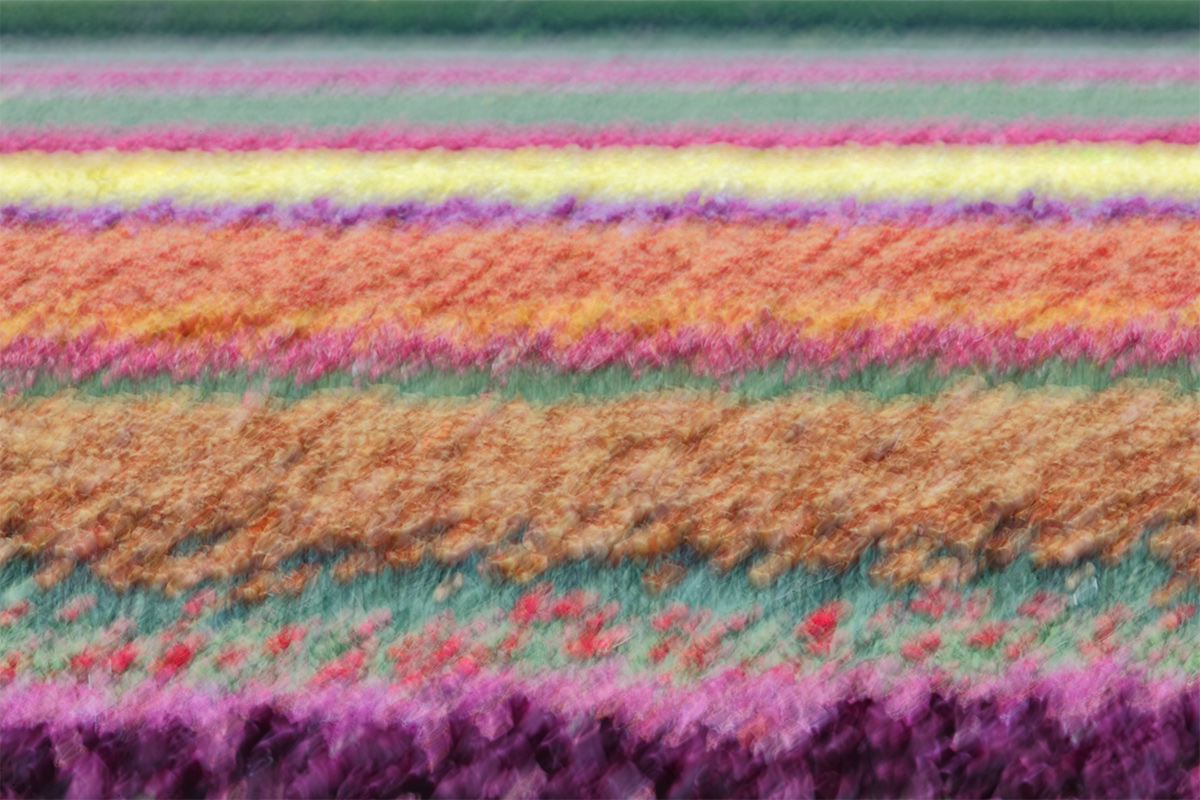
|
|
This image was created on the afternoon of, April 20 at Keukenhof Gardens, Lisse, Holland (The Netherlands) with the Gitzo GT1542T Tripod, the Mongoose M3.6 head, the Canon EF 300mm f/2.8L IS II USM lens, the Canon Extender EF 2X III, and the and the Canon EOS 5D Mark III. ISO 400. Evaluative metering +1 stop as framed: 1/6 sec. at f/45 in Av Mode. Color temperature: 4000K.
Central sensor/AI Servo/Surround Rear Focus AF on the first row of gold flowers, re-compose, and pan. Click here to see the latest version of the Rear Focus Tutorial. Click on the image to see a larger version.
Image #2: Painterly
|
Children at Play
That afternoon Mike and his wife Barbara went in search of a spot to photograph the flower fields adjacent to the eastern border of Keukenhof. We were eventually successful. For the most part we worked on honing the techniques that we had developed and tried but we did try some different stuff. Most of which failed. Mike and I both felt like little kids at play as we looked at one exciting image after another on the LCDs on the back of our cameras. While reviewing my images I found some gems in the HDR series. You can set up your 5D Mark III to save the three RAW files when creating in-camera HDR series; the final result is a 61-megabyte JPEG that can be opened in Photoshop and immediately be saved as a TIFF to avoid the problem of image quality deterioration that you run into when repeatedly saving an image as a JPEG.
A Guide to Pleasing Blurs
If you would like to learn more about creating pleasing blurs, check out “A Guide to Pleasing Blurs” by Denise Ippolito and yours truly. Illustrated with 144 different, exciting, inspiring, and artistic images the guide covers the basics of creating pleasingly blurred images, the factors that influence the degree of blurring, the use of filters in creating pleasing blurs, and a great variety of both in-the-field and Photoshop techniques that can be used to create the pleasingly blurred, out-of-the box images that do so well in major photographic compositions.
Your Favorite?
Please take a moment to leave a comment and let us know which of the two images here (if either) that you like best, and why.
Canon Gear for Sale
Doug Bolt is offering a used Canon 400mm f/4L IS DO lens in very good to excellent condition for $4599. The sale includes the lens trunk and lens cover; the seller will pay shipping to US addresses only. This one should sell in minutes to someone looking for a lightweight super-telephoto. The item will ship only when the check clears.
Please contact Doug for additional info and/or a link to photos via e-mail or try him by phone at home: at 301-937-3112 or on his cell at 301-537-8073.
Doug is also offering a used EOS-5D Mark II in very good to excellent condition for $1199. There is a shallow scratch on the body and a faint smudge on the top LCD. The sale includes a RRS L-plate, a vertical grip, and the original box and all the stuff that came in it. The seller will pay shipping to US addresses only. This one is a great body for flowers and landscapes. Mine saved me on a Southern Oceans cruise when I trashed two EOS-1D Mark IV bodies in a rainstorm; it was a great back-up camera body. The item will ship only when the check clears.
Again, please contact Doug for additional info and/or a link to photos via e-mail or try him by phone at home: at 301-937-3112 or on his cell at 301-537-8073.
|

|
|
Join me at Gatorland for a ton of learning. If you want to learn to use your flash, you will not want to miss this one. Click on the composite image to enjoy a larger version. Click on the composite to enjoy the larger size.
|
Another Gatorland Short Notice Saturday Full-Day In-the-Field Workshop
Saturday May 3, 2014. 7:15am till 10:15am & 4:00pm till dusk. Lunch, image review, and Photoshop session included. Limit 6. A very small group is again likely: $399.
The cost of your Gatorland Photographer’s Pass is not included.
Chicks in nests likely. Breeding plumage Cattle and Snowy Egrets. And tons more. You will learn to spot the good situations, to choose the best perspective, to see and understand the light, to get the right exposure every time after making a single test exposure, and to design pleasing images by mastering your camera’s AF system. A big part of the above is that you will learn how and why you must work in Manual mode 90% of the time at Gatorland.
At lunch we will review my images, take a look at five of your best images from the morning session (for those who opt to bring their laptops), and process a few of my images in Photoshop after converting them in DPP. That followed by Instructor Nap Time. Last Saturday all 3 folks had a great time and learned a ton. And the weather for this coming Saturday is looking good.
Payment in full via credit card is due upon registering. Please call Jim or Jennifer at 863-692-0906 to register.
Support the BAA Blog. Support the BAA Bulletins: Shop B&H here!
We want and need to keep providing you with the latest free information, photography and Photoshop lessons, and all manner of related information. Show your appreciation by making your purchases immediately after clicking on any of our B&H or Amazon Affiliate links in this blog post. Remember, B&H ain’t just photography!
….. …..
Typos
In all blog posts and Bulletins, feel free to e-mail or to leave a comment regarding any typos, wrong words, misspellings, omissions, or grammatical errors. Just be right. 🙂
April 20th, 2014
The Streak Continues: 142
I published this post at 6:15am Amsterdam time, just after midnight on the east coast. We enjoyed yet another great day of photography at Keukenhof and the nearby tulip fields.
This post marks 142 straight days with a new blog post. With so many folks getting in the habit of using our B&H links and our Amazon logo-links why quit now? To show your appreciation for my efforts here, we do ask that you use our the B&H and Amazon affiliate links on the right side of the blog for all of your purchases. Please check the availability of all photographic accessories in the BIRDS AS ART Online Store, especially Gitzo tripods, Wimberley tripod heads, and the like. We sell only what I used, tested, and can depend on. We will not sell you junk. We know what you need to make creating great images easy and fun. And we are always glad to answer your gear questions via e-mail.
You can find the following items in the store: Gitzo tripods, Mongoose M3.6 and Wimberley heads, plates, low feet, and accessories, flash brackets, , Delkin e-film Pro Compact Flash Cards, LensCoat products, and our unique line-up of educational materials including ABP I & II, Digital Basics, Site and Set-up e-Guides, Canon and Nikon Camera Users and AF e-Guides, and MP-4 Photoshop video tutorials among others.
I would of course appreciate your using our B&H affiliate links for all of your major gear, video, and electronic purchases. For the photographic stuff mentioned in the paragraph above we, meaning BAA, would of course greatly appreciate your business. Here is a huge thank you to the many who have been using our links on a regular basis and visiting the BAA Online store as well.
This blog post took 1 1/2 hours to put together. Enjoy!
|
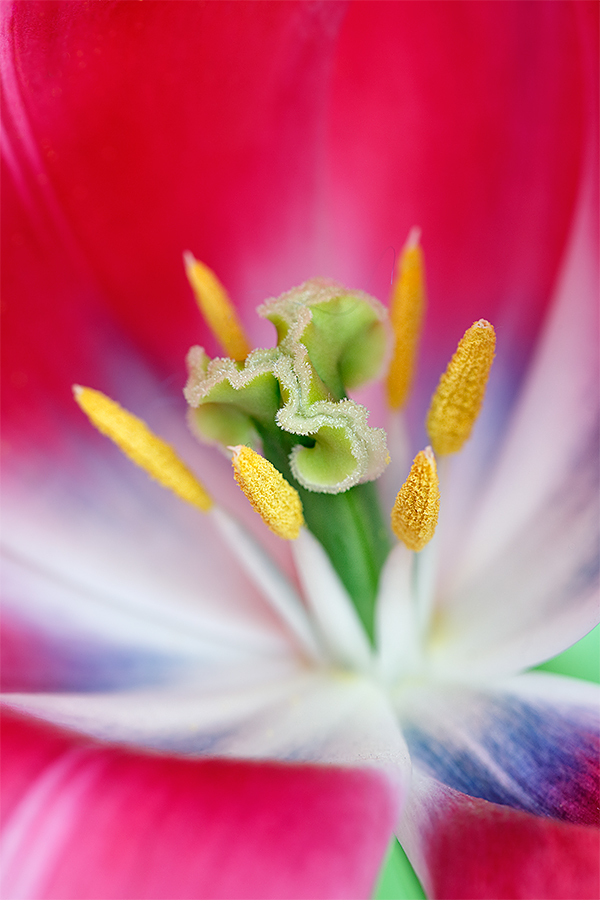
|
|
This image was created yesterday, midday on a mostly sunny April 19, at Keukenhof Gardens with the Gitzo GT1542T Tripod, the Mongoose M3.6 head, the Canon EF 180mm f/3.5L Macro USM lens and the Canon EOS 5D Mark III. ISO 400. Evaluative metering +1 stop as framed: 1/40 sec. at f/7.1 in Av Mode. Color temperature: 5000.
Central sensor only Rear Focus AF on the tip top of the pistil. Click here to see the latest version of the Rear Focus Tutorial. Click on the image to see a larger version.
|
Damaged Goods a Big Plus
As I believe that I mentioned here previously, many of the tulip beds in the Willem-Alexander Pavilion at Keukenhof Gardens have either been cut or feature flowers well past their prime. In many instances, this has proven to be a huge plus for flower photography. With a single damaged petal it is possible, with the right perspective, to see into the center of the flower. As a tulip nears the end of its days, many of the petals flop down. This often leaves spectacular (as above) views of the flower centers that are almost always still pristine.
All that you need to do is choose the right flower and the right perspective and you are in business.
The Canon 180mm Macro Lens
While I have been going more and more to the far lighter Canon EF 100mm f/2.8L Macro IS USM lens, there are times when the reach of the 180 macro can save the day. In fact, I often use the 180 with either the 1.4X TC or with a TC/extension tube combo.
|

|
|
|
|
Fort DeSoto in spring is rich with tame birds. With many in breeding plumage it is a photographer’s paradise. I hope that you can join me there in mid-May.
|
Short Notice Fort DeSoto IPT/In-the-Field Workshops: May 9, 10, & 11, 2014
IPT–3 FULL DAYs: $1099
In-the-Field Workshops: $399/day
Fort DeSoto in spring is so good that I needed to create two cards in order to give folks an idea of what is possible. Even then I have barely scratched the surface. If you are coming from out of town you will surely want to do all 3 days, the entire IPT. Local folks may wish to join me for one or more full days.
There will Lots of tame birds including breeding plumage Laughing Gull and Royal and Sandwich Terns courting and copulating. American Oystercatcher plus lots of sandpipers and plovers, some in breeding plumage. Red Knot in breeding plumage likely. Lots of wading birds including Great and Snowy Egrets, both color morphs of Reddish Egret, Great Blue, Tricolored and Little Blue Heron, and Yellow-crowned Night-Heron. Roseate Spoonbill and WOod Stork between possible and likely…. Lots of flight photography with the gulls and terns and with Brown Pelican.
You will learn how to approach free and wild birds without disturbing them, to understand and predict bird behavior, to identify many species of shorebirds, to spot the good situations, to choose the best perspective, to see and understand the light, to get the right exposure every time after making a single test exposure, and to design pleasing images by mastering your camera’s AF system. And you will learn learn how and why to work in Manual mode (even if you are scared of it).
At lunch we will review my images–folks learn a ton watching me edit–why keep this one and delete that one. If you opt to bring your laptop, we will take a look at five of your best images from the morning session. We will process a few of my images in Photoshop after converting them in DPP. That followed by Instructor Nap Time.
This is the IPT hotel: Comfort Inn St. Petersburg, FL. 2260 54th Ave N., St. Petersburg, FL 33714. tel: 1-727-362-0075. The best airport is Tampa (TPA).
Payment in full via credit card is due upon registering. Please call Jim or Jennifer at 863-692-0906 to register.
|

|
|
Fort DeSoto in spring is rich with tame birds. With many in breeding plumage it is a photographer’s paradise. I hope that you can join me there in mid-May.
|
Fort DeSoto Site Guide
Can’t make it in mid-May? Get yourself a copy of the Fort DeSoto Site Guide. Learn the best spots, where to be when in what season in what weather. Learn the best wind directions for the various locations. BAA Site Guides are the next best thing to being on an IPT. You can see all of them here.
Shorebirds/Beautiful Beachcombers
If the shorebirds in the ID quiz gave you pause, get yourself a copy of my Shorebirds/Beautiful Beachcombers. Includes ID tips, shorebird biology, migration, and tons more. All in my simple-to-read easy-to-read style.
Canon Gear for Sale
Doug Bolt is offering a used Canon 400mm f/4L IS DO lens in very good to excellent condition for $4599. The sale includes the lens trunk and lens cover; the seller will pay shipping to US addresses only. This one should sell in minutes to someone looking for a lightweight super-telephoto. The item will ship only when the check clears.
Please contact Doug for additional info and/or a link to photos via e-mail or try him by phone at home: at 301-937-3112 or on his cell at 301-537-8073.
Doug is also offering a used EOS-5D Mark II in very good to excellent condition for $1199. There is a shallow scratch on the body and a faint smudge on the top LCD. The sale includes a RRS L-plate, a vertical grip, and the original box and all the stuff that came in it. The seller will pay shipping to US addresses only. This one is a great body for flowers and landscapes. Mine saved me on a Southern Oceans cruise when I trashed two EOS-1D Mark IV bodies in a rainstorm; it was a great back-up camera body. The item will ship only when the check clears.
Again, please contact Doug for additional info and/or a link to photos via e-mail or try him by phone at home: at 301-937-3112 or on his cell at 301-537-8073.
Support the BAA Blog. Support the BAA Bulletins: Shop B&H here!
We want and need to keep providing you with the latest free information, photography and Photoshop lessons, and all manner of related information. Show your appreciation by making your purchases immediately after clicking on any of our B&H or Amazon Affiliate links in this blog post. Remember, B&H ain’t just photography!
….. …..
Typos
In all blog posts and Bulletins, feel free to e-mail or to leave a comment regarding any typos, wrong words, misspellings, omissions, or grammatical errors. Just be right. 🙂
April 19th, 2014 The Streak Continues: 141
I will be publishing this post just after 6:00am Amsterdam time, about noon on the east coast. We enjoyed another great day of photography at Keukenhof and the nearby tulip fields.
This post marks 141 straight days with a new blog post. With so many folks getting in the habit of using our B&H links and our Amazon logo-links why quit now? To show your appreciation for my efforts here, we do ask that you use our the B&H and Amazon affiliate links on the right side of the blog for all of your purchases. Please check the availability of all photographic accessories in the BIRDS AS ART Online Store, especially Gitzo tripods, Wimberley tripod heads, and the like. We sell only what I used, tested, and can depend on. We will not sell you junk. We know what you need to make creating great images easy and fun. And we are always glad to answer your gear questions via e-mail.
You can find the following items in the store: Gitzo tripods, Mongoose M3.6 and Wimberley heads, plates, low feet, and accessories, flash brackets, , Delkin e-film Pro Compact Flash Cards, LensCoat products, and our unique line-up of educational materials including ABP I & II, Digital Basics, Site and Set-up e-Guides, Canon and Nikon Camera Users and AF e-Guides, and MP-4 Photoshop video tutorials among others.
I would of course appreciate your using our B&H affiliate links for all of your major gear, video, and electronic purchases. For the photographic stuff mentioned in the paragraph above we, meaning BAA, would of course greatly appreciate your business. Here is a huge thank you to the many who have been using our links on a regular basis and visiting the BAA Online store as well.
This blog post took 1 1/2 hours to put together. Enjoy!
|
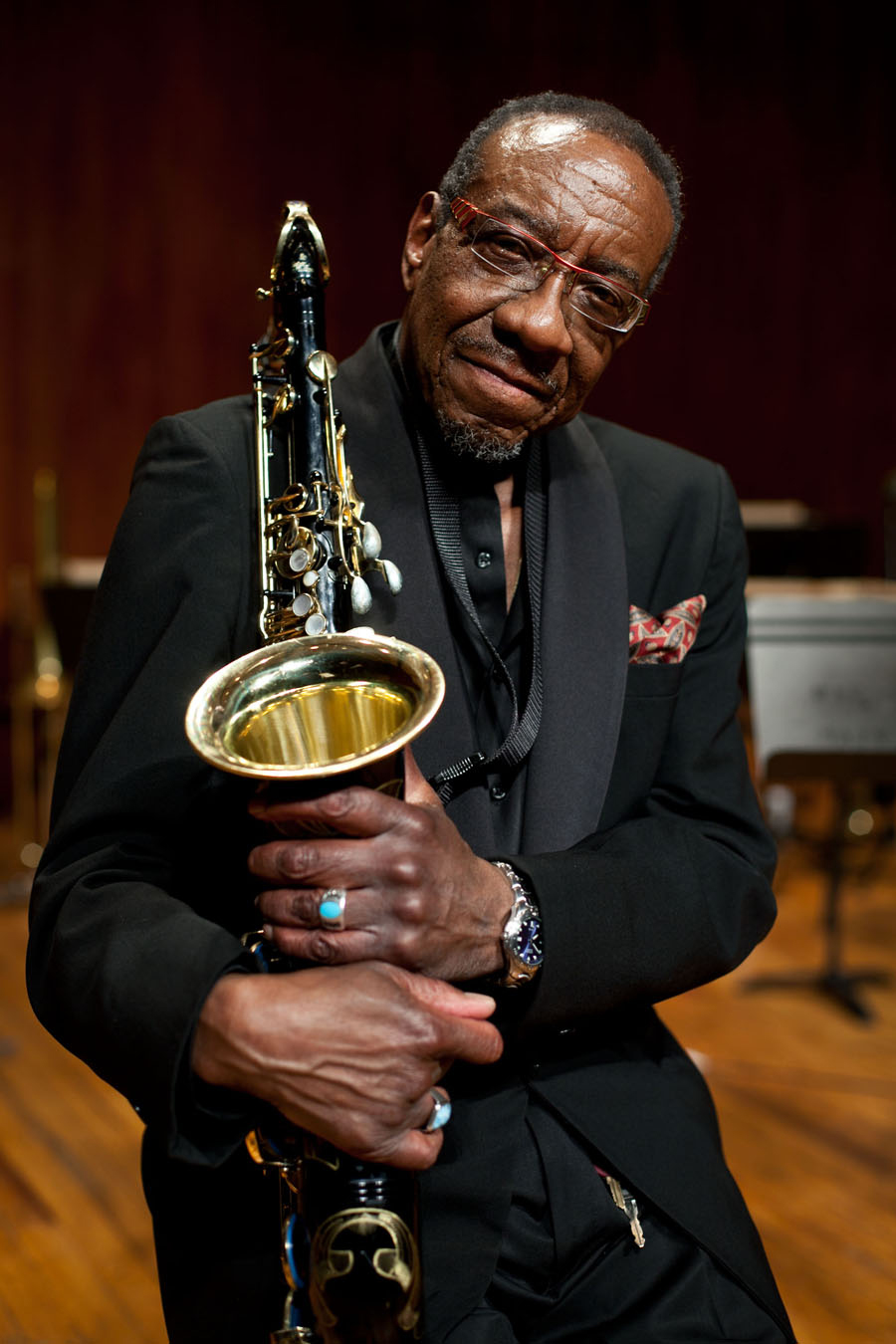
|
|
Arni Cheatham at work. Image by by Kayana Szymczak.
|
Press Release
Tammis Coffin, Education Coordinator
Museum of American Bird Art at Mass Audubon/Connecting People & Nature through Art
781-821-8853 x101 / 963 Washington St, Canton MA 02021
Bird Lives by Boston Jazz Hero Arni Cheatham
Bird Photography – Jazz Improvisation – Storytelling April 27
CANTON, MA – The Museum of American Bird Art (MABA) at Mass Audubon hosts Arni Cheatham’s performance of Bird Lives on Sunday afternoon, April 27 as part of their spring series titled “Travels with the Bird Artists.” Cheatham’s performance fuses his bird photography and stories with jazz improvisation in a museum setting of silkscreen prints of birds and habitats around the world. Bird Lives is an interwoven tapestry of stories, large format projected images and music presented by multi-talented artist Arni Cheatham. Named last year’s “Boston Jazz Hero” by the Jazz Journalists Association, Cheatham finds inspiration for his photography, stories and music near Boston and beyond. Below, MABA shares a brief interview with the artist about his upcoming performance, along with ticket information.
How do you get started with music?
I’ve been playing Jazz since my teens. Matter of fact I bought my first tenor saxophone while in High School and performed in many venues before my 21st birthday. My musical tastes have always run the gamut from blues, bebop and gospel, to Trane, Ornette and Free Jazz.
How about photography?
I was hooked on photography at an early age. My father was a serious shutterbug who loved photographing with his Yashicamat and Rolleiflex TLR cameras. He gave me my own Kodak Pony 135. As a teen, I worked part time with my dad at a photo reproduction company in Chicago and he educated me in the nuances that make an image great. Later, I began to investigate landscape and nature photography.
|
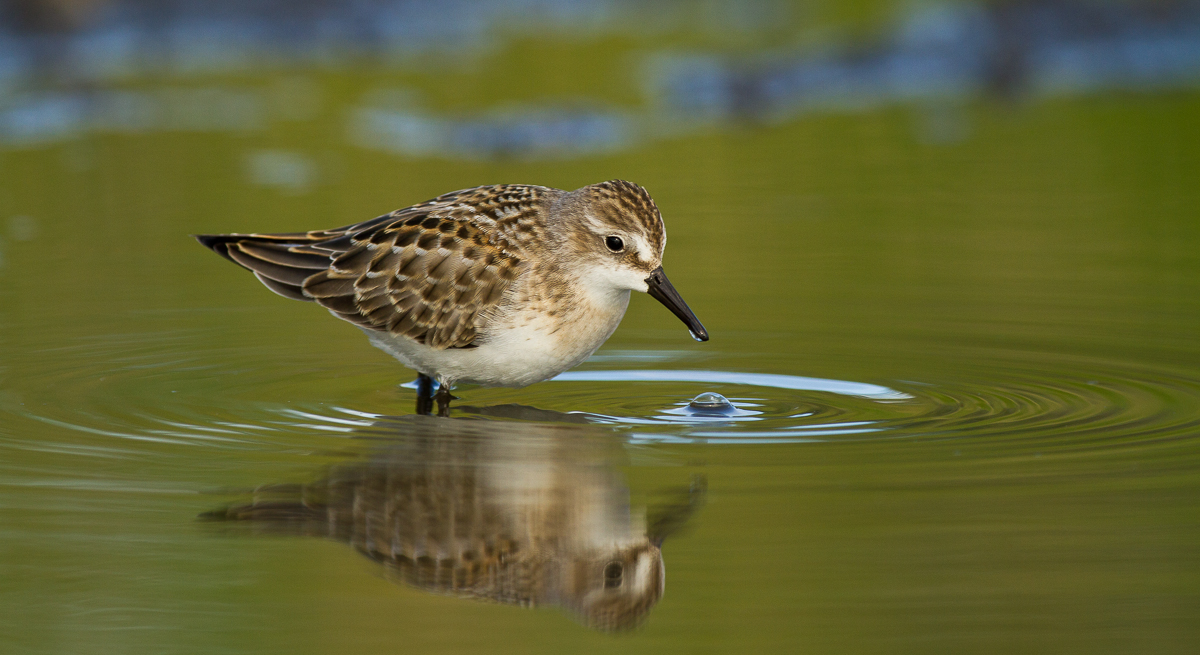
|
|
Juvenile Semipamated Sandpiper, image courtesy of and copyright Arni Cheatham.
|
What about birds?
As for bird photography, I’d looked longingly at the wonderful work of Arthur Morris over and over until I finally broke down in 1999 and acquired a Canon EOS-3 and a Canon 100-400mm lens. For the first time I had enough “reach” to begin to experiment with bird photography. The ball really got rolling in late 2004 with the advent of the Canon 20D DSLR. At last with the increased capacity of the CF card storage media, I could afford to take the many images on an outing that bird photography really requires. This is not to put an undue emphasis on equipment because equipment doesn’t take photographs on its own, however bird work in particular does have its minimum requirements.
When did these interests come together?
The first time I had an opening exhibit of my photography, it was a natural for me to have my quintet provide the music with me at the helm. And of course it was equally inevitable that I would tell the band to look at the images on the walls and make that the score for an improvisational performance.
What unites your music, your photography, your writing?
Music is my public art, and photography is my quiet art, and yet I consider them both part of the same continuum. In fact, there is a special place that I can sometimes arrive at when improvising. It’s a magical place where there is no thinking about notes, chords and fingers but rather literally being the music. The right hemisphere takes over. In like fashion, on an exceptional day I am in the same magical place when photographing. It’s not something that I can have all the time but like Nirvana, once you’ve tasted it you’ll always strive to experience it again.
With music, I attempt to tell the audience “Come. Let me take you on a journey. We may go somewhere you haven’t been before but I promise to bring you back safely.” Photographically I strive to follow the same principle and the writing is just another way to enhance the journey.
What birds fascinate you?
I first saw a photograph of a Puffin more than 10 years ago and the die was cast. Such beautiful coloration, amazing large quizzical red eyes, the rainbow beak and the orange rosettes that seem like a small orange stickpin being held in each corner of its mouth. From that fateful day until the trip I took last year, I dreamed often of having one of these gorgeous birds in my viewfinder with an unlimited time budget, great light, perfect weather conditions, unrestricted access and an empty CF card.
Do you consider yourself a “bird artist?”
I am simply Arni Cheatham, a guy with this incredible urge to create art every day. I’m fortunate to have several means to achieve that goal. I think that the fact I’m able to pursue that intention every day is a blessing. I’m passionate about bird photography. I am a decent photographer but not necessarily a great ornithologist. I shoot first and ask questions later.
However therein lies the wondrous part. Every day I have something to learn.
I look forward to each day as an opportunity to explore something new or learn more about something familiar. I believe that’s what an “artist” is at the core.
|
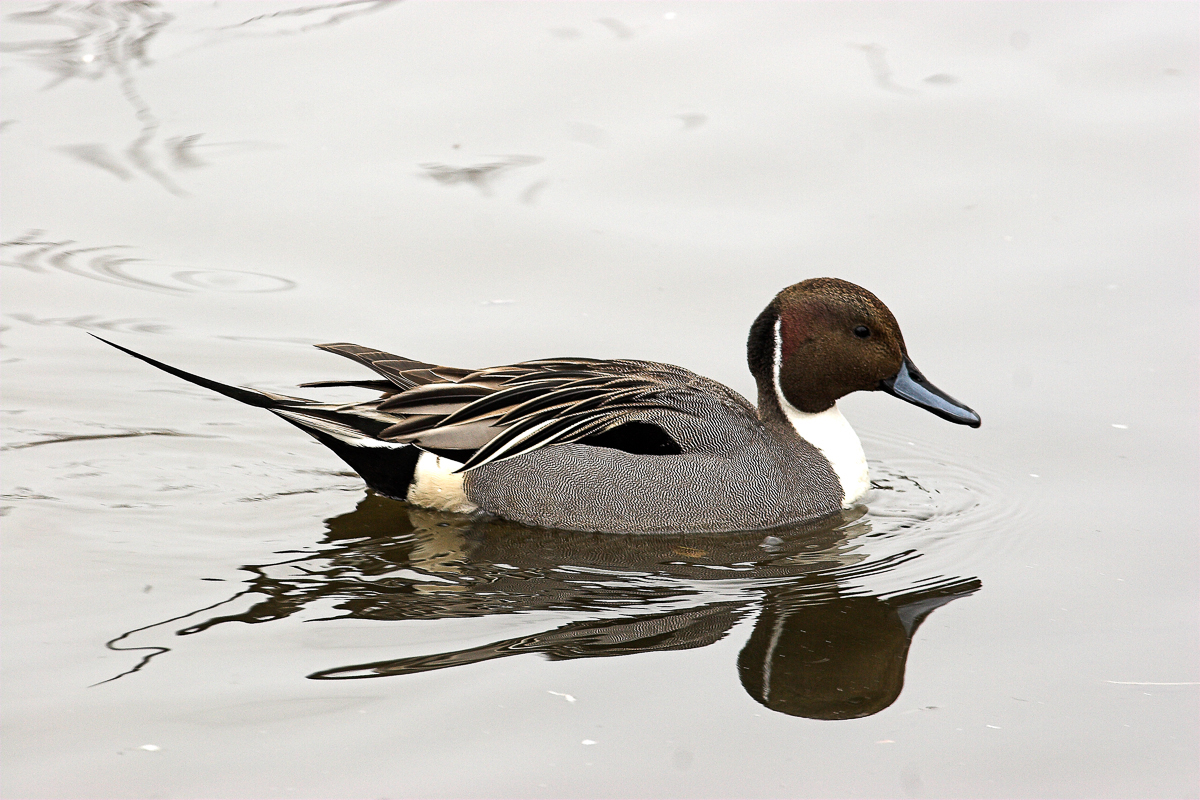
|
|
Norhtern Pintail, image courtesy of and copyright Arni Cheatham.
|
Ticket Information
Tickets for Cheatham’s 3pm program are $15 for Mass Audubon members and $19 for nonmembers. Advance reservations are required to massaudubon.org/maba or 781-821-8853.
Performance Details: Accompanying Cheatham will be creative improviser and long time musical associate, John Funkhouser, a well-known pianist/keyboardist, bassist composer and educator. Cheatham and Funkhouser have performed together in the Aardvark Jazz Orchestra, Mark Harvey’s Jazztet, and other ensemble settings. Funkhouser teaches at Berklee School of Music and co-teaches with Cheatham for the JazzBoston’s Riffs and Raps program.
Other Events: The Travels with the Bird Artists series concludes May 1 with an evening presentation by author John Hanson Mitchell about bicycling with bird migrations across Europe, also by advance registration.
|

|
|
Fort DeSoto in spring is rich with tame birds. With many in breeding plumage it is a photographer’s paradise. I hope that you can join me there in mid-May.
|
Short Notice Fort DeSoto IPT/In-the-Field Workshops: May 9, 10, & 11, 2014
IPT–3 FULL DAYs: $1099
In-the-Field Workshops: $399/day
Fort DeSoto in spring is so good that I needed to create two cards in order to give folks an idea of what is possible. Even then I have barely scratched the surface. If you are coming from out of town you will surely want to do all 3 days, the entire IPT. Local folks may wish to join me for one or more full days.
There will Lots of tame birds including breeding plumage Laughing Gull and Royal and Sandwich Terns courting and copulating. American Oystercatcher plus lots of sandpipers and plovers, some in breeding plumage. Red Knot in breeding plumage likely. Lots of wading birds including Great and Snowy Egrets, both color morphs of Reddish Egret, Great Blue, Tricolored and Little Blue Heron, and Yellow-crowned Night-Heron. Roseate Spoonbill and WOod Stork between possible and likely…. Lots of flight photography with the gulls and terns and with Brown Pelican.
You will learn how to approach free and wild birds without disturbing them, to understand and predict bird behavior, to identify many species of shorebirds, to spot the good situations, to choose the best perspective, to see and understand the light, to get the right exposure every time after making a single test exposure, and to design pleasing images by mastering your camera’s AF system. And you will learn learn how and why to work in Manual mode (even if you are scared of it).
At lunch we will review my images–folks learn a ton watching me edit–why keep this one and delete that one. If you opt to bring your laptop, we will take a look at five of your best images from the morning session. We will process a few of my images in Photoshop after converting them in DPP. That followed by Instructor Nap Time.
This is the IPT hotel: Comfort Inn St. Petersburg, FL. 2260 54th Ave N., St. Petersburg, FL 33714. tel: 1-727-362-0075. The best airport is Tampa (TPA).
Payment in full via credit card is due upon registering. Please call Jim or Jennifer at 863-692-0906 to register.
|

|
|
Fort DeSoto in spring is rich with tame birds. With many in breeding plumage it is a photographer’s paradise. I hope that you can join me there in mid-May.
|
Fort DeSoto Site Guide
Can’t make it in mid-May? Get yourself a copy of the Fort DeSoto Site Guide. Learn the best spots, where to be when in what season in what weather. Learn the best wind directions for the various locations. BAA Site Guides are the next best thing to being on an IPT. You can see all of them here.
Shorebirds/Beautiful Beachcombers
If the shorebirds in the ID quiz gave you pause, get yourself a copy of my Shorebirds/Beautiful Beachcombers. Includes ID tips, shorebird biology, migration, and tons more. All in my simple-to-read easy-to-read style.
Canon Gear for Sale
Doug Bolt is offering a used Canon 400mm f/4L IS DO lens in very good to excellent condition for $4599. The sale includes the lens trunk and lens cover; the seller will pay shipping to US addresses only. This one should sell in minutes to someone looking for a lightweight super-telephoto. The item will ship only when the check clears.
Please contact Doug for additional info and/or a link to photos via e-mail or try him by phone at home: at 301-937-3112 or on his cell at 301-537-8073.
Doug is also offering a used EOS-5D Mark II in very good to excellent condition for $1199. There is a shallow scratch on the body and a faint smudge on the top LCD. The sale includes a RRS L-plate, a vertical grip, and the original box and all the stuff that came in it. The seller will pay shipping to US addresses only. This one is a great body for flowers and landscapes. Mine saved me on a Southern Oceans cruise when I trashed two EOS-1D Mark IV bodies in a rainstorm; it was a great back-up camera body. The item will ship only when the check clears.
Again, please contact Doug for additional info and/or a link to photos via e-mail or try him by phone at home: at 301-937-3112 or on his cell at 301-537-8073.
|

|
|
Join me at Gatorland for a ton of learning. If you want to learn to use your flash, you will not want to miss this one. Click on the composite image to enjoy a larger version. Click on the composite to enjoy the larger size.
|
Another Gatorland Short Notice Saturday Full-Day In-the-Field Workshop
Saturday May 3, 2014. 7:15am till 10:15am & 4:00pm till dusk. Lunch, image review, and Photoshop session included. Limit 6. A very small group is again likely: $399.
The cost of your Gatorland Photographer’s Pass is not included.
Chicks in nests likely. Breeding plumage Cattle and Snowy Egrets. And tons more. You will learn to spot the good situations, to choose the best perspective, to see and understand the light, to get the right exposure every time after making a single test exposure, and to design pleasing images by mastering your camera’s AF system. A big part of the above is that you will learn how and why you must work in Manual mode 90% of the time at Gatorland.
At lunch we will review my images, take a look at five of your best images from the morning session (for those who opt to bring their laptops), and process a few of my images in Photoshop after converting them in DPP. That followed by Instructor Nap Time. Last Saturday all 3 folks had a great time and learned a ton. And the weather for this coming Saturday is looking good.
Payment in full via credit card is due upon registering. Please call Jim or Jennifer at 863-692-0906 to register.
Support the BAA Blog. Support the BAA Bulletins: Shop B&H here!
We want and need to keep providing you with the latest free information, photography and Photoshop lessons, and all manner of related information. Show your appreciation by making your purchases immediately after clicking on any of our B&H or Amazon Affiliate links in this blog post. Remember, B&H ain’t just photography!
….. …..
Typos
In all blog posts and Bulletins, feel free to e-mail or to leave a comment regarding any typos, wrong words, misspellings, omissions, or grammatical errors. Just be right. 🙂
April 18th, 2014 The Streak Continues: 140
I am publishing this blog post at about 2pm Amsterdam time, 8:00am on the east coast. We set out to do the tulip fields this morning but the blustery weather prompted us to go back to Keukenhof Gardens where we enjoyed the pretty much people-free grounds in the early morning and finished up doing the spectacular orchids in the Beatrix Pavilion. We are headed out to do the fields at 3pm. Not much time for a nap….
This post marks 140 straight days with a new educational blog post. With so many folks getting in the habit of using our B&H links and our Amazon logo-links why quit now? To show your appreciation for my efforts here, we do ask that you use our the B&H and Amazon affiliate links on the right side of the blog for all of your purchases. Please check the availability of all photographic accessories in the BIRDS AS ART Online Store, especially Gitzo tripods, Wimberley tripod heads, and the like. We sell only what I used, tested, and can depend on. We will not sell you junk. We know what you need to make creating great images easy and fun. And we are always glad to answer your gear questions via e-mail.
You can find the following items in the store: Gitzo tripods, Mongoose M3.6 and Wimberley heads, plates, low feet, and accessories, flash brackets, , Delkin e-film Pro Compact Flash Cards, LensCoat products, and our unique line-up of educational materials including ABP I & II, Digital Basics, Site and Set-up e-Guides, Canon and Nikon Camera Users and AF e-Guides, and MP-4 Photoshop video tutorials among others.
I would of course appreciate your using our B&H affiliate links for all of your major gear, video, and electronic purchases. For the photographic stuff mentioned in the paragraph above we, meaning BAA, would of course greatly appreciate your business. Here is a huge thank you to the many who have been using our links on a regular basis and visiting the BAA Online store as well.
This blog post took 2 hours to put together. Enjoy!
|
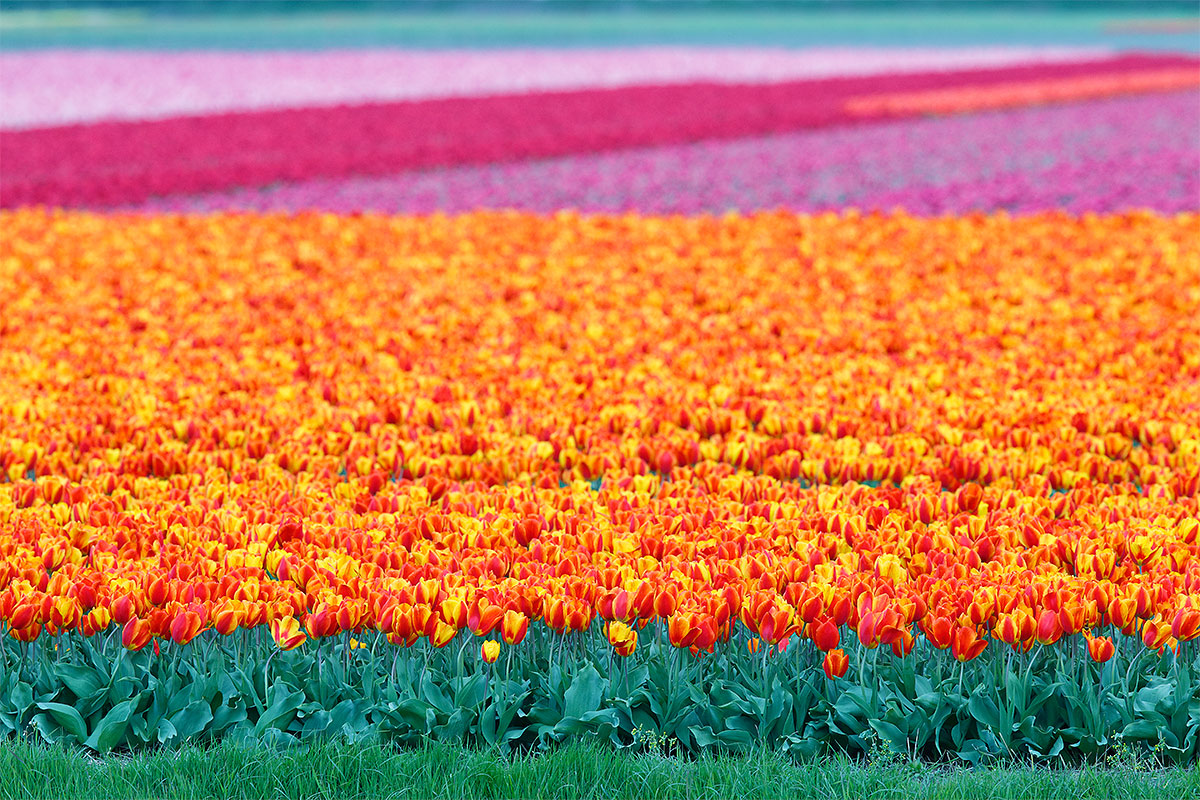
|
|
This image was created yesterday morning, April 17, on a scouting trip with our early-arriving clients in the tulip fields near the famed Keukenhof Gardens, Lisse, Holland (The Netherlands) with the Gitzo GT1542T Tripod, the Mongoose M3.6 head, the Canon EF 300mm f/2.8L IS II USM lens, the Canon Extender EF 2X III, and the Canon EOS 5D Mark III. ISO 400. Evaluative metering +1 stop as framed: 1/320 sec. at f/11 in Tv Mode. Color temperature: AWB.
Central sensor/AI Servo/Surround Rear Focus AF on the first row of flowers and re-compose. Click here to see the latest version of the Rear Focus Tutorial. Click on the image to see a larger version.
Image #1: Straight-Up
|
Beyond Breathtaking
Last year, with the coldest winter and early spring in Europe in 100 years, there were few flower fields. We really had to scrounge around. With more normal weather this year the flower fields are breathtaking.
Thank God For the 300mm f/2.8L IS
Both of today’s images were created with the 300 II and the 2X III TC. I am very glad that I brought the 300 rather than the 200-400. With the 300/2X combo I get 600mm at f/5.6. To get beyond 560mm with the 200-400 in need to add an external 1.4X TC and doing that leaves me at f/8. And the 300 saves me considerable weight as compared to the 200-400. Best of all the 300/2X combo gave me the reach that I needed.
|
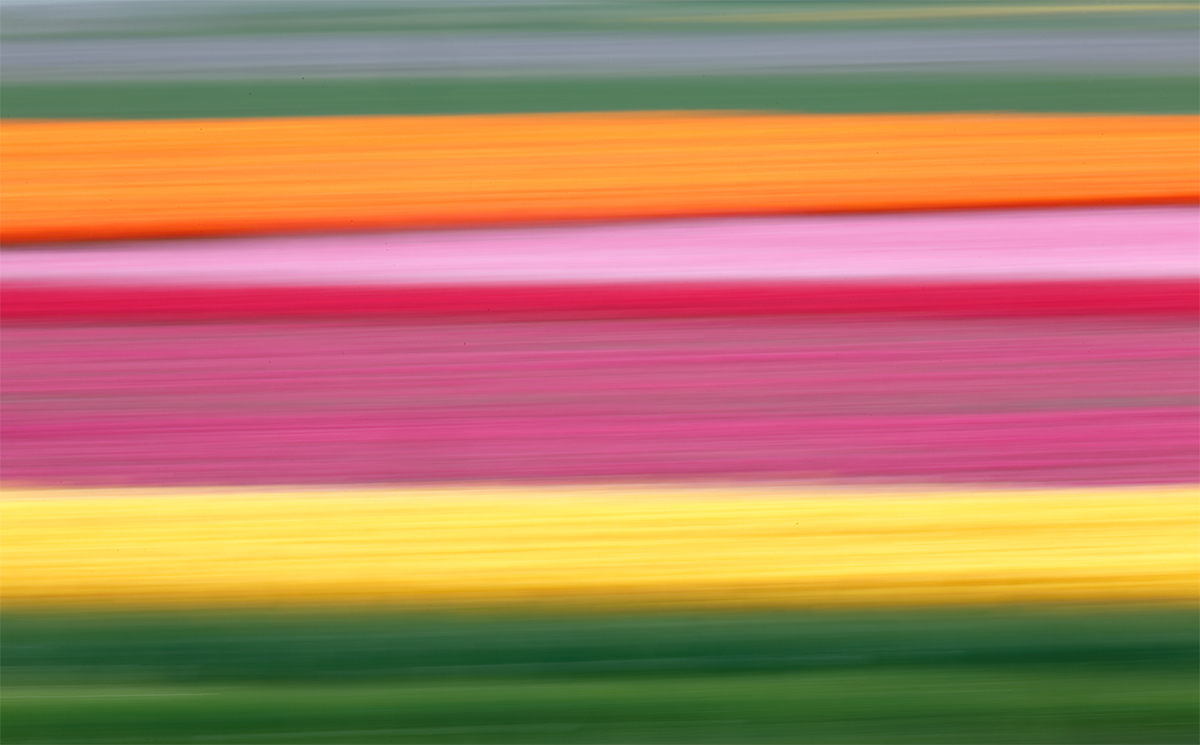
|
|
This image was created yesterday morning, April 17, on a scouting trip with our early-arriving clients in the tulip fields near the famed Keukenhof Gardens, Lisse, Holland (The Netherlands) with the Gitzo GT1542T Tripod, the Mongoose M3.6 head, the Canon EF 300mm f/2.8L IS II USM lens, the Canon Extender EF 2X III, and the and the Canon EOS 5D Mark III. ISO 50. Evaluative metering +1 stop as framed: 1/4 sec. at f/32 in Tv Mode. Color temperature: AWB.
Central sensor/AI Servo/Surround Rear Focus AF about 1/3 of the way into the frame, re-compose, and pan. Click here to see the latest version of the Rear Focus Tutorial. Click on the image to see a larger version.
Image #2: Tripod-mounted Horizontal Pan Blur
|
Creating Pleasing Blurs
There is a lot more than meets the eye when creating images like the one above with long glass. First, I center the bubble in the scribed circle on the Mongoose to level the tripod platform. Then I use the electronic level in the 5D III to square the camera by rotating the lens in the tripod collar. Then of course you need to tighten the tripod collar. Next, I carefully determine the framing at the top by pointing the lens higher or lower. Once I am happy with that framing I lock the vertical panning knob but leave the horizontal panning knob loose.
I at ISO 50 in Tv mode at 1/4 second, add some light, and do a histogram check to make sure that I have a good exposure. Then it is simply matter of panning smoothly as you depress the shutter button. The faster you pan, the more ground you will cover and the smoother your blur will be. As always with blurs, vary your panning rate and be sure to take lots of images.
A Guide to Pleasing Blurs
If you would like to learn more about creating pleasing blurs, check out “A Guide to Pleasing Blurs” by Denise Ippolito and yours truly. Illustrated with 144 different, exciting, inspiring, and artistic images the guide covers the basics of creating pleasingly blurred images, the factors that influence the degree of blurring, the use of filters in creating pleasing blurs, and a great variety of both in-the-field and Photoshop techniques that can be used to create the pleasingly blurred, out-of-the box images that do so well in major photographic compositions.
Your Favorite?
Please take a moment to leave a comment and let us know which image you like best, and why. I have a very strong preference….
|

|
|
Fort DeSoto in spring is rich with tame birds. With many in breeding plumage it is a photographer’s paradise. I hope that you can join me there in mid-May.
|
Short Notice Fort DeSoto IPT/In-the-Field Workshops: May 9, 10, & 11, 2014
IPT–3 FULL DAYs: $1099
In-the-Field Workshops: $399/day
Fort DeSoto in spring is so good that I needed to create two cards in order to give folks an idea of what is possible. Even then I have barely scratched the surface. If you are coming from out of town you will surely want to do all 3 days, the entire IPT. Local folks may wish to join me for one or more full days.
There will Lots of tame birds including breeding plumage Laughing Gull and Royal and Sandwich Terns courting and copulating. American Oystercatcher plus lots of sandpipers and plovers, some in breeding plumage. Red Knot in breeding plumage likely. Lots of wading birds including Great and Snowy Egrets, both color morphs of Reddish Egret, Great Blue, Tricolored and Little Blue Heron, and Yellow-crowned Night-Heron. Roseate Spoonbill and WOod Stork between possible and likely…. Lots of flight photography with the gulls and terns and with Brown Pelican.
You will learn how to approach free and wild birds without disturbing them, to understand and predict bird behavior, to identify many species of shorebirds, to spot the good situations, to choose the best perspective, to see and understand the light, to get the right exposure every time after making a single test exposure, and to design pleasing images by mastering your camera’s AF system. And you will learn learn how and why to work in Manual mode (even if you are scared of it).
At lunch we will review my images–folks learn a ton watching me edit–why keep this one and delete that one. If you opt to bring your laptop, we will take a look at five of your best images from the morning session. We will process a few of my images in Photoshop after converting them in DPP. That followed by Instructor Nap Time.
This is the IPT hotel: Comfort Inn St. Petersburg, FL. 2260 54th Ave N., St. Petersburg, FL 33714. tel: 1-727-362-0075. The best airport is Tampa (TPA).
Payment in full via credit card is due upon registering. Please call Jim or Jennifer at 863-692-0906 to register.
|

|
|
Fort DeSoto in spring is rich with tame birds. With many in breeding plumage it is a photographer’s paradise. I hope that you can join me there in mid-May.
|
Fort DeSoto Site Guide
Can’t make it in mid-May? Get yourself a copy of the Fort DeSoto Site Guide. Learn the best spots, where to be when in what season in what weather. Learn the best wind directions for the various locations. BAA Site Guides are the next best thing to being on an IPT. You can see all of them here.
Shorebirds/Beautiful Beachcombers
If the shorebirds in the ID quiz gave you pause, get yourself a copy of my Shorebirds/Beautiful Beachcombers. Includes ID tips, shorebird biology, migration, and tons more. All in my simple-to-read easy-to-read style.
Canon Gear for Sale
Doug Bolt is offering a used Canon 400mm f/4L IS DO lens in very good to excellent condition for $4599. The sale includes the lens trunk and lens cover; the seller will pay shipping to US addresses only. This one should sell in minutes to someone looking for a lightweight super-telephoto. The item will ship only when the check clears.
Please contact Doug for additional info and/or a link to photos via e-mail or try him by phone at home: at 301-937-3112 or on his cell at 301-537-8073.
Doug is also offering a used EOS-5D Mark II in very good to excellent condition for $1199. There is a shallow scratch on the body and a faint smudge on the top LCD. The sale includes a RRS L-plate, a vertical grip, and the original box and all the stuff that came in it. The seller will pay shipping to US addresses only. This one is a great body for flowers and landscapes. Mine saved me on a Southern Oceans cruise when I trashed two EOS-1D Mark IV bodies in a rainstorm; it was a great back-up camera body. The item will ship only when the check clears.
Again, please contact Doug for additional info and/or a link to photos via e-mail or try him by phone at home: at 301-937-3112 or on his cell at 301-537-8073.
|

|
|
Join me at Gatorland for a ton of learning. If you want to learn to use your flash, you will not want to miss this one. Click on the composite image to enjoy a larger version. Click on the composite to enjoy the larger size.
|
Another Gatorland Short Notice Saturday Full-Day In-the-Field Workshop
Saturday May 3, 2014. 7:15am till 10:15am & 4:00pm till dusk. Lunch, image review, and Photoshop session included. Limit 6. A very small group is again likely: $399.
The cost of your Gatorland Photographer’s Pass is not included.
Chicks in nests likely. Breeding plumage Cattle and Snowy Egrets. And tons more. You will learn to spot the good situations, to choose the best perspective, to see and understand the light, to get the right exposure every time after making a single test exposure, and to design pleasing images by mastering your camera’s AF system. A big part of the above is that you will learn how and why you must work in Manual mode 90% of the time at Gatorland.
At lunch we will review my images, take a look at five of your best images from the morning session (for those who opt to bring their laptops), and process a few of my images in Photoshop after converting them in DPP. That followed by Instructor Nap Time. Last Saturday all 3 folks had a great time and learned a ton. And the weather for this coming Saturday is looking good.
Payment in full via credit card is due upon registering. Please call Jim or Jennifer at 863-692-0906 to register.
Support the BAA Blog. Support the BAA Bulletins: Shop B&H here!
We want and need to keep providing you with the latest free information, photography and Photoshop lessons, and all manner of related information. Show your appreciation by making your purchases immediately after clicking on any of our B&H or Amazon Affiliate links in this blog post. Remember, B&H ain’t just photography!
….. …..
Typos
In all blog posts and Bulletins, feel free to e-mail or to leave a comment regarding any typos, wrong words, misspellings, omissions, or grammatical errors. Just be right. 🙂
April 17th, 2014 The Streak Continues: 139
I am publishing this blog post at about noon in Amsterdam, which is about 6:00am on the east coast. We took the early arriving participants out for a morning session in the tulip fields. The colors and patterns are beyond stunning…. After a short nap and then lunch we meet the group at 1:30pm for our first formal session.
This post marks 139 straight days with a new educational blog post. With so many folks getting in the habit of using our B&H links and our Amazon logo-links why quit now? To show your appreciation for my efforts here, we do ask that you use our the B&H and Amazon affiliate links on the right side of the blog for all of your purchases. Please check the availability of all photographic accessories in the BIRDS AS ART Online Store, especially Gitzo tripods, Wimberley tripod heads, and the like. We sell only what I used, tested, and can depend on. We will not sell you junk. We know what you need to make creating great images easy and fun. And we are always glad to answer your gear questions via e-mail.
You can find the following items in the store: Gitzo tripods, Mongoose M3.6 and Wimberley heads, plates, low feet, and accessories, flash brackets, , Delkin e-film Pro Compact Flash Cards, LensCoat products, and our unique line-up of educational materials including ABP I & II, Digital Basics, Site and Set-up e-Guides, Canon and Nikon Camera Users and AF e-Guides, and MP-4 Photoshop video tutorials among others.
I would of course appreciate your using our B&H affiliate links for all of your major gear, video, and electronic purchases. For the photographic stuff mentioned in the paragraph above we, meaning BAA, would of course greatly appreciate your business. Here is a huge thank you to the many who have been using our links on a regular basis and visiting the BAA Online store as well.
This blog post took 2 hours to put together. Enjoy!
|
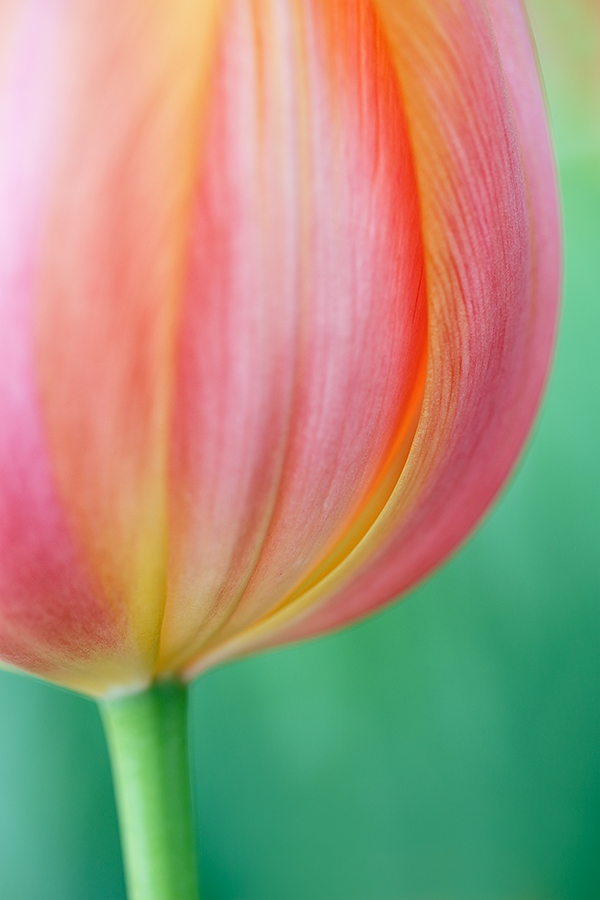
|
|
This image was created yesterday, on the afternoon of April 16 at Keukenhof Gardens with the Gitzo GT1542T Tripod, the Mongoose M3.6 head, the Canon EF 100mm f/2.8L Macro IS USM lens, and the Canon EOS 5D Mark III. ISO 400. Evaluative metering +1 1/3 stops as framed: 1/60 sec. at f/4 in Av Mode. Color temperature: 3500.
Central sensor only manual focus as there was not enough contrast anywhere for AF to work. Click on the image to see a larger version.
Image #1
|
Keukenhof Scouting
Denise and I arrived in Amsterdam a day early in order to get in a bit of scouting. The flower fields are 1000 times better than last year when we caught the tail end of the coldest winter and early spring in 100 years. The tulips in Willem-Alexander Pavilion are well past peak and many of the plots of tulips have been cut. But with fewer folks visiting and lots of older flowers photography is spectacular as it is easy to see into the flower centers (though that is not what I did for the two images featured today).
The name for today’s flower is “Tulipa Dordgone. With one of the petals on the right slightly separated from the flower the darker strip of orange in each image is actually the inside of the flower. This image would not have been possible had I been working with a perfect blossom….
|
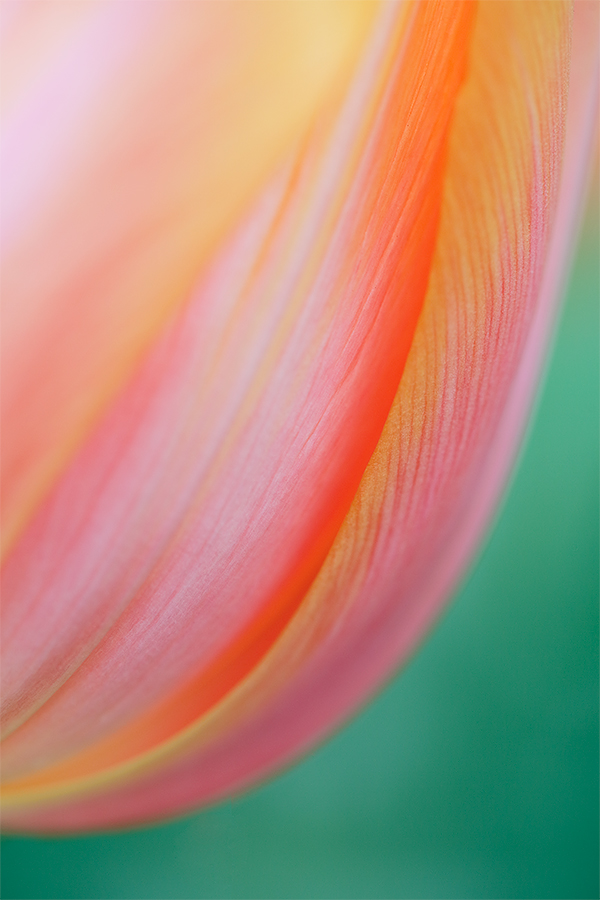
|
|
This image of the same flower was also created yesterday, on the afternoon of April 16 at Keukenhof Gardens with the Gitzo GT1542T Tripod, the Mongoose M3.6 head, the Canon EF 100mm f/2.8L Macro IS USM lens, and the Canon EOS 5D Mark III. ISO 400. Evaluative metering +1 stop as framed: 1/80 sec. at f/4 in Av Mode. Color temperature: 3500.
Central sensor only manual focus as there was not enough contrast anywhere for AF to work. Click on the image to see a larger version.
Image #2
|
Vary Your Compositions
While working with this single flower I made 39 images varying my framing and apertures as I went. I quickly noticed that using a smaller aperture brought up too much background detail. I often moved my tripod a bit left or right or up or down to vary the background and eliminate anything distracting, and several times moved in a bit or back a bit to achieve the desired framing.
The Lightweight Gitzo GT1542T 4-section Traveler Tripod
I have owned this tripod for about a year now. For the most part, I use it mostly to hold the LensAlign Mark II when micro-adjusting my lenses. On a whim, I packed it in one of my two checked bags for the Holland trip along with my workhorse Gitzo 3532 tripod. I have been rehabbing my right shoulder for more than a decade…. Yesterday I decided to go super-light with the tiny tripod and the Mongoose. Lord was I pleased. I used the 300 II with the 2X III TC and using good sharpness techniques on my part I was able to make sharp images at shutter speeds below 1/100 sec. And my shoulder felt great after the 5 hour photo session.
Because the Gitzo GT1542T will be top heavy with pretty much any camera and lens mounted on it, it is imperative that you never ever leave your tripod unattended, even for an instant. If you do lots of flowers and/or work with an intermediate telephoto lens and you like lightweight stuff, the Gitzo GT1542T tripod might just be perfect for you. Click here to read my probably too honest evaluation. As for me, I am sold on it for flower photography. More coming soon.
Canon Tripod Mount Ring D for IS 100mm f/2.8L Macro Lens
Because the 100 macro does not come with a tripod collar, those of you who own the lens are likely wondering “How does he get the 100 macro onto a Mongoose?” The answer is simple. I purchased the right tripod collar as a Canon accessory. In general it is not a good policy to mount the camera onto a ball head with the lens hanging from the front of it and stressing the lens mount. I prefer using the Mongoose for my flower photography for a variety of reasons so once I learned of the Canon Tripod Mount Ring D for IS 100mm f/2.8L Macro Lens I made it a point to get my hands on one asap and to bring it to Holland. And I did.
I tried the much cheaper ($49.95 as compared to $172.00) Vello Tripod Collar D (Black) for Canon EF 100mm f/2.8L IS USM Macro Lens but it pretty much turned out to be junk. It was very difficult to loosen and open it and very difficult to get it on the lens and tighten it. So I went with the Canon version. In general, you get what you pay for.
Your Favorite?
Take a moment to leave a comment and let us know which of the two images here you like best. And be sure to let us know why.
Shorebird ID
In yesterday’s blog post ID quiz most folks did quite well. Most were easy peasy. But nobody got #4 correct in the first composite…. Three thought Western Sandpiper but that is incorrect. Semipalmated Sandpiper was closer but incorrect. Here’s a clue: if I gave you a clue most folks would get it right…. I will come clean in a day or so but till then, let’s see if someone can figure it out correctly.
|

|
|
Fort DeSoto in spring is rich with tame birds. With many in breeding plumage it is a photographer’s paradise. I hope that you can join me there in mid-May.
|
Short Notice Fort DeSoto IPT/In-the-Field Workshops: May 9, 10, & 11, 2014
IPT–3 FULL DAYs: $1099
In-the-Field Workshops: $399/day
Fort DeSoto in spring is so good that I needed to create two cards in order to give folks an idea of what is possible. Even then I have barely scratched the surface. If you are coming from out of town you will surely want to do all 3 days, the entire IPT. Local folks may wish to join me for one or more full days.
There will Lots of tame birds including breeding plumage Laughing Gull and Royal and Sandwich Terns courting and copulating. American Oystercatcher plus lots of sandpipers and plovers, some in breeding plumage. Red Knot in breeding plumage likely. Lots of wading birds including Great and Snowy Egrets, both color morphs of Reddish Egret, Great Blue, Tricolored and Little Blue Heron, and Yellow-crowned Night-Heron. Roseate Spoonbill and WOod Stork between possible and likely…. Lots of flight photography with the gulls and terns and with Brown Pelican.
You will learn how to approach free and wild birds without disturbing them, to understand and predict bird behavior, to identify many species of shorebirds, to spot the good situations, to choose the best perspective, to see and understand the light, to get the right exposure every time after making a single test exposure, and to design pleasing images by mastering your camera’s AF system. And you will learn learn how and why to work in Manual mode (even if you are scared of it).
At lunch we will review my images–folks learn a ton watching me edit–why keep this one and delete that one. If you opt to bring your laptop, we will take a look at five of your best images from the morning session. We will process a few of my images in Photoshop after converting them in DPP. That followed by Instructor Nap Time.
This is the IPT hotel: Comfort Inn St. Petersburg, FL. 2260 54th Ave N., St. Petersburg, FL 33714. tel: 1-727-362-0075. The best airport is Tampa (TPA).
Payment in full via credit card is due upon registering. Please call Jim or Jennifer at 863-692-0906 to register.
|

|
|
Fort DeSoto in spring is rich with tame birds. With many in breeding plumage it is a photographer’s paradise. I hope that you can join me there in mid-May.
|
Fort DeSoto Site Guide
Can’t make it in mid-May? Get yourself a copy of the Fort DeSoto Site Guide. Learn the best spots, where to be when in what season in what weather. Learn the best wind directions for the various locations. BAA Site Guides are the next best thing to being on an IPT. You can see all of them here.
Shorebirds/Beautiful Beachcombers
If the shorebirds in the ID quiz gave you pause, get yourself a copy of my Shorebirds/Beautiful Beachcombers. Includes ID tips, shorebird biology, migration, and tons more. All in my simple-to-read easy-to-read style.
Canon Gear for Sale
Doug Bolt is offering a used Canon 400mm f/4L IS DO lens in very good to excellent condition for $4599. The sale includes the lens trunk and lens cover; the seller will pay shipping to US addresses only. This one should sell in minutes to someone looking for a lightweight super-telephoto. The item will ship only when the check clears.
Please contact Doug for additional info and/or a link to photos via e-mail or try him by phone at home: at 301-937-3112 or on his cell at 301-537-8073.
Doug is also offering a used EOS-5D Mark II in very good to excellent condition for $1199. There is a shallow scratch on the body and a faint smudge on the top LCD. The sale includes a RRS L-plate, a vertical grip, and the original box and all the stuff that came in it. The seller will pay shipping to US addresses only. This one is a great body for flowers and landscapes. Mine saved me on a Southern Oceans cruise when I trashed two EOS-1D Mark IV bodies in a rainstorm; it was a great back-up camera body. The item will ship only when the check clears.
Again, please contact Doug for additional info and/or a link to photos via e-mail or try him by phone at home: at 301-937-3112 or on his cell at 301-537-8073.
|

|
|
Join me at Gatorland for a ton of learning. If you want to learn to use your flash, you will not want to miss this one. Click on the composite image to enjoy a larger version. Click on the composite to enjoy the larger size.
|
Another Gatorland Short Notice Saturday Full-Day In-the-Field Workshop
Saturday May 3, 2014. 7:15am till 10:15am & 4:00pm till dusk. Lunch, image review, and Photoshop session included. Limit 6. A very small group is again likely: $399.
The cost of your Gatorland Photographer’s Pass is not included.
Chicks in nests likely. Breeding plumage Cattle and Snowy Egrets. And tons more. You will learn to spot the good situations, to choose the best perspective, to see and understand the light, to get the right exposure every time after making a single test exposure, and to design pleasing images by mastering your camera’s AF system. A big part of the above is that you will learn how and why you must work in Manual mode 90% of the time at Gatorland.
At lunch we will review my images, take a look at five of your best images from the morning session (for those who opt to bring their laptops), and process a few of my images in Photoshop after converting them in DPP. That followed by Instructor Nap Time. Last Saturday all 3 folks had a great time and learned a ton. And the weather for this coming Saturday is looking good.
Payment in full via credit card is due upon registering. Please call Jim or Jennifer at 863-692-0906 to register.
Support the BAA Blog. Support the BAA Bulletins: Shop B&H here!
We want and need to keep providing you with the latest free information, photography and Photoshop lessons, and all manner of related information. Show your appreciation by making your purchases immediately after clicking on any of our B&H or Amazon Affiliate links in this blog post. Remember, B&H ain’t just photography!
….. …..
Typos
In all blog posts and Bulletins, feel free to e-mail or to leave a comment regarding any typos, wrong words, misspellings, omissions, or grammatical errors. Just be right. 🙂
April 16th, 2014 The Streak Continues: 138
I am publishing this blog post at 7:56am in Amsterdam, 1:56am in Florida. I am waiting for my bags. With severe thunderstorms in Orlando I just made my connection in Detroit. The flight was an easy one and I got a few hours of sleep towards the end. It feels like morning here 🙂
This post marks 138 straight days with a new educational blog post. With so many folks getting in the habit of using our B&H links and our Amazon logo-links why quit now? To show your appreciation for my efforts here, we do ask that you use our the B&H and Amazon affiliate links on the right side of the blog for all of your purchases. Please check the availability of all photographic accessories in the BIRDS AS ART Online Store, especially Gitzo tripods, Wimberley tripod heads, and the like. We sell only what I used, tested, and can depend on. We will not sell you junk. We know what you need to make creating great images easy and fun. And we are always glad to answer your gear questions via e-mail.
You can find the following items in the store: Gitzo tripods, Mongoose M3.6 and Wimberley heads, plates, low feet, and accessories, flash brackets, , Delkin e-film Pro Compact Flash Cards, LensCoat products, and our unique line-up of educational materials including ABP I & II, Digital Basics, Site and Set-up e-Guides, Canon and Nikon Camera Users and AF e-Guides, and MP-4 Photoshop video tutorials among others.
I would of course appreciate your using our B&H affiliate links for all of your major gear, video, and electronic purchases. For the photographic stuff mentioned in the paragraph above we, meaning BAA, would of course greatly appreciate your business. Here is a huge thank you to the many who have been using our links on a regular basis and visiting the BAA Online store as well.
This blog post took 3 hours to put together. Enjoy!
|

|
|
Fort DeSoto in spring is rich with tame birds. With many in breeding plumage it is a photographer’s paradise. I hope that you can join me there in mid-May.
|
Image Quiz #1
Can you identify the birds here:
Left column top?
Left column middle?
Top row/first vertical?
Middle column, middle row?
Be sure to click on the composite to see the larger version. You can cut and paste the text above into your comment and then type your answers. Be sure to indicate Quiz #1.
Short Notice Fort DeSoto IPT/In-the-Field Workshops: May 9, 10, & 11, 2014
IPT–3 FULL DAYs: $1099
In-the-Field Workshops: $399/day
Fort DeSoto in spring is so good that I needed to create two cards in order to give folks an idea of what is possible. Even then I have barely scratched the surface. If you are coming from out of town you will surely want to do all 3 days, the entire IPT. Local folks may wish to join me for one or more full days.
There will Lots of tame birds including breeding plumage Laughing Gull and Royal and Sandwich Terns courting and copulating. American Oystercatcher plus lots of sandpipers and plovers, some in breeding plumage. Red Knot in breeding plumage likely. Lots of wading birds including Great and Snowy Egrets, both color morphs of Reddish Egret, Great Blue, Tricolored and Little Blue Heron, and Yellow-crowned Night-Heron. Roseate Spoonbill and WOod Stork between possible and likely…. Lots of flight photography with the gulls and terns and with Brown Pelican.
You will learn how to approach free and wild birds without disturbing them, to understand and predict bird behavior, to identify many species of shorebirds, to spot the good situations, to choose the best perspective, to see and understand the light, to get the right exposure every time after making a single test exposure, and to design pleasing images by mastering your camera’s AF system. And you will learn learn how and why to work in Manual mode (even if you are scared of it).
At lunch we will review my images–folks learn a ton watching me edit–why keep this one and delete that one. If you opt to bring your laptop, we will take a look at five of your best images from the morning session. We will process a few of my images in Photoshop after converting them in DPP. That followed by Instructor Nap Time.
This is the IPT hotel: Comfort Inn St. Petersburg, FL. 2260 54th Ave N., St. Petersburg, FL 33714. tel: 1-727-362-0075. The best airport is Tampa (TPA).
Payment in full via credit card is due upon registering. Please call Jim or Jennifer at 863-692-0906 to register.
|

|
|
Fort DeSoto in spring is rich with tame birds. With many in breeding plumage it is a photographer’s paradise. I hope that you can join me there in mid-May.
|
Image Quiz #2
Can you identify the birds here:
Top row/first vertical?
First column middle?
First column bottom?
Last column, last row?
Be sure to click on the composite to see the larger version. You can cut and paste the text above into your comment and then type your answers. Be sure to indicate Quiz #2.
Fort DeSoto Site Guide
Can’t make it in mid-May? Get yourself a copy of the Fort DeSoto Site Guide. Learn the best spots, where to be when in what season in what weather. Learn the best wind directions for the various locations. BAA Site Guides are the next best thing to being on an IPT. You can see all of them here.
Shorebirds/Beautiful Beachcombers
If the shorebirds in the ID quiz gave you pause, get yourself a copy of my Shorebirds/Beautiful Beachcombers. Includes ID tips, shorebird biology, migration, and tons more. All in my simple-to-read easy-to-read style.
Canon Gear for Sale
Doug Bolt is offering a used Canon 400mm f/4L IS DO lens in very good to excellent condition for $4599. The sale includes the lens trunk and lens cover; the seller will pay shipping to US addresses only. This one should sell in minutes to someone looking for a lightweight super-telephoto. The item will ship only when the check clears.
Please contact Doug for additional info and/or a link to photos via e-mail or try him by phone at home: at 301-937-3112 or on his cell at 301-537-8073.
Doug is also offering a used EOS-5D Mark II in very good to excellent condition for $1199. There is a shallow scratch on the body and a faint smudge on the top LCD. The sale includes a RRS L-plate, a vertical grip, and the original box and all the stuff that came in it. The seller will pay shipping to US addresses only. This one is a great body for flowers and landscapes. Mine saved me on a Southern Oceans cruise when I trashed two EOS-1D Mark IV bodies in a rainstorm; it was a great back-up camera body. The item will ship only when the check clears.
Again, please contact Doug for additional info and/or a link to photos via e-mail or try him by phone at home: at 301-937-3112 or on his cell at 301-537-8073.
|

|
|
Join me at Gatorland for a ton of learning. If you want to learn to use your flash, you will not want to miss this one. Click on the composite image to enjoy a larger version. Click on the composite to enjoy the larger size.
|
Another Gatorland Short Notice Saturday Full-Day In-the-Field Workshop
Saturday May 3, 2014. 7:15am till 10:15am & 4:00pm till dusk. Lunch, image review, and Photoshop session included. Limit 6. A very small group is again likely: $399.
The cost of your Gatorland Photographer’s Pass is not included.
Chicks in nests likely. Breeding plumage Cattle and Snowy Egrets. And tons more. You will learn to spot the good situations, to choose the best perspective, to see and understand the light, to get the right exposure every time after making a single test exposure, and to design pleasing images by mastering your camera’s AF system. A big part of the above is that you will learn how and why you must work in Manual mode 90% of the time at Gatorland.
At lunch we will review my images, take a look at five of your best images from the morning session (for those who opt to bring their laptops), and process a few of my images in Photoshop after converting them in DPP. That followed by Instructor Nap Time. Last Saturday all 3 folks had a great time and learned a ton. And the weather for this coming Saturday is looking good.
Payment in full via credit card is due upon registering. Please call Jim or Jennifer at 863-692-0906 to register.
Support the BAA Blog. Support the BAA Bulletins: Shop B&H here!
We want and need to keep providing you with the latest free information, photography and Photoshop lessons, and all manner of related information. Show your appreciation by making your purchases immediately after clicking on any of our B&H or Amazon Affiliate links in this blog post. Remember, B&H ain’t just photography!
….. …..
Typos
In all blog posts and Bulletins, feel free to e-mail or to leave a comment regarding any typos, wrong words, misspellings, omissions, or grammatical errors. Just be right. 🙂
April 15th, 2014 Another Gatorland Short Notice Saturday Full-Day In-the-Field Workshop: Saturday May 3, 2014
Announced Here for the First Time
Please scroll down for details.
The Streak Continues: 137
It is 5:42 am. Though I leave for the airport at 10:30am for my flights to Amsterdam for the Holland Tulip IPT, I still have not begun packing my two checked bags…. My Think Tank rolling bag is packed. I decided to take the 300 II and leave the 200-400 at home and to leave one of my two 1D X bodies at home since we will be doing only a few birds at most and I will be depending on my 5D Mark III for the tulips and the flower fields.
This post marks 137 straight days with a new educational blog post. With so many folks getting in the habit of using our B&H links and our Amazon logo-links why quit now? To show your appreciation for my efforts here, we do ask that you use our the B&H and Amazon affiliate links on the right side of the blog for all of your purchases. Please check the availability of all photographic accessories in the BIRDS AS ART Online Store, especially Gitzo tripods, Wimberley tripod heads, and the like. We sell only what I used, tested, and can depend on. We will not sell you junk. We know what you need to make creating great images easy and fun. And we are always glad to answer your gear questions via e-mail.
You can find the following items in the store: Gitzo tripods, Mongoose M3.6 and Wimberley heads, plates, low feet, and accessories, flash brackets, , Delkin e-film Pro Compact Flash Cards, LensCoat products, and our unique line-up of educational materials including ABP I & II, Digital Basics, Site and Set-up e-Guides, Canon and Nikon Camera Users and AF e-Guides, and MP-4 Photoshop video tutorials among others.
I would of course appreciate your using our B&H affiliate links for all of your major gear, video, and electronic purchases. For the photographic stuff mentioned in the paragraph above we, meaning BAA, would of course greatly appreciate your business. Here is a huge thank you to the many who have been using our links on a regular basis and visiting the BAA Online store as well.
This blog post took 3 hours to put together. Enjoy!
|
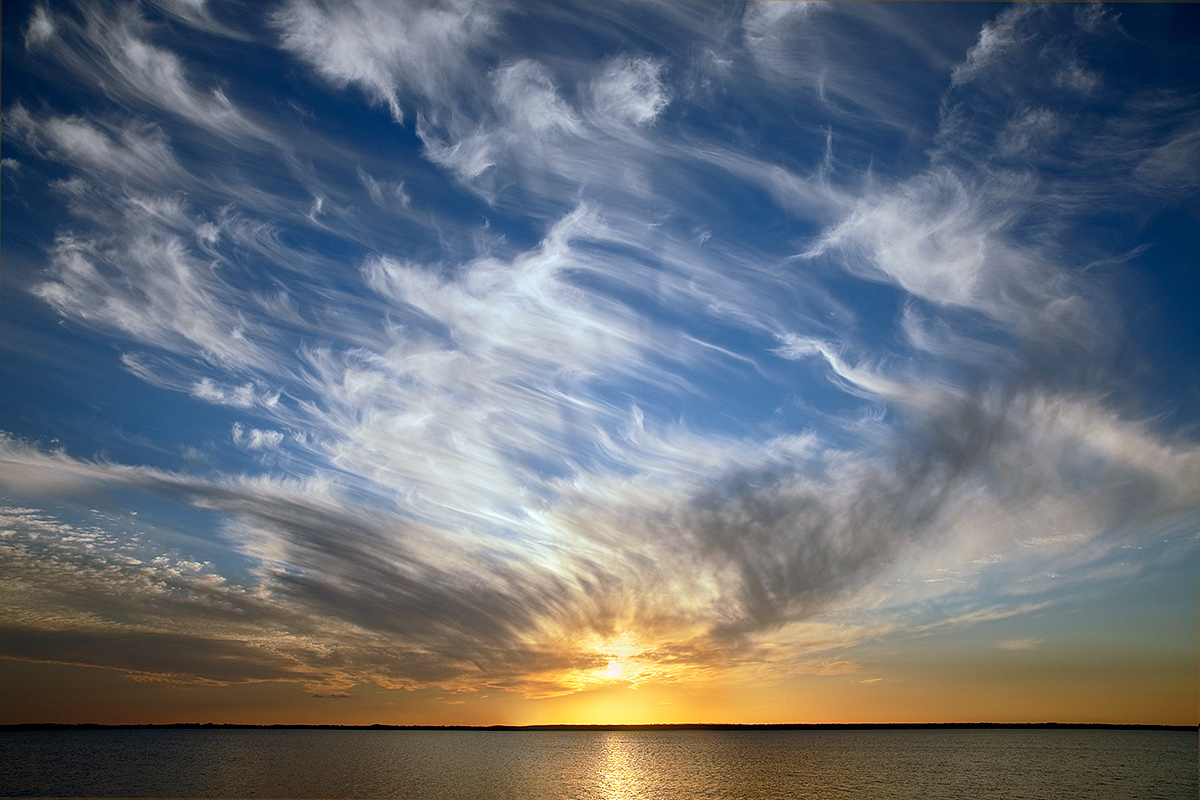
|
|
This image was created at 7:23pm on Saturday April 12, 2014 aboard Jim Neiger’s customized pontoon boat with the Canon EF 24-70mm f/2.8L II USM lens (hand held at 24mm) and the Canon EOS 5D Mark III. ISO 800. Evaluative metering +2/3 stop as framed: 1/2500 sec. at f/5.6 in Av mode. Color temperature: 10,000K.
Central sensor/AI Servo/Surround Rear Focus AF on the horizon line and re-compose. Click here to see the latest version of the Rear Focus Tutorial. Click on the image to see a larger version.
Image #1:It’s All About the Clouds
|
One Business You Do Not Want to Get Into
We first noticed the swirly clouds at about 5pm. By 7:30, most were–going by the gorgeous patterns of the light clouds on the eastern horizon, predicting a killer colorful sunset. Though I agreed, I did caution: “One business that you do not want to get into is predicting sunset color….”
Within 20 minutes, my caution rang true.
Image Optimization Note
I wanted to try adding a reduced opacity later of Auto Contrast (ALT-SHIFT-CNTRL L) as taught to me by Denise Ippolito) but I accidentally hit SHIFT-CNTRL L. Wow, that really popped the BLUEs, similar to what White Neutralizer does in NIK but a lot faster. A bit of searching showed that I had hit the default keyboard shortcut for Auto Tone. I reduced the opacity to 80% and was thrilled with my new discovery. I shall not forget it.
|
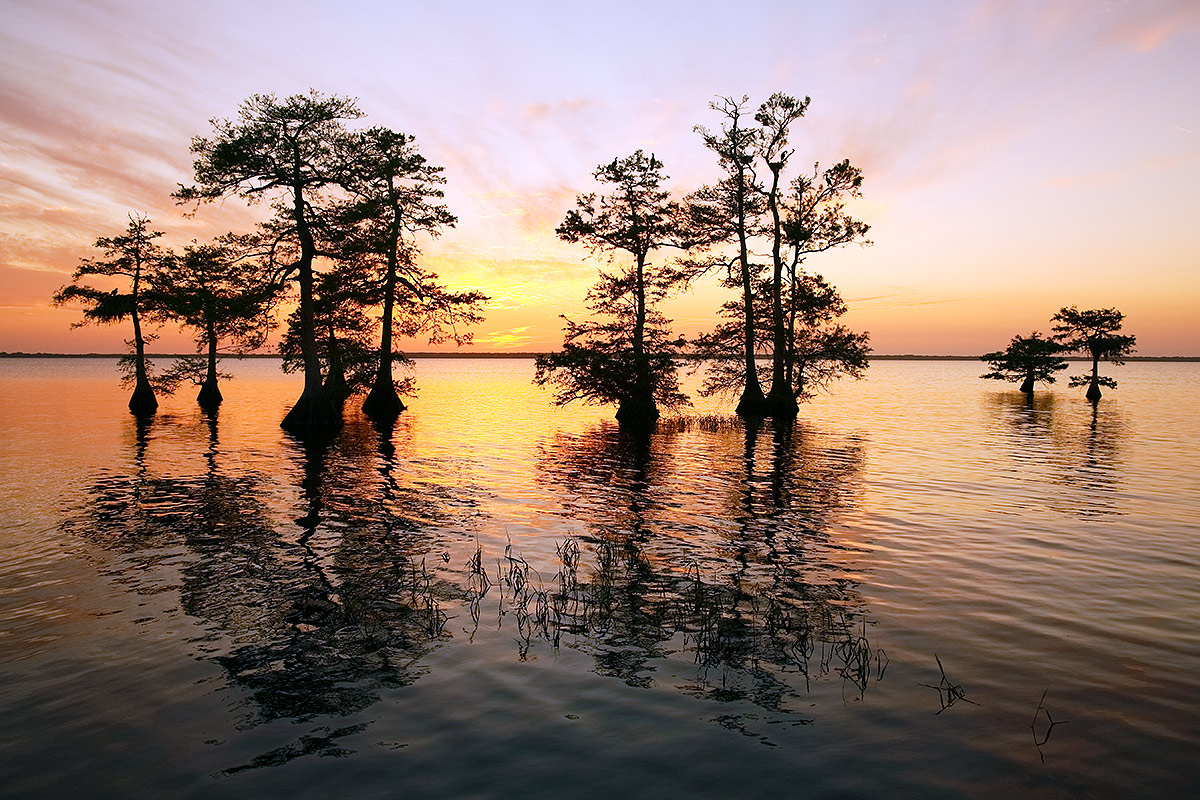
|
|
This image was created at 7:45pm on Saturday April 12, 2014 aboard Jim Neiger’s customized pontoon boat with the Canon EF 24-70mm f/2.8L II USM lens (hand held at 26mm) and the Canon EOS 5D Mark III. ISO 800. Evaluative metering +1 1/3 stops: 1/640 sec. at f/4 in Av mode. Color temperature: 10,000K.
Three sensors to the left of the central sensor/AI Servo/Surround Rear Focus AF as framed active at the moment of exposure. Click here to see the latest version of the Rear Focus Tutorial. Click on the image to see a larger version.
Image #2: Cypress Trees Straight Up
|
Straight Up
Once Jim positioned the boat grabbing the 24-70 and going wide with it was the obvious choice. With a bit of color above the horizon I went with the traditional approach by creating a sharp image.
Image Question
What 2 species of birds can be identified in this photo? Note: clicking on the image to enlarge it will help.
|
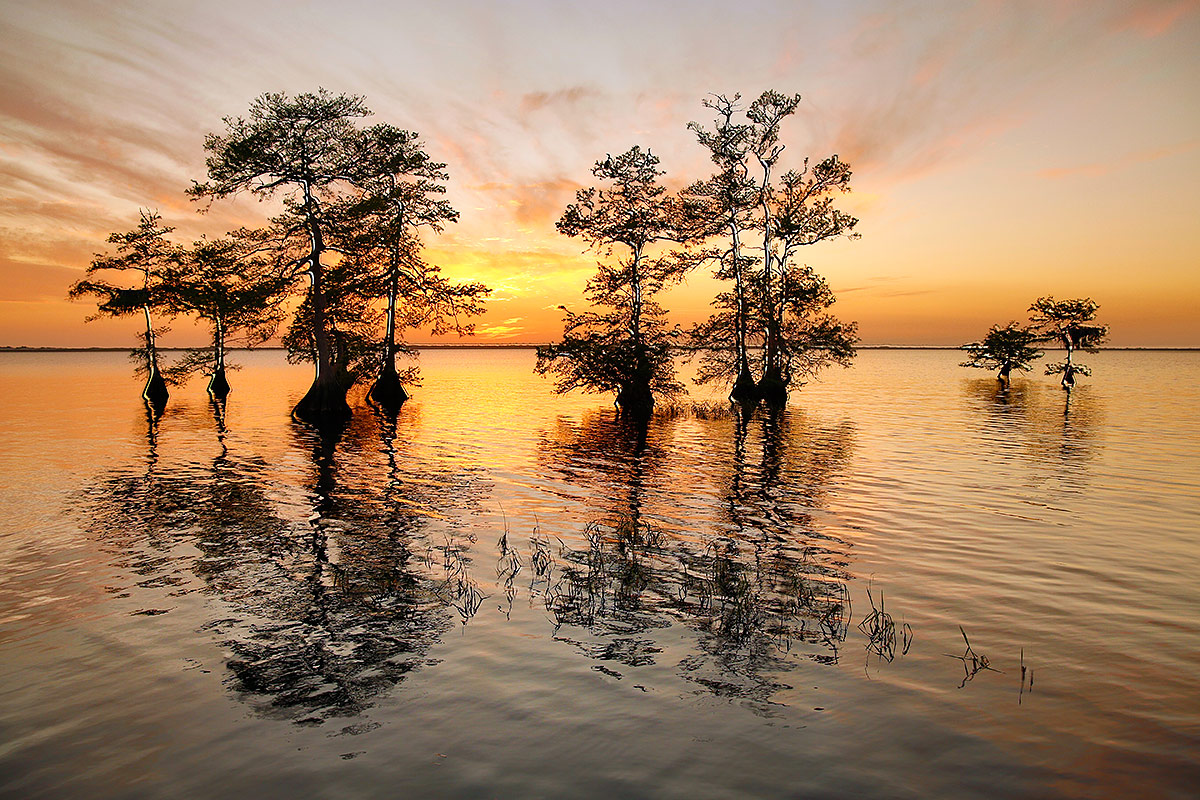
|
|
This 3-frame in-camera HDR Art Vivid image was created at 7:46pm on Saturday April 12, 2014 aboard Jim Neiger’s customized pontoon boat with the Canon EF 24-70mm f/2.8L II USM lens (hand held at 24mm) and the Canon EOS 5D Mark III. ISO 800. Evaluative metering +1 2/3 stops: 1/125 sec. at f/4 in Av mode. Color temperature: 10,000K.
Three sensors to the left of the central sensor/AI Servo/Surround Rear Focus AF as framed were active at the moment of each exposure. Click here to see the latest version of the Rear Focus Tutorial. Click on the image to see a larger version.
Image #3: Cypress Trees HDR Art Vivid Funky Outlines
|
What to Do With a Fizzle?
In-camera Art Vivid HDR
My first thought was to boost the color by going in-camera HDR Art Vivid, offered only in the Canon EOS-D Mark III. I know that with the boat rocking that both the horizon line and the trees would feature funky black outlining. I was right.
|
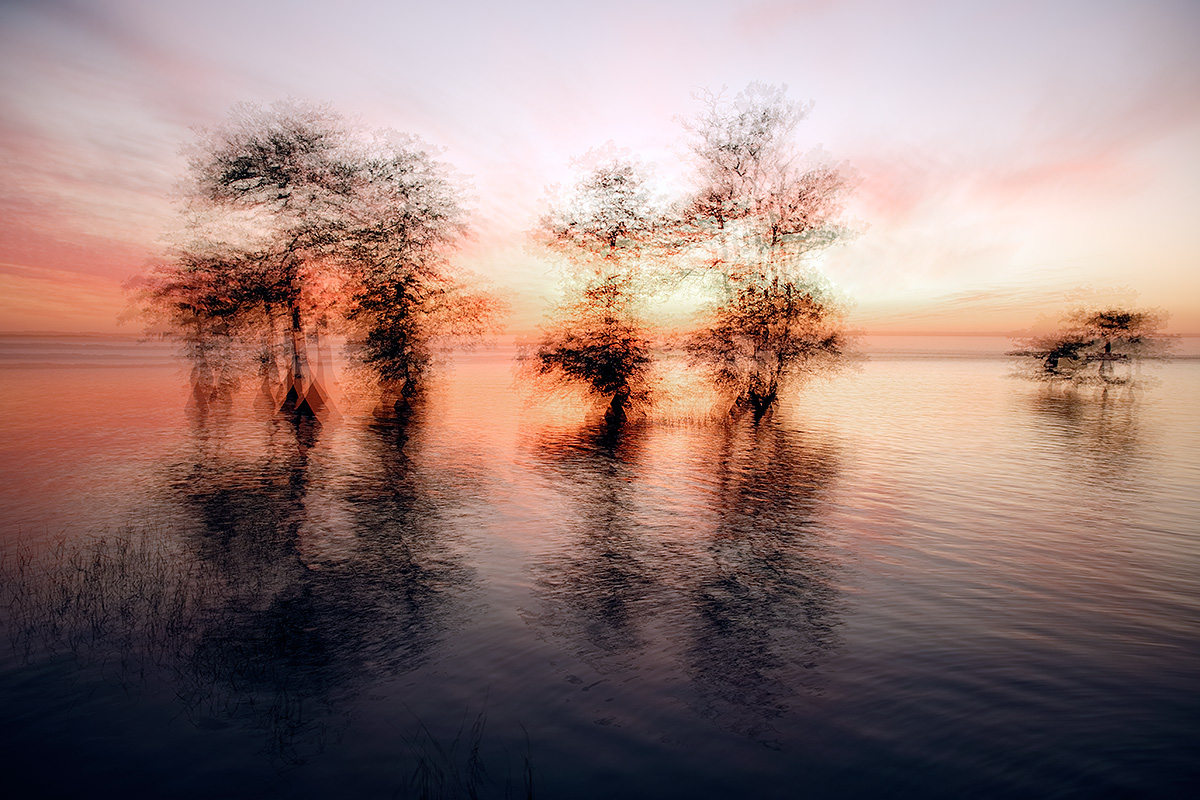
|
|
This 5-frame in-camera multiple exposure was created at 7:53pm on Saturday April 12, 2014 aboard Jim Neiger’s customized pontoon boat with the Canon EF 24-70mm f/2.8L II USM lens (hand held at 26mm) and the Canon EOS 5D Mark III. ISO 800. Evaluative metering +1 2/3 stops: 1/125 sec. at f/4 in Av mode. Color temperature: 10,000K.
Three sensors to the left of the central sensor/AI Servo/Surround Rear Focus AF as framed active at the moment of exposure. Click here to see the latest version of the Rear Focus Tutorial. Click on the image to see a larger version.
Image #4: Ghost Cypress Trees
|
What to Do With a Fizzle?
In-camera Multiple Exposure
Just for the heck of it I decided to try an in-camera Multiple Exposure. The first one looked quite ghostly so I created 5 more. This one is my favorite.
Your Favorite
After enlarging each image, please take a moment to let us know which one you like best and why.
The Feather Button
I access both the in-camera HDR feature and the in-camera Multiple Exposure feature via the Artist’s Brush button on the back of the 5D Mark III. Learn everything that there is to know about these 2 great features, everything that there is to know about the 5D III’s great new AF system, and pretty much everything that there is to know about this great camera in our 5D MK III User’s Guide.
Get a Free Copy of Our 5D Mark III User’s Guide
Purchase a Canon EOS-5D Mark III using one of our product-specific B&H affiliate links above or by clicking on the logo link below and shoot me your B&H receipt via e-mail. Once and if the purchase appears in my account–it should unless you screwed up somehow and did not use the link :), I will be glad to have Jim send you a free copy of our 5D Mark III User’s Guide.
|

|
|
Join me at Gatorland for a ton of learning. If you want to learn to use your flash, you will not want to miss this one. Click on the composite image to enjoy a larger version. Click on the composite to enjoy the larger size.
|
Another Gatorland Short Notice Saturday Full-Day In-the-Field Workshop
Saturday May 3, 2014. 7:15am till 10:15am & 4:00pm till dusk. Lunch, image review, and Photoshop session included. Limit 6. A very small group is again likely: $399.
The cost of your Gatorland Photographer’s Pass is not included.
Chicks in nests likely. Breeding plumage Cattle and Snowy Egrets. And tons more. You will learn to spot the good situations, to choose the best perspective, to see and understand the light, to get the right exposure every time after making a single test exposure, and to design pleasing images by mastering your camera’s AF system. A big part of the above is that you will learn how and why you must work in Manual mode 90% of the time at Gatorland.
At lunch we will review my images, take a look at five of your best images from the morning session (for those who opt to bring their laptops), and process a few of my images in Photoshop after converting them in DPP. That followed by Instructor Nap Time. Last Saturday all 3 folks had a great time and learned a ton. And the weather for this coming Saturday is looking good.
Payment in full via credit card is due upon registering. Please call Jim or Jennifer at 863-692-0906 to register.
Support the BAA Blog. Support the BAA Bulletins: Shop B&H here!
We want and need to keep providing you with the latest free information, photography and Photoshop lessons, and all manner of related information. Show your appreciation by making your purchases immediately after clicking on any of our B&H or Amazon Affiliate links in this blog post. Remember, B&H ain’t just photography!
….. …..
Typos
In all blog posts and Bulletins, feel free to e-mail or to leave a comment regarding any typos, wrong words, misspellings, omissions, or grammatical errors. Just be right. 🙂
April 14th, 2014 The Streak Continues
Well. I am starting to think about packing for my flights to Holland leaving Orlando on Tuesday afternoon and getting into Amsterdam on Wednesday morning. The Holland Tulip IPT begins on Thursday afternoon.
This post marks 136 straight days with a new educational blog post. With so many folks getting in the habit of using our B&H links and our Amazon logo-links why quit now? To show your appreciation for my efforts here, we do ask that you use our the B&H and Amazon affiliate links on the right side of the blog for all of your purchases. Please check the availability of all photographic accessories in the BIRDS AS ART Online Store, especially Gitzo tripods, Wimberley tripod heads, and the like. We sell only what I used, tested, and can depend on. We will not sell you junk. We know what you need to make creating great images easy and fun. And we are always glad to answer your gear questions via e-mail.
You can find the following items in the store: Gitzo tripods, Mongoose M3.6 and Wimberley heads, plates, low feet, and accessories, flash brackets, , Delkin e-film Pro Compact Flash Cards, LensCoat products, and our unique line-up of educational materials including ABP I & II, Digital Basics, Site and Set-up e-Guides, Canon and Nikon Camera Users and AF e-Guides, and MP-4 Photoshop video tutorials among others.
I would of course appreciate your using our B&H affiliate links for all of your major gear, video, and electronic purchases. For the photographic stuff mentioned in the paragraph above we, meaning BAA, would of course greatly appreciate your business. Here is a huge thank you to the many who have been using our links on a regular basis and visiting the BAA Online store as well.
This blog post took 3 1/2 hours to put together. Enjoy!
|
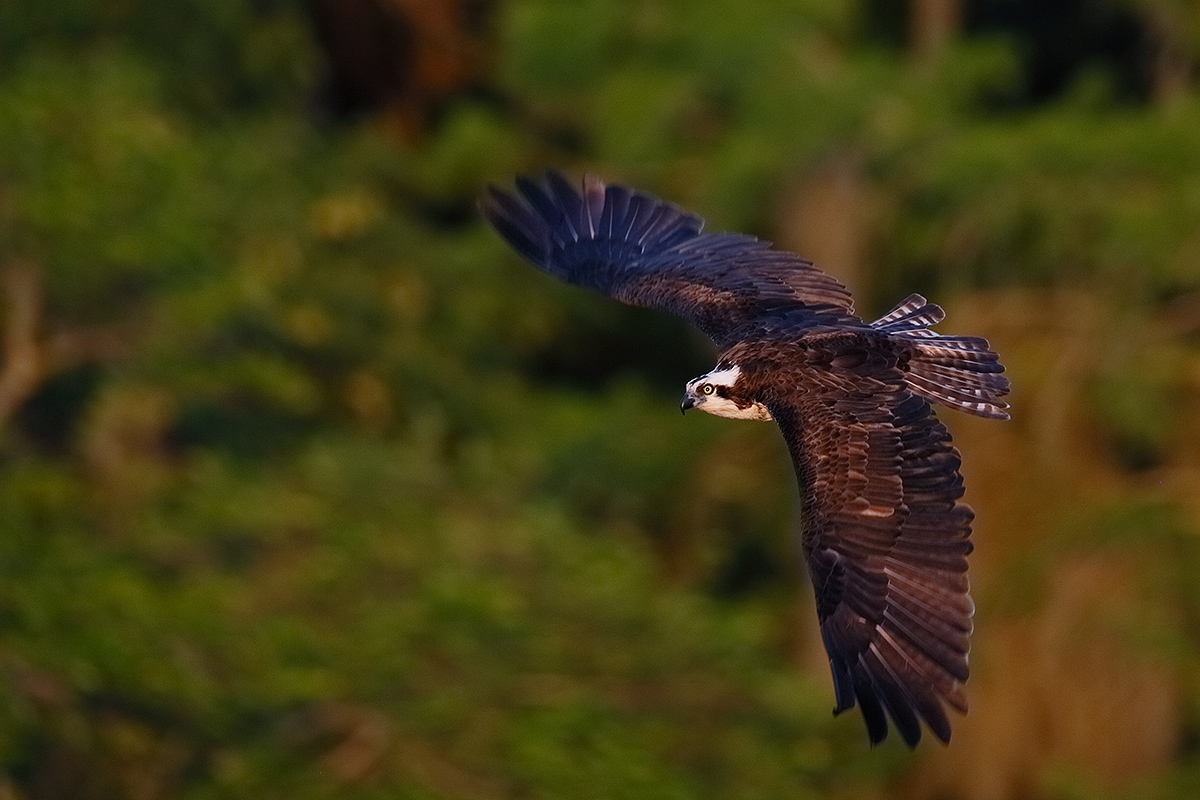
|
|
This Osprey top shot was created very late in the day (7:30pm) on a mostly clear afternoon on Lake Blue Cypress on Saturday, April 12. There were five of us aboard Jim Neiger’s pontoon boat. I used the hand held Canon EF 300mm f/2.8L IS II USM lens, the Canon Extender EF 2X III, and the Canon EOS-1D X. ISO 1600. Evaluative metering -1/3 stop off the green vegetation: 1/640 sec. at f/5.6 in Manual mode. AWB.
Central Sensor/AI Servo-Surround/Rear Focus AF as originally framed was active at the moment of exposure. The image was cropped from behind and from above. Learn everything there is to know about the 1D X and 5D III AF systems including how to manage the various AF Area Selection Modes, when to use which one, and several ways to move the AF sensor around in my 1D X AF Guide and the 5D Mark III User’s Guide. Click here to see the latest version of the Rear Focus Tutorial. Click on the image to see a larger version. .
|
The Story
On Saturday afternoon, after three great flight photography sessions while hand holding the Canon EF 200-400mm f/4L IS USM lens with Internal 1.4x Extender the muscles along the back of my neck and shoulders ached. Actually, I was totally beat by the end of Friday, the first of the two days on Jim Neiger’s pontoon boat. And Saturday morning was by far the best osprey flight photography session that I have ever enjoyed.
Clear and sunny conditions on Saturday afternoon featured very little in the way of flight photography as a strong east wind resulted in all the birds flying and landing away from us and away from the light. With wind against sun sometimes you need to lie down on the bottom of the boat and take a nap. And that is exactly what I did. By 6:30pm the wind had abated a bit and Jim took us to a nice sheltered spot with Osprey and Barred Owl. We had seen a Barn Owl there on Friday afternoon. It was a first-ever Florida sighting for both Jim and me. And even more amazingly, the Barn Owl was attacked by a Barred Owl. On Saturday afternoon we saw the area Peregrine attack one of the Barred Owls. At one point the Peregrine flared right in front of us offering a killer photo opportunity. As nobody had seen it coming only Jim Neiger got a frame, but that only after the bird had turned away. In retrospect we all agreed that the handsome falcon had magically appeared out of nowhere.
|
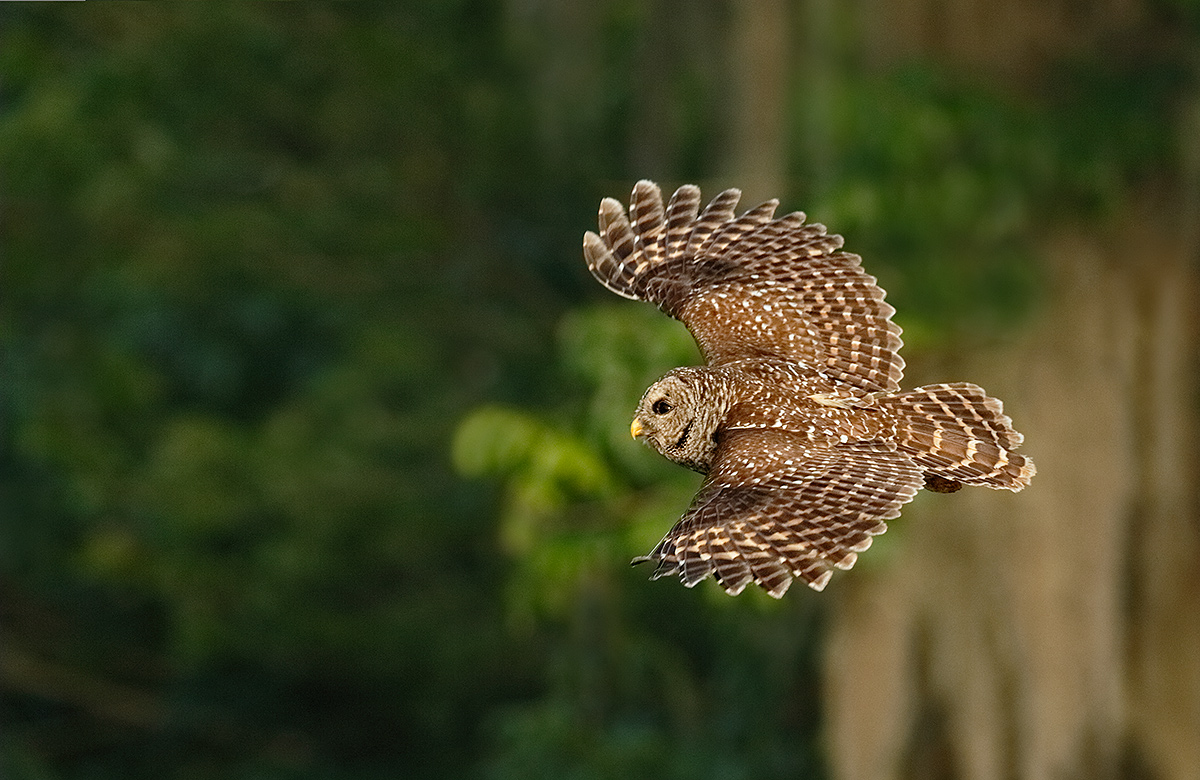
|
|
This Barred Owl top shot was created late in the day (6:45pm) on a mostly clear afternoon on Lake Blue Cypress on Saturday, April 12 aboard Jim Neiger’s pontoon boat. I used the hand held Canon EF 300mm f/2.8L IS II USM lens, the Canon Extender EF 2X III, and the Canon EOS-1D X. ISO 1600. Evaluative metering – about 1 1/3s stop off the green vegetation: 1/1600 sec. at f/6.3 in Manual mode was a large underexposure error. DPP did a nice job of controlling the noise in the dark areas. AWB.
Central Sensor/AI Servo-Surround/Rear Focus AF on the base of the owl’s tail as originally framed was active at the moment of exposure. The image was cropped from behind and from above and below. Learn everything there is to know about the 1D X and 5D III AF systems including how to manage the various AF Area Selection Modes, when to use which one, and several ways to move the AF sensor around in my 1D X AF Guide and the 5D Mark III User’s Guide. Click here to see the latest version of the Rear Focus Tutorial. Click on the image to see a larger version. .
|
The Canon 300mm f/2.8L IS II/2X III/1D X: An Unexpectedly Viable Rig for Hand Held Flight Photography
In any case, by Saturday afternoon I was too tired to even think about lifting the 200-400. I did have the 300mm f/2.8L IS along and remembering the success that Denise Ippolito had had with that combo in Japan, I grabbed it and one of my 2X III TCs and went to work. At 5.19 pounds, the 300 II is 2.79 lbs. lighter than the 7.98 pound 200-400 zoom. Thus, hand holding it for flight was a dream; seemingly light as a feather it was much easier for me to acquire the bird in the frame and to keep the image properly framed.
Initial focusing acquisition with the 1D X was very fast as would be expected with any pro body. The speed of Initial focusing acquisition, however, would not be as fast with a 5D III or a 7D as the battery voltage is lower with the pro-sumer bodies. Even with two batteries in the vertical grip the situation would not improve as the camera uses only one battery at a time. AF tracking was accurate, and, as you can see here, image sharpness was excellent. This due in to the 300 II’s great 4-stop IS system and in part to the superb sharpness of the prime lens. As most of my flight images with the 200-400 were made at 560mm I will in the future turn to the 300 II/2X III/1D X combination more often for flight photography especially when the need for reach is paramount.
|

|
|
All of the images created at the St. Augustine Alligator Farm and copyright Arthur Morris/BIRDS AS ART
From top left clockwise to center: Snowy Egret pair in breeding plumage, breeding plumage Cattle Egret with fill flash, large Great Egret chicks in the nest, killer breeding plumage Snowy Egret displaying, flash-as-main light Great Egret chick happy to see mom, Little Blue Heron chicks, Cattle Egret breeding plumage head portrait, flash flight Wood Stork with nesting material, Great Egret landing at the nest, large Snowy Egret chicks.
Click on the image to enjoy a larger version.
|
St. Augustine Alligator Farm Short-Notice IPT. 3-FULL DAYS. Early entry/Late stay. May 5-7, 2014. Meet and greet at 8pm on Sunday May 4: $1299. Two Great Leaders: Arthur Morris and Denise Ippolito
This trip needs four to run.
Breeding herons, egrets, and Wood Storks. Eggs and chicks in the nest. Some fledged young possible. Breeding behaviors including displaying and copulations. Flight and flash flight. Great Egret, Snowy Egret, Little Blue Heron, Cattle Egret, Tricolored Heron, Wood Stork. Early May rocks at the Farm as the weather is usually gorgeous and there should be lots of both small and large chicks in the nest. And you avoid the possibly oppressive heat of June and July.
Includes in-the-field instruction, early entry, late stay, $5/person late-stay gratuity, informal, small group Photoshop and image review sessions. Three lunches.
Not included: your lodging, your St. Augustine Alligator Farm photographer’s pass ($79.95 for the year); we will be more than glad to pre-order your pass for you. Please let us know when you register.
What you will learn:
How to see the good situations.
How to best avoid the clutter of a rookery by choosing the very best perspective.
How to properly evaluate the histogram and come up with the right exposure every time after making a single test exposure
How to see and understand the light.
How to design pleasing images by mastering your camera’s AF system.
Why you must work in Manual mode 95% of the time when photographing at a rookery and how to do it.
How to evaluate and process your images.
Via intensive instruction how to use fill flash flash as main light, and Manual flash.
Flash flight techniques including the necessary use of high speed sync.
And tons more.
Please call Jim or Jen at 863-692-0906 to hold your spot with your non-refundable $299 credit card deposit and then put your check in the mail along with your signed registration form; you can find the form here.
Suitable airports: Jacksonville (JAX), Daytona Beach (DAB), Orlando MCO).
We look forward to seeing you in the nation’s oldest city for three days of fun and learning.
Note: Folks interested in possibly continuing on to Fort DeSoto–great in spring, are invited to shoot me an e-mail.
Support the BAA Blog. Support the BAA Bulletins: Shop B&H here!
We want and need to keep providing you with the latest free information, photography and Photoshop lessons, and all manner of related information. Show your appreciation by making your purchases immediately after clicking on any of our B&H or Amazon Affiliate links in this blog post. Remember, B&H ain’t just photography!
….. …..
Typos
In all blog posts and Bulletins, feel free to e-mail or to leave a comment regarding any typos, wrong words, misspellings, omissions, or grammatical errors. Just be right. 🙂
April 13th, 2014 The Streak Continues
We had a great morning on Lake Blue Cypress on Saturday with dozens of opportunities to photograph landing Ospreys; both the light–the sun was filtered by light clouds, and the wind–from the east/northeast, were perfect. Multiple IPT veterans included Aaron Chandler and the amazingly talented Clemens van der Werf. They were joined by first-timer Michael Tapes of Lens Align fame. Captain Jim Neiger did his usual stellar job of piloting the boat and getting us in perfect position.
This post marks 135 straight days with a new educational blog post. With so many folks getting in the habit of using our B&H links and our Amazon logo-links why quit now? To show your appreciation for my efforts here, we do ask that you use our the B&H and Amazon affiliate links on the right side of the blog for all of your purchases. Please check the availability of all photographic accessories in the BIRDS AS ART Online Store, especially Gitzo tripods, Wimberley tripod heads, and the like. We sell only what I used, tested, and can depend on. We will not sell you junk. We know what you need to make creating great images easy and fun. And we are always glad to answer your gear questions via e-mail.
You can find the following items in the store: Gitzo tripods, Mongoose M3.6 and Wimberley heads, plates, low feet, and accessories, flash brackets, , Delkin e-film Pro Compact Flash Cards, LensCoat products, and our unique line-up of educational materials including ABP I & II, Digital Basics, Site and Set-up e-Guides, Canon and Nikon Camera Users and AF e-Guides, and MP-4 Photoshop video tutorials among others.
I would of course appreciate your using our B&H affiliate links for all of your major gear, video, and electronic purchases. For the photographic stuff mentioned in the paragraph above we, meaning BAA, would of course greatly appreciate your business. Here is a huge thank you to the many who have been using our links on a regular basis and visiting the BAA Online store as well.
This blog post took 3 1/2 hours to put together. Enjoy!
|
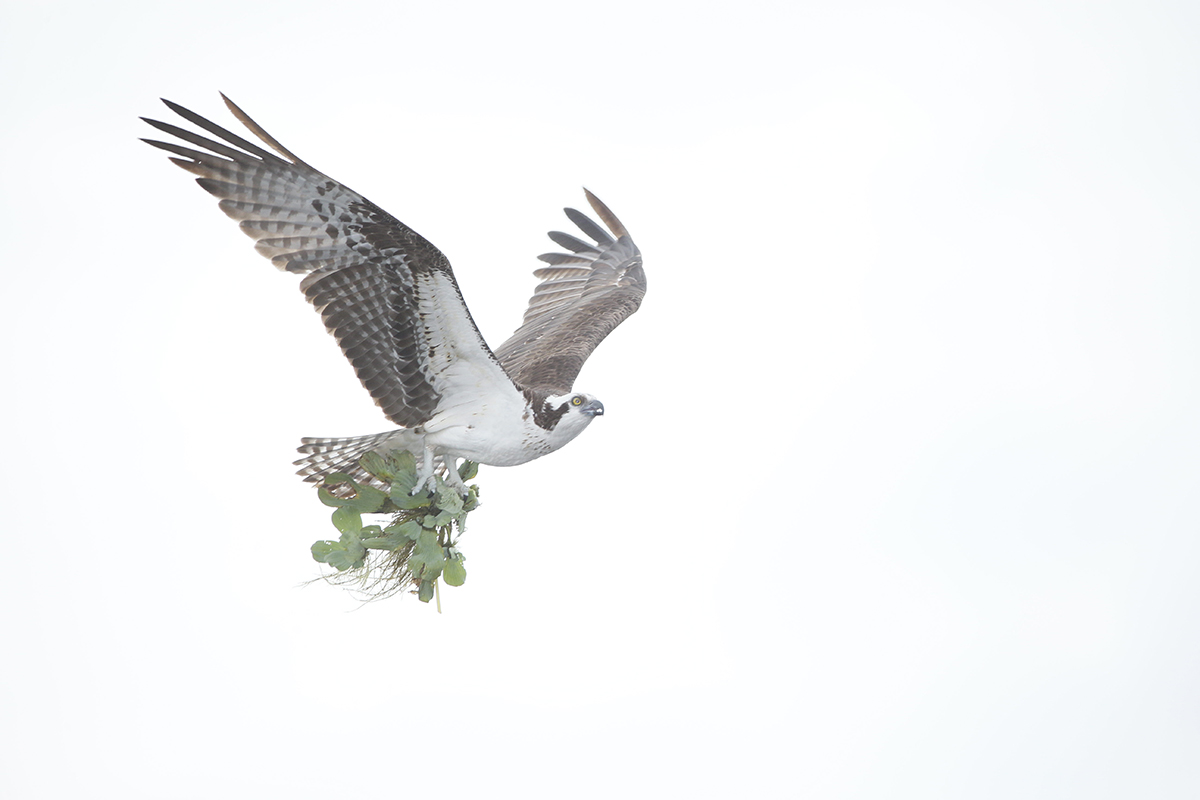
|
|
This image was created on a cloudy dark afternoon on Lake Blue Cypress on Friday afternoon April 11, 2014 at 3:02pm. There were five of us aboard Jim Neiger’s pontoon boat. I used the hand held Canon EF 200-400mm f/4L IS USM Lens with Internal 1.4x Extender (with the internal TC engaged at 560mm) and the Canon EOS-1D X. ISO 1600. Evaluative metering +3 1/3 stops off the white sky: 1/1250 sec. at f/5.6 in Manual mode. AWB.
Fill flash with Better Beamer using manual flash at 1:2 with High SPeed Synch with the Canon Speedlite 600EX-RT with the Canon CP-E4 Compact Battery Pack for faster re-charging times. With all that the flash did not do much….
Central Sensor/AI Servo-Surround/Rear Focus AF on the bird’s face active at the moment of exposure. Learn everything there is to know about the 1D X and 5D III AF systems including how to manage the various AF Area Selection Modes, when to use which one, and several ways to move the AF sensor around in my 1D X AF Guide and the 5D Mark III User’s Guide. Click here to see the latest version of the Rear Focus Tutorial. Click on the image to see a larger version. .
|
The Situation
It was cloudy dark; the conditions for photographing Osprey in flight were poor at best. But knowing the amazing capabilities of digital, I felt that there were good images to be made. I metered off the dreary white sky and set my exposure manually to +3 1/3 stops. I needed ISO 1600 to get a shutter speed of 1/1250 sec. I added High Speed Sync flash in hopes that by using the flash at full power, 1:1 in manual mode, that at least some flash would hit the bird. It did not.
Exposing to the Right
When we teach folks to expose to the right we explain that in low light situations their images will look washed out on the back of the camera and washed out when they see them on a computer; see the image above for a perfect example. We continue by explaining that images that are exposed to the right will contain more data than images that are exposed darker and look pretty good on the back of the camera, that they will have less noise, and will produce higher quality image files and prints. At times, as you will see below, it is necessary to completely over-expose a white sky in order to come up with the best exposure for the subject.
|
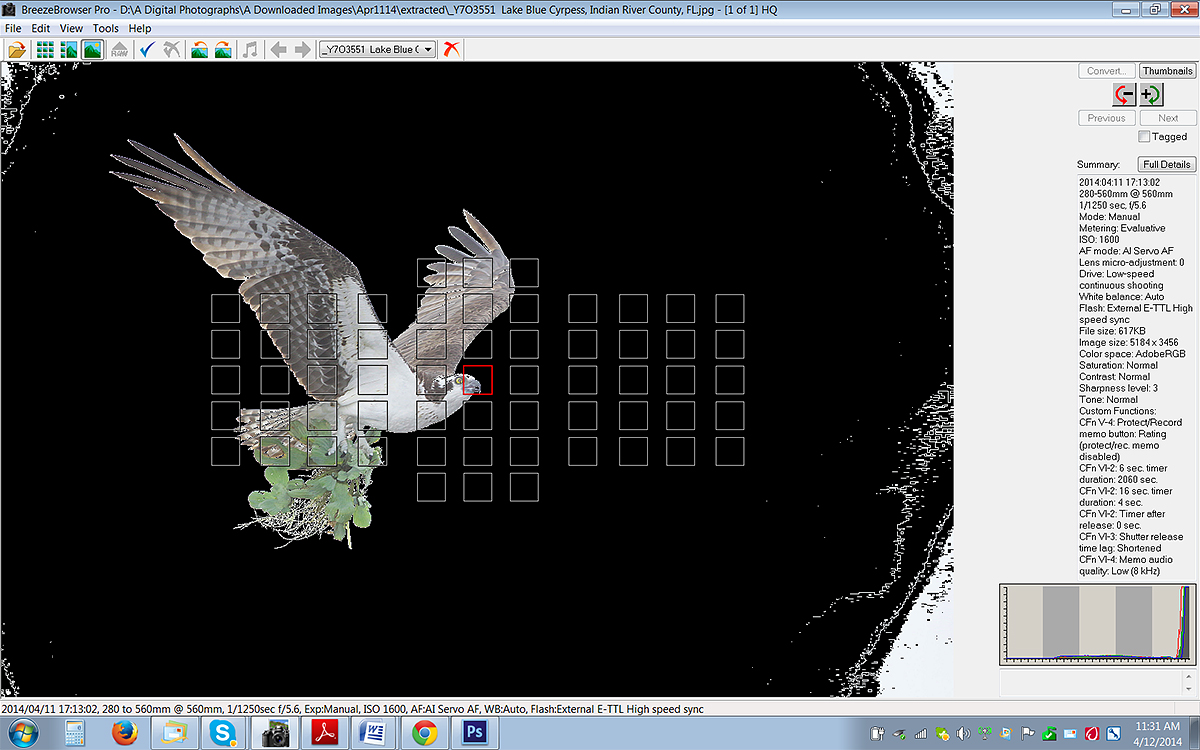
|
|
This is the BreezeBrowser Main View of today’s image.
|
Creating a High Key Image
I created the BreezeBrowser Main View screen capture above while the sky was flashing black indicating a large overexposure. Most of the sky was rendered with RGB values of 255, 255, 255, detail-less white. To create the high key look below with the best exposure for the subject that is exactly what I wanted. As above, if your image looks washed out on the back of the camera it will likely be your best exposure. Here is a very fine: this image showed some vignetting from being created at the wide open aperture, f/5.6. In the screen capture the vignetting is represented by the white splotches in the corners. You can also see the vignetting by looking at the image that opens this post: the corners are darker than the rest of the sky and show some CYAN artifacting. The vignetting was eliminated during the RAW conversion in DPP by checking the Peripheral Illumination box and adjusting the slider. You can find Peripheral Illumination in the Lens Aberration Correction section under the Lens tab.
The illuminated red square shows the AF point that was selected. Note: in Breezebrowser you need to check “Show Focus Points” under View to activate this feature. To see the focus points in DPP check “AF Point” under View or hit Alt L. Hit Alt M in DPP to see Highlight Alert. To learn how and why I use DPP (Canon Digital Photo Professional) to convert my RAW files, see the info on our DPP RAW Conversion Guide here.
Note that the WHITEs in the histogram are pegged up against right side of the histogram; this indicates overexposure of the WHITEs. But again, for this high key image, that is exactly what I wanted.
BreezeBrowser
Regular readers know that I use and depend on BreezeBrowser every day of the year. It allows me to sort my keepers and delete the rejects faster than any other Windows browsing program. We use it on the main computer in the home office to catalog our images file-drawer style. And the companion program, Downloader Pro allows me to download my images quickly and conveniently. It automatically adds my IPTC data and the shooting location. I have it set up to create a folder named by the Month/date/year. The Breezebrowser/Downloader Pro combo saves me many hours each week. To learn more or to purchase this great PC only program, click here. As far as the BreezeBrowser/Downloader Pro Combo goes, if you are using a Windows platform and are not using these two great programs you are at best, wasting your valuable time. My understanding is that Photo Mechanic is best for Mac-users who do not opt to run Parallels or VM Ware fusion on their Macs so that they can enjoy the many advantages of BreezeBrowser. See BreezeBrowswer on a Mac for details.
|
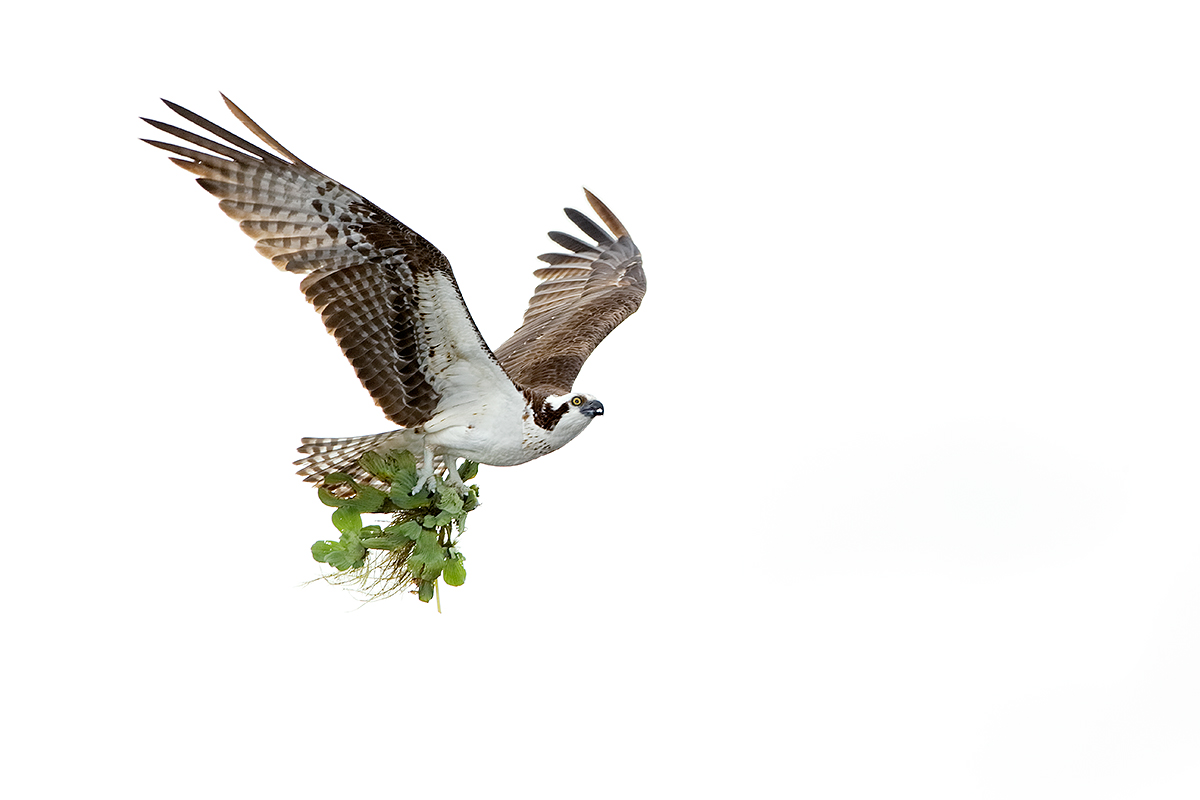
|
|
This is the optimized image. Be sure to click on it to view the spectacular larger version.
|
Burn the Sky and Wind Up in (Osprey) Heaven…
The Image Optimization
Once I converted the RAW file I brought the washed out image into Photoshop 6. While working on a Levels adjustment layer I pulled in the Shadow slider while holding down the ALT key and backed off a bit when I noticed the first speckles. That gave the image some much needed punch. Next was a layer of my NIK 50/50 Tonal Contrast/Detail Extractor recipe on the bird only. (I used the Quick Selection Tool to select the bird.) That was followed by adding 4 points of BLACK to the BLACKs and the NEUTRALs in Selective Color, the latter done by hitting the f/9 key twice to run my Selective Color action. Then a bit of Eye Doctor work and a contrast mask on the face only (by painting a Quick Mask of the face) put the finishing touches on what I consider a very fine image made in difficult conditions.
The DPP RAW Conversion Guide
To learn why I use Canon’s Digital Photo Professional (DPP) to convert every image that I work on, click here.
Digital Basics
Are you tired of making your images look worse in Photoshop? Do you have no clue as to how I optimized the image above? The Photoshop stuff mentioned above plus tons more is detailed in my Digital Basics File, an instructional PDF that is sent via e-mail. It includes my complete digital workflow, dozens of great Photoshop tips, the use of Contrast Masks, several different ways of expanding canvas, all of my time-saving Keyboard Shortcuts, Quick Masking, Layer Masking, and NIK Color Efex Pro basics, my killer image clean-up techniques, Digital Eye Doctor, creating time-saving actions, and lots more.
APTATS I & II
Learn the details of advanced Quick Masking techniques in APTATS I. Learn Advanced Layer Masking Techniques in APTATS I. Mention this blog post and apply a $5 discount to either with phone orders only. Buy both APTATS I and APTATS II and we will be glad to apply at $15 discount with phone orders only.
Remember: Expose to the Right
Remember to expose to the right. If you have ten seconds with a subject in the same light, there are no hard exposures with digital. Just get some data well into the rightmost histogram box and you will have an exposure that you can work with to produce a high quality image file. You can learn everything that you need to know about exposure theory in original classic, The Art of Bird Photography and in the Exposure Simplified section of The Art of Bird Photography II (ABP II:916 pages, 900+ images on CD only). You can save $10 by purchasing the 2-book bundle here.
|
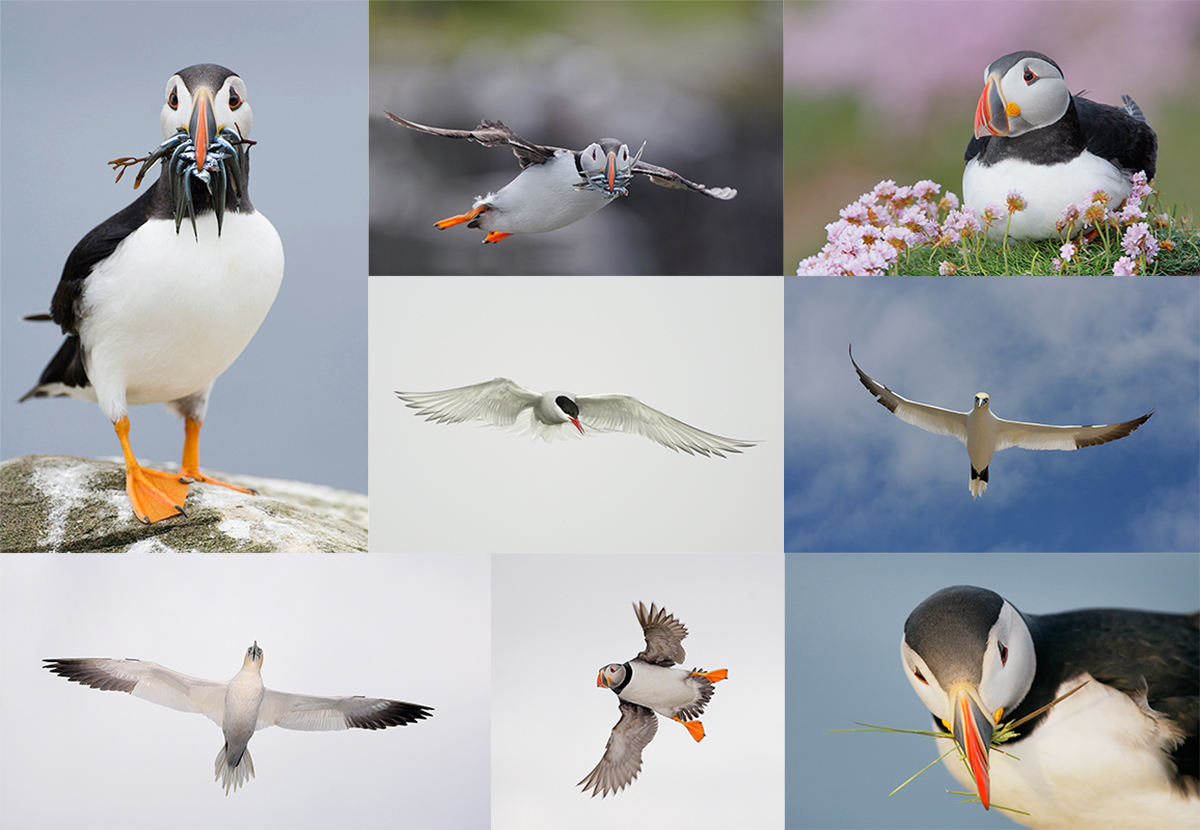
|
|
I hope that you can join us on this great trip. The vertical puffin image was created by David Tipling. The rest–almost all from the UK, are mine :).
|
UK Puffins and Gannets IPT July 2-9, 2014. 5 full days of puffins and two half-days of gannet boat photography: $4,999 USD. Limit 10 + the 2 leaders.
Desperately seeking: 1 female roommate & 1 male roommate.
With 5 folks registered, this trip is a go.
Fly to Edinburgh (say “ED-in-BRUH”), Scotland on a red eye flight on July 1st arriving on the early morning of July 2 or certainly before 10am. UK folks who plan on driving please contact me via e-mail immediately.
There are direct flights to Edinburgh from both Philadelphia and Toronto. If you learn of any others please advise via e-mail so that I may share with all the interested folks. Fly home mid-morning on July 9. UK locals and our many European friends are of course welcome.
With 5 deposits in hand, this trip is a go; you can buy your flights now :).
What’s included:
5 full DAYS on the best UK puffin boat; trips to 2 different islands–all dependent on decent weather, i.e, no major storms. Seabirds including scads of Atlantic Puffin both in flight and perched, Razorbill, Great Cormorant, Shag, and others likely. The trip is timed to maximize the opportunities for photographing the puffins bringing fish back to the nests. All boat fares and landing fees are included. The boat leaves at 9:30am. We have two hours on the first island. We are then picked up and head to the 2nd island for a 2+ hour session. The weather is typically cloudy bright.
One late-afternoon (2 July) and one early morning (probably 8 July) trip on a gannet photography boat where the birds are fed and dive very close to the boat. Both are dependent on good weather but we do have some flexibility. Boat fares and the cost of the fish are covered. Each will consist of a one hour outbound ride, two hours of diving Northern Gannet photography (with 6 boxes of fish) and the one hour return trip.
The tentative, weather-dependent itinerary:
July 2: airport pick-up no later than 10am UK time. Lunch on your dime. Drive to hotel. Afternoon gannet boat trip/time TBD.
July 3, 4, 5, 6, & 7: Full Day Puffin Boat trips as noted above.
July 8: early morning Gannet Boat trip. Afternoon: Small group Image review and Photoshop sessions. Pack for the trip home.
July 9: early morning departure for Edinburgh Airport (EDI).
The itinerary is subject to change to ensure the best possible photographic opportunities.
A super-telephoto lens is not required on this trip. The 300mm f/2.8s are ideal. I will be bringing one along with my 200-400mm with Internal Extender, my 70-200 f/2.8L IS II, and a shorter zoom lenses. Plus three 1.4X and two 2X TCs, a Gitzo 3532 LS Carbon Fiber tripod, and my Mongoose M3.6. I may go tripod-less on the puffin trips at times…. Or not…. All photography on the gannet boat will be hand held. It is likely that the 70-200s will be ideal for the gannets.
7 nights lodging in an older but excellent hotel just a few minutes from the puffin boat dock with about a 70 minute ride to the gannet boat. Double occupancy will be the rule though we might be able to offer a single supplement at an exorbitant price. See the hotel info here.
All breakfasts and dinner (at the hotel) from dinner on July 2 through dinner on July 8. And breakfast on our get-away day unless we need to leave earlier than they serve to make our flights home…
Airport pick-up until 10am on July 2–this should not be a problem as there are lots of red-eye flights from the US to Edinburgh.
All ground transportation. Airport return on the early morning of July 9. We may be getting up very early on July 9th.
Two great leaders; Denise Ippolito and yours truly will provide personalized and small group in-the-field instruction. As usual, the closer you stay to us and the more questions that you ask the more you will learn. We will of course point out the best situations. You will learn to see these great situations for yourself, to get the right exposure every time after making a single test exposure, to work in Manual mode, and to design pleasing images by mastering your camera’s AF system. You will learn the basics of photographing birds in flight and how the relationship between light direction and wind direction impacts the photography of both birds in flight and perched puffins. And tons more.
We will be conducting informal, small group image review and Photoshop sessions after dinner. All are invited to bring their laptops. Image critiques of your five best images will be done after the trip upon request.
Early morning castle photography right near the hotel is an option for the early risers. In the event of inclement weather or stormy seas there is the possibility of bird photography along the coast. Early evening bird photography along the coast is also optional.
Not included: all lunches–for the most part we will need to pack lunches for the puffin trips, or you may opt to skip lunch. Your round trip airfare from home to Scotland. Booze, wine, and any other beverages other than coffee and tea at breakfast.
A non-refundable deposit of $2,000 USD is required to hold your spot so please check on flights and your schedule before committing. The balance will be due on 15 May so you may wish to pay the whole thing at once. Overseas folks may e-mail for wire transfer info. Our $15 wire transfer fee will be added to your balance.
Trip insurance is highly recommended as your deposit (less a $200 cancellation fee) will not be refunded unless the trip fills completely. I, and my family, use Travel Insurance Services.
After letting us know via e-mail that you will be coming, please send your deposit check made out to “Arthur Morris” to us as follows:
Arthur Morris/BIRDS AS ART
PO Box 7245 (US mail) or 4041 Granada Drive (if by courier).
Indian Lake Estates, FL 33855
My friend David Tipling, with multiple BBC honored images and the author of dozens of photo illustrated books, helped with the planning and arrangements for this trip.
If you have any questions, please contact me via e-mail.
Support the BAA Blog. Support the BAA Bulletins: Shop B&H here!
We want and need to keep providing you with the latest free information, photography and Photoshop lessons, and all manner of related information. Show your appreciation by making your purchases immediately after clicking on any of our B&H or Amazon Affiliate links in this blog post. Remember, B&H ain’t just photography!
….. …..
Typos
In all blog posts and Bulletins, feel free to e-mail or to leave a comment regarding any typos, wrong words, misspellings, omissions, or grammatical errors. Just be right. 🙂
April 12th, 2014 The Streak Continues
As you read this, I will be photographing Ospreys for the second straight day on Lake Blue Cypress with Jim Neiger. This time with our second group of 3. It was a real pleasure meeting and photographing with George and Kay Williams, traveling in the southeast while pulling a 30-foot bumper pull travel trailer. Like me, they love their Toyota Sequoia. Joining us was Beth Eldridge who lives with her husband in a 43-foot fifth wheel trailer. They move on average about every six months.
This post marks 134 straight days with a new educational blog post. With so many folks getting in the habit of using our B&H and Amazon links why quit now? To show your appreciation for my efforts here, we do ask that you use our the B&H and Amazon affiliate links on the right side of the blog for all of your purchases. Please check the availability of all photographic accessories in the BIRDS AS ART Online Store, especially Gitzo tripods, Wimberley tripod heads, and the like. We sell only what I used, tested, and can depend on. We will not sell you junk. We know what you need to make creating great images easy and fun. And we are always glad to answer your gear questions via e-mail.
You can find the following items in the store: Gitzo tripods, Mongoose M3.6 and Wimberley heads, plates, low feet, and accessories, flash brackets, , Delkin e-film Pro Compact Flash Cards, LensCoat products, and our unique line-up of educational materials including ABP I & II, Digital Basics, Site and Set-up e-Guides, Canon and Nikon Camera Users and AF e-Guides, and MP-4 Photoshop video tutorials among others.
I would of course appreciate your using our B&H affiliate links for all of your major gear, video, and electronic purchases. For the photographic stuff mentioned in the paragraph above we, meaning BAA, would of course greatly appreciate your business. Here is a huge thank you to the many who have been using our links on a regular basis and visiting the BAA Online store as well.
This blog post took only about 1 1/2 hours to put together. Enjoy!
|
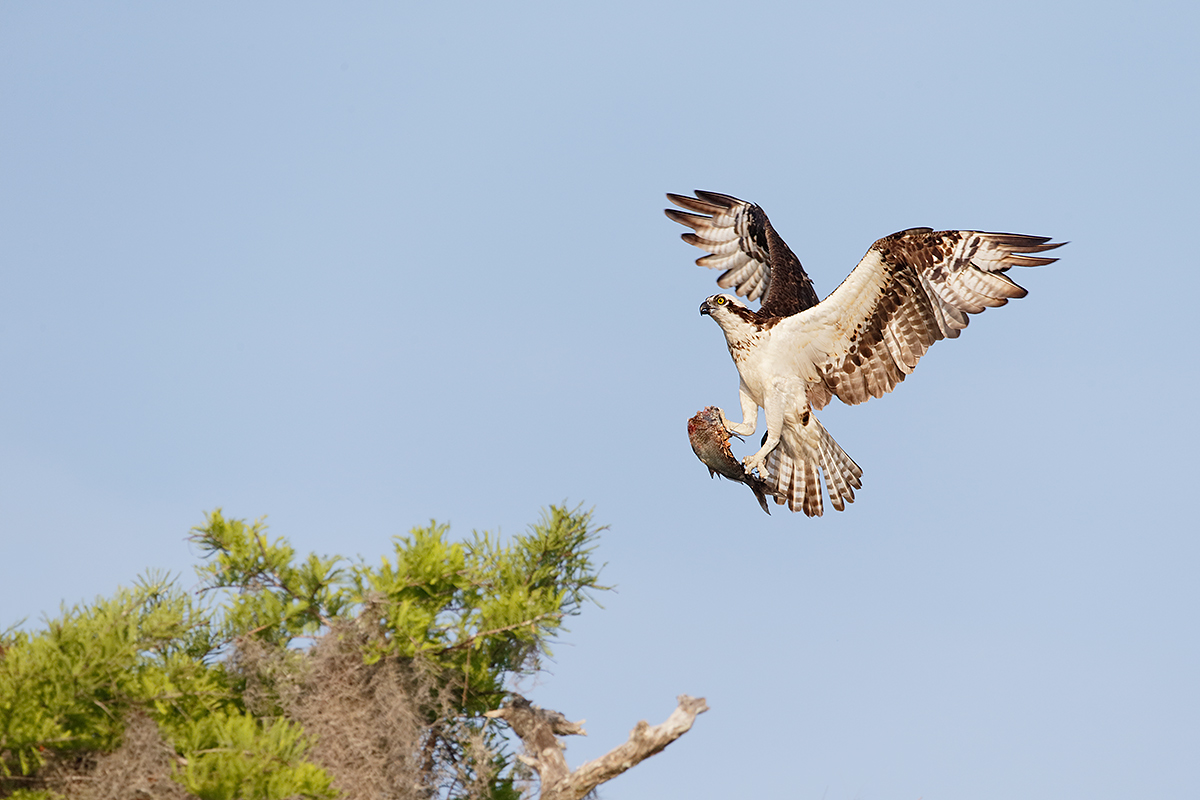
|
|
This image was created on the clear, sunny Friday morning of April 11, 2014 at 8:15am. There were five of us aboard Jim Neiger’s pontoon boat. I used the hand held Canon EF 200-400mm f/4L IS USM Lens with Internal 1.4x Extender (with the internal TC engaged at 560mm) and the Canon EOS-1D X. ISO 400. Evaluative metering +1 stop off the blue sky: 1/1600 sec. at f/7.1 in Manual mode. AWB.
Central Sensor/AI Servo-Surround/Rear Focus AF caught the fish and was active at the moment of exposure. Learn everything there is to know about the 1D X and 5D III AF systems including how to manage the various AF Area Selection Modes, when to use which one, and several ways to move the AF sensor around in my 1D X AF Guide and the 5D Mark III User’s Guide. Click here to see the latest version of the Rear Focus Tutorial. Click on the image to see a larger version. .
|
Two Shining Moments
Congrats to the Connecticut Men’s and Women’s basketball teams on their recent victories in the NCAA National Championship Tournaments, aka March Madness. The men’s teams from Florida and Kentucky were bigger and more athletic than the UConn men but the Huskies were faster, smarter, and more determined. Kudos to coach Kevin Ollie on his superb coaching job. The women finished an undefeated 40-0 season with a victory over previously undefeated Notre Dame. Congrats to the UConn women’s team coach Geno Auriemma on his record ninth national title.
One Shining Moment
We had a tough morning on Lake Blue Cypress. Early on there was not much wind so few Ospreys were flying. And when the wind picked up it was slightly north/northwest; the last thing you want on a clear morning is a wind with any westerly component… That leaves all the birds taking off and landing slightly away from you and from the light. Bad news.
The image above was created in near windless conditions just before the wind switched to the north/northwest. It was our very best landing opportunity of the morning. This was my favorite of an all-sharp eight-frame sequence. It is a small crop from the right and from below.
|

|
|
All of the images created at the St. Augustine Alligator Farm and copyright Arthur Morris/BIRDS AS ART
From top left clockwise to center: Snowy Egret pair in breeding plumage, breeding plumage Cattle Egret with fill flash, large Great Egret chicks in the nest, killer breeding plumage Snowy Egret displaying, flash-as-main light Great Egret chick happy to see mom, Little Blue Heron chicks, Cattle Egret breeding plumage head portrait, flash flight Wood Stork with nesting material, Great Egret landing at the nest, large Snowy Egret chicks.
Click on the image to enjoy a larger version.
|
St. Augustine Alligator Farm Short-Notice IPT. 3-FULL DAYS. Early entry/Late stay. May 5-7, 2014. Meet and greet at 8pm on Sunday May 4: $1299. Two Great Leaders: Arthur Morris and Denise Ippolito
This trip needs four to run.
Breeding herons, egrets, and Wood Storks. Eggs and chicks in the nest. Some fledged young possible. Breeding behaviors including displaying and copulations. Flight and flash flight. Great Egret, Snowy Egret, Little Blue Heron, Cattle Egret, Tricolored Heron, Wood Stork. Early May rocks at the Farm as the weather is usually gorgeous and there should be lots of both small and large chicks in the nest. And you avoid the possibly oppressive heat of June and July.
Includes in-the-field instruction, early entry, late stay, $5/person late-stay gratuity, informal, small group Photoshop and image review sessions. Three lunches.
Not included: your lodging, your St. Augustine Alligator Farm photographer’s pass ($79.95 for the year); we will be more than glad to pre-order your pass for you. Please let us know when you register.
What you will learn:
How to see the good situations.
How to best avoid the clutter of a rookery by choosing the very best perspective.
How to properly evaluate the histogram and come up with the right exposure every time after making a single test exposure
How to see and understand the light.
How to to design pleasing images by mastering your camera’s AF system.
Why you must work in Manual mode 95% of the time when photographing at a rookery and how to do it.
How to evaluate and process your images.
Via intensive instruction how to use fill flash flash as main light, and Manual flash.
Flash flight techniques including the necessary use of high speed sync.
And tons more.
Please call Jim or Jen at 863-692-0906 to hold your spot with your non-refundable $299 credit card deposit and then put your check in the mail along with your signed registration form; you can find the form here.
Suitable airports: Jacksonville (JAX), Daytona Beach (DAB), Orlando MCO).
We look forward to seeing you in the nation’s oldest city for three days of fun and learning.
Note: Folks interested in possibly continuing on to Fort DeSoto–great in spring, are invited to shoot me an e-mail.
Support the BAA Blog. Support the BAA Bulletins: Shop B&H here!
We want and need to keep providing you with the latest free information, photography and Photoshop lessons, and all manner of related information. Show your appreciation by making your purchases immediately after clicking on any of our B&H or Amazon Affiliate links in this blog post. Remember, B&H ain’t just photography!
….. …..
Typos
In all blog posts and Bulletins, feel free to e-mail or to leave a comment regarding any typos, wrong words, misspellings, omissions, or grammatical errors. Just be right. 🙂
April 11th, 2014 The Streak Continues
As you read this, I will likely be photographing Ospreys on Lake Blue Cypress with Jim Neiger and our Friday group of 3. This post marks 133 straight days with a new educational blog post. With so many folks getting in the habit of using our B&H and Amazon links why quit now? To show your appreciation for my efforts here, we do ask that you use our the B&H and Amazon affiliate links on the right side of the blog for all of your purchases. Please check the availability of all photographic accessories in the BIRDS AS ART Online Store, especially Gitzo tripods, Wimberley tripod heads, and the like. We sell only what I use, have used, and depend on. We will not sell you junk. We know what you need to make creating great images easy and fun. And we are always glad to answer your gear questions via e-mail.
You can find the following items in the store: Gitzo tripods, Mongoose M3.6 and Wimberley heads, plates, low feet, and accessories, flash brackets, , Delkin e-film Pro Compact Flash Cards, LensCoat products, and our unique line-up of educational materials including ABP I & II, Digital Basics, Site and Set-up e-Guides, Canon and Nikon Camera Users and AF e-Guides, and MP-4 Photoshop video tutorials among others.
I would of course appreciate your using our B&H affiliate links for all of your major gear, video, and electronic purchases. For the photographic stuff mentioned in the paragraph above we, meaning BAA, would of course greatly appreciate your business. Here is a huge thank you to the many who have been using our links on a regular basis and visiting the BAA Online store as well.
This blog post took only about 1 1/2 hours to put together. Enjoy!
The Promised Flapper; Well Worth the Wait?
More than 3 months ago I mentioned that friend and multiple IPT veteran Mike Goldhamer (who is joining us on the UK Puffin IPT) ran into me in LaJolla and taught me a trick to get the Wood Ducks to flap. I have been so busy that I have not had a chance to optimize any of my favorites. I will be sharing Mike’s trick in the next update to the San Diego Site Guide; the update will be a short one. I promise to have it finished no later than October of this year. Reminders are welcome. 🙂
Let us know what you think of the image.
For the Eagle-Eyed Photoshop Police
In yesterday’s blog post, several eagle-eyed Photoshop policemen pointed out problems with my optimized image. They did of course, have the advantage of seeing the original. It is always easier to spot processing imperfections when you know exactly where to look. Today they have a second chance. I will tell you that I did some substantial Photoshop work in two areas of this image.
Do you see anything funky? Do let us know exactly where I went to work and I will tip my hat to you if you are correct.
San Diego IPT: early February, 2015
If you would like to be placed on the interested list, please shoot me an e-mail.
|

|
|
I hope that you can join us on this great trip. The vertical puffin image was created by David Tipling. The rest–almost all from the UK, are mine :).
|
UK Puffins and Gannets IPT July 2-9, 2014. 5 full days of puffins and two half-days of gannet boat photography: $4,999 USD. Limit 10 + the 2 leaders.
Desperately seeking: 1 female roommate & 1 male roommate.
With 5 folks registered, this trip is a go.
Fly to Edinburgh (say “ED-in-BRUH”), Scotland on a red eye flight on July 1st arriving on the early morning of July 2 or certainly before 10am. UK folks who plan on driving please contact me via e-mail immediately.
There are direct flights to Edinburgh from both Philadelphia and Toronto. If you learn of any others please advise via e-mail so that I may share with all the interested folks. Fly home mid-morning on July 9. UK locals and our many European friends are of course welcome.
With 5 deposits in hand, this trip is a go; you can buy your flights now :).
What’s included:
5 full DAYS on the best UK puffin boat; trips to 2 different islands–all dependent on decent weather, i.e, no major storms. Seabirds including scads of Atlantic Puffin both in flight and perched, Razorbill, Great Cormorant, Shag, and others likely. The trip is timed to maximize the opportunities for photographing the puffins bringing fish back to the nests. All boat fares and landing fees are included. The boat leaves at 9:30am. We have two hours on the first island. We are then picked up and head to the 2nd island for a 2+ hour session. The weather is typically cloudy bright.
One late-afternoon (2 July) and one early morning (probably 8 July) trip on a gannet photography boat where the birds are fed and dive very close to the boat. Both are dependent on good weather but we do have some flexibility. Boat fares and the cost of the fish are covered. Each will consist of a one hour outbound ride, two hours of diving Northern Gannet photography (with 6 boxes of fish) and the one hour return trip.
The tentative, weather-dependent itinerary:
July 2: airport pick-up no later than 10am UK time. Lunch on your dime. Drive to hotel. Afternoon gannet boat trip/time TBD.
July 3, 4, 5, 6, & 7: Full Day Puffin Boat trips as noted above.
July 8: early morning Gannet Boat trip. Afternoon: Small group Image review and Photoshop sessions. Pack for the trip home.
July 9: early morning departure for Edinburgh Airport (EDI).
The itinerary is subject to change to ensure the best possible photographic opportunities.
A super-telephoto lens is not required on this trip. The 300mm f/2.8s are ideal. I will be bringing one along with my 200-400mm with Internal Extender, my 70-200 f/2.8L IS II, and a shorter zoom lenses. Plus three 1.4X and two 2X TCs, a Gitzo 3532 LS Carbon Fiber tripod, and my Mongoose M3.6. I may go tripod-less on the puffin trips at times…. Or not…. All photography on the gannet boat will be hand held. It is likely that the 70-200s will be ideal for the gannets.
7 nights lodging in an older but excellent hotel just a few minutes from the puffin boat dock with about a 70 minute ride to the gannet boat. Double occupancy will be the rule though we might be able to offer a single supplement at an exorbitant price. See the hotel info here.
All breakfasts and dinner (at the hotel) from dinner on July 2 through dinner on July 8. And breakfast on our get-away day unless we need to leave earlier than they serve to make our flights home…
Airport pick-up until 10am on July 2–this should not be a problem as there are lots of red-eye flights from the US to Edinburgh.
All ground transportation. Airport return on the early morning of July 9. We may be getting up very early on July 9th.
Two great leaders; Denise Ippolito and yours truly will provide personalized and small group in-the-field instruction. As usual, the closer you stay to us and the more questions that you ask the more you will learn. We will of course point out the best situations. You will learn to see these great situations for yourself, to get the right exposure every time after making a single test exposure, to work in Manual mode, and to design pleasing images by mastering your camera’s AF system. You will learn the basics of photographing birds in flight and how the relationship between light direction and wind direction impacts the photography of both birds in flight and perched puffins. And tons more.
We will be conducting informal, small group image review and Photoshop sessions after dinner. All are invited to bring their laptops. Image critiques of your five best images will be done after the trip upon request.
Early morning castle photography right near the hotel is an option for the early risers. In the event of inclement weather or stormy seas there is the possibility of bird photography along the coast. Early evening bird photography along the coast is also optional.
Not included: all lunches–for the most part we will need to pack lunches for the puffin trips, or you may opt to skip lunch. Your round trip airfare from home to Scotland. Booze, wine, and any other beverages other than coffee and tea at breakfast.
A non-refundable deposit of $2,000 USD is required to hold your spot so please check on flights and your schedule before committing. The balance will be due on 15 May so you may wish to pay the whole thing at once. Overseas folks may e-mail for wire transfer info. Our $15 wire transfer fee will be added to your balance.
Trip insurance is highly recommended as your deposit (less a $200 cancellation fee) will not be refunded unless the trip fills completely. I, and my family, use Travel Insurance Services.
After letting us know via e-mail that you will be coming, please send your deposit check made out to “Arthur Morris” to us as follows:
Arthur Morris/BIRDS AS ART
PO Box 7245 (US mail) or 4041 Granada Drive (if by courier).
Indian Lake Estates, FL 33855
My friend David Tipling, with multiple BBC honored images and the author of dozens of photo illustrated books, helped with the planning and arrangements for this trip.
If you have any questions, please contact me via e-mail.
Support the BAA Blog. Support the BAA Bulletins: Shop B&H here!
We want and need to keep providing you with the latest free information, photography and Photoshop lessons, and all manner of related information. Show your appreciation by making your purchases immediately after clicking on any of our B&H or Amazon Affiliate links in this blog post. Remember, B&H ain’t just photography!
….. …..
Typos
In all blog posts and Bulletins, feel free to e-mail or to leave a comment regarding any typos, wrong words, misspellings, omissions, or grammatical errors. Just be right. 🙂
April 10th, 2014 The Streak Continues
This post marks 132 straight days with a new educational blog post. With so many folks getting in the habit of using our B&H and Amazon links why quit now? To show your appreciation for my efforts here, we do ask that you use our the B&H and Amazon affiliate links on the right side of the blog for all of your purchases. Please check the availability of all photographic accessories in the BIRDS AS ART Online Store, especially Gitzo tripods, Wimberley tripod heads, and the like. We sell only what I use, have used, and depend on. We will not sell you junk. We know what you need to make creating great images easy and fun. And we are always glad to answer your gear questions via e-mail.
You can find the following items in the store: Gitzo tripods, Mongoose M3.6 and Wimberley heads, plates, low feet, and accessories, flash brackets, , Delkin e-film Pro Compact Flash Cards, LensCoat products, and our unique line-up of educational materials including ABP I & II, Digital Basics, Site and Set-up e-Guides, Canon and Nikon Camera Users and AF e-Guides, and MP-4 Photoshop video tutorials among others.
I would of course appreciate your using our B&H affiliate links for all of your major gear, video, and electronic purchases. For the photographic stuff mentioned in the paragraph above we, meaning BAA, would of course greatly appreciate your business. Here is a huge thank you to the many who have been using our links on a regular basis and visiting the BAA Online store as well.
I awoke at 4:15am today to finish this blog post; it took about 2 1/2 hours in all to assemble. Enjoy!
My Thoughts on Exposure for the Image Above
I see the light-toned chick, large and in the middle of the frame, the light-toned sticks, and a middle-toned BKGR. Without bright sun, my first choice is +1. I make a single image, see no blinkies, and check the histogram–lots of data in the rightmost box of the histogram tells me that my analysis was right on the money. Note: Had the sun been out at full strength this one would have been either 0 or +1/3 stop. Understanding exposure theory and being able to apply it in the field can often put you on the right exposure without having to check the back of the camera…. And that goes double in difficult (and often spectacular) lighting situations.
|

|
|
This is the original image capture.
|
Rookery Nest Image Clean-up and Optimization
Murphy’s Law of Bird Nests states that all bird nests will have at least one stick too many…. Rookeries are cluttered places. Your job is to find the best angle into the nest. To do that you need to move side to side and up and down to find the very best perspective. Be sure to explore all the possibilities. Sometimes you are able to find a single clear slot into a nest that at first looked to be an impossible situation.
Once I have an image in Photoshop, I do not attempt to remove every branch and every twig. But as you can see by comparing the optimized image with the original image immediately above, I will remove the most obtrusive sticks in an attempt to create an aesthetically pleasing image.
After converting this image in DPP I brought the image into Photoshop. I executed a small artistic crop from below and from the right. Then I used the Divide and Conquer technique to eliminate several of the most distracting small branches. That process involved the use of the Clone Stamp Tool, the Patch Tool, the Spot Healing Brush, and several small Quick Masks that were fine tuned with Regular Layer Masks. That followed by a 50/20 NIK layer (Tonal Contrast/Detail Extractor).
Which image Do You Prefer?
Please take a moment to let us know which image you prefer, the optimized image or the original. Would you have done more clean-up, or less? Either way, why?
The DPP RAW Conversion Guide
To learn why I use Canon’s Digital Photo Professional (DPP) to convert every image that I work on, click here.
Digital Basics
Are you tired of making your images look worse in Photoshop? Do you have no clue as to how I optimized the images above? The Photoshop stuff mentioned above plus tons more is detailed in my Digital Basics File, an instructional PDF that is sent via e-mail. It includes my complete digital workflow, dozens of great Photoshop tips, the use of Contrast Masks, several different ways of expanding canvas, all of my time-saving Keyboard Shortcuts, Quick Masking, Layer Masking, and NIK Color Efex Pro basics, my killer image clean-up techniques, Digital Eye Doctor, creating time-saving actions, and lots more.
APTATS I & II
Learn the details of advanced Quick Masking techniques in APTATS I. Learn Advanced Layer Masking Techniques in APTATS I. Mention this blog post and apply a $5 discount to either with phone orders only. Buy both APTATS I and APTATS II and we will be glad to apply at $15 discount with phone orders only.
Asking a Lot…
The other day I received an e-mail from a reader that requested that I give them tips on getting the right exposure in practically every conceivable situation…. I replied asking if they had purchased and studied ABP and ABP II. They kindly responded that they did not have the softcover book or the CD.
My response to that e-mail follows. I am AM (in green). The blog reader is BR (for blog reader).
AM: AM: Thanks for getting back to me.
re:
BR: I do not have either.
AM: While I love to answer e-mail questions, and answer probably 40-50 each week, what you are asking above is to teach you everything I know about exposure in all lighting conditions with all light angles…..
99% of your questions are answered in the two books that I referred to, the softcover ABP and ABP II, 916 pages on CD only.
This is from yesterday’s blog post:
Here’s the best news: you too can learn to determine the right exposure compensation with just a glance, to see and understand the light, to understand what your camera’s meter is doing, and to understand the influence of the various tonalities, be they black or white, light or dark, on the metering system. How? Study the chapter on Exposure in the original, soft cover, The Art of Bird Photography (ABP), especially the section on exposure theory. And once you have mastered that, study the Exposure Simplified section in The Art of Bird Photography II (ABP II: 916 pages, 900+ images). You can save $10 by ordering the two-book bundle here.
While I wish that I had the time to re-write extensive sections of both books just for you, I simply do not. I will answer what I can below very briefly in green. If you want to really learn and understand exposure, you will get the two books and study them Smile emoticon. Or not. Your call.
BR: I read your “At Long Last, As Promised: the Greatest, Most Educational Blog Post Ever? Manual… Av… Tv… Program… Which is The Best Shooting Mode?” blog post again. I try to read it often so that a bit more sinks in each time. I’ve had a couple of sets of questions from when I first read it and I’ve been reading the blogs and seeing if I could glean the answers in another way, but I hope you don’t mind me asking instead. I feel there’s something I’m just not grasping..
My understanding is that for birds in flight, its best to have the sun behind me, so its shining fully on the bird.
AM: Yes.
BR: In that situation and when shooting against backgrounds of rapidly changing tonality, you recommend working in Manual mode, and I get that. If I then turn left or right or 180 degrees to face into the sun, would they be the same or different exposure as used with the sun behind me?
AM: Totally different.
BR: If not the same, is there a rough guide for how much you need to compensate at each angle?
AM: No; you need to gain an understanding of exposure theory in order to come up with a good exposure in rapidly changing situations without having to take a test image and look at the histogram. That said, except for backlight I do not recommend shooting more than 10 or 15 degrees off of sun angle.
BR: Is the answer different if its overcast?
AM: Yes. You say that you have been studying the blog posts but I am confused as I have been commenting on the sun in/sun out exposure issues for quite some time….
BR: The situation where I’m not sure what shooting mode to use, is on a moving zodiac shooting sea otters or seals or puffins etc on the surface of the (dark) water, and cormorants or puffins or albatross in flight, sometimes with a lot of dark sea in the shot, sometimes a lot of sky (bright), and sometimes with mountains in the shot, sometimes with the sun coming in and out from behind the clouds, and it is sometimes in changing light at dawn or dusk. As the shots are opportunistic, they could be from any direction from the zodiac and sometimes from one side to the other between shots as subjects come into view. This seems to cross over a few of your situations (backgrounds of rapidly changing tonality, light is changing (though not too much of background being uniform), need minimum shutter speed (but not too much of background being uniform)..). In that situation, what shooting mode do you recommend?
AM: The answer to that question depends on many, many factors. You are basically asking me to teach you in a single e-mail how to get the right exposure in virtually every lighting situation that exists…
BR: Sorry if this kind of thing has been answered already or the answer is obvious.
AM: The answer is quite obvious at least to me. Buy the two books and get to work studying them. Again, I wish that I had the time to re-write extensive sections of both of the books that I recommended, but I do not.
later and love, artie
On a Related Note
I received an e-mail from another reader who stated that I was wrong in saying that if you know the right exposure for a middle-toned subject that a bright white subject would require one stop less light. That is John Shaw’s Sunny f/22 principle.
I wrote back as politely as I could suggested that he too get copies of ABP and ABP II and study them. He wrote me a long, very confusing e-mail explaining the tests that he did that proved that I was wrong.
Man, you gotta love it. Do you understand the concept of Sunny f/22? Do you understand exposure theory?
|

|
|
All of the images created at the St. Augustine Alligator Farm and copyright Arthur Morris/BIRDS AS ART
From top left clockwise to center: Snowy Egret pair in breeding plumage, breeding plumage Cattle Egret with fill flash, large Great Egret chicks in the nest, killer breeding plumage Snowy Egret displaying, flash-as-main light Great Egret chick happy to see mom, Little Blue Heron chicks, Cattle Egret breeding plumage head portrait, flash flight Wood Stork with nesting material, Great Egret landing at the nest, large Snowy Egret chicks.
Click on the image to enjoy a larger version.
|
St. Augustine Alligator Farm Short-Notice IPT. 3-FULL DAYS. Early entry/Late stay. May 5-7, 2014. Meet and greet at 8pm on Sunday May 4: $1299. Two Great Leaders: Arthur Morris and Denise Ippolito
This trip needs four to run.
Breeding herons, egrets, and Wood Storks. Eggs and chicks in the nest. Some fledged young possible. Breeding behaviors including displaying and copulations. Flight and flash flight. Great Egret, Snowy Egret, Little Blue Heron, Cattle Egret, Tricolored Heron, Wood Stork. Early May rocks at the Farm as the weather is usually gorgeous and there should be lots of both small and large chicks in the nest. And you avoid the possibly oppressive heat of June and July.
Includes in-the-field instruction, early entry, late stay, $5/person late-stay gratuity, informal, small group Photoshop and image review sessions. Three lunches.
Not included: your lodging, your St. Augustine Alligator Farm photographer’s pass ($79.95 for the year); we will be more than glad to pre-order your pass for you. Please let us know when you register.
What you will learn:
How to see the good situations.
How to best avoid the clutter of a rookery by choosing the very best perspective.
How to properly evaluate the histogram and come up with the right exposure every time after making a single test exposure
How to see and understand the light.
How to to design pleasing images by mastering your camera’s AF system.
Why you must work in Manual mode 95% of the time when photographing at a rookery and how to do it.
How to evaluate and process your images.
Via intensive instruction how to use fill flash flash as main light, and Manual flash.
Flash flight techniques including the necessary use of high speed sync.
And tons more.
Please call Jim or Jen at 863-692-0906 to hold your spot with your non-refundable $299 credit card deposit and then put your check in the mail along with your signed registration form; you can find the form here.
Suitable airports: Jacksonville (JAX), Daytona Beach (DAB), Orlando MCO).
We look forward to seeing you in the nation’s oldest city for three days of fun and learning.
Note: Folks interested in possibly continuing on to Fort DeSoto–great in spring, are invited to shoot me an e-mail.
…..
Typos
In all blog posts and Bulletins, feel free to e-mail or to leave a comment regarding any typos, wrong words, misspellings, omissions, or grammatical errors. Just be right. 🙂
April 9th, 2014 The Streak Continues
This post marks 131 straight days with a new educational blog post. With so many folks getting in the habit of using our B&H and Amazon links why quit now? To show your appreciation for my efforts here, we do ask that you use our the B&H and Amazon affiliate links on the right side of the blog for all of your purchases. Please check the availability of all photographic accessories in the BIRDS AS ART Online Store. We sell only what I use and depend on. We will not sell you junk. We know what you need to make creating great images easy and fun. And we are always glad to answer your gear questions via e-mail.
You can find the following items in the store: Gitzo tripods, Mongoose M3.6 and Wimberley heads, plates, low feet, and accessories, flash brackets, , Delkin e-film Pro Compact Flash Cards, LensCoat products, and our unique line-up of educational materials including ABP I & II, Digital Basics, Site and Set-up e-Guides, Canon and Nikon Camera Users and AF e-Guides, and MP-4 Photoshop video tutorials among others.
I would of course appreciate your using our B&H affiliate links for all of your major gear, video, and electronic purchases. For the photographic stuff mentioned in the paragraph above we, meaning BAA, would of course greatly appreciate your business. Here is a huge thank you to the many who have been using our links on a regular basis and visiting the BAA Online store as well.
This blog post took about 3 hours to assemble. Enjoy!
“The Different Tools, Different Light, Flash Off, Flash On…” Blog Post Why ISO 200 Answer….
Scroll down to Bill Richardson’s comment here to learn how I wound up at ISO 200 for Image 1. Remember, my one-size fits all ISO in all bright situations is 400.
|
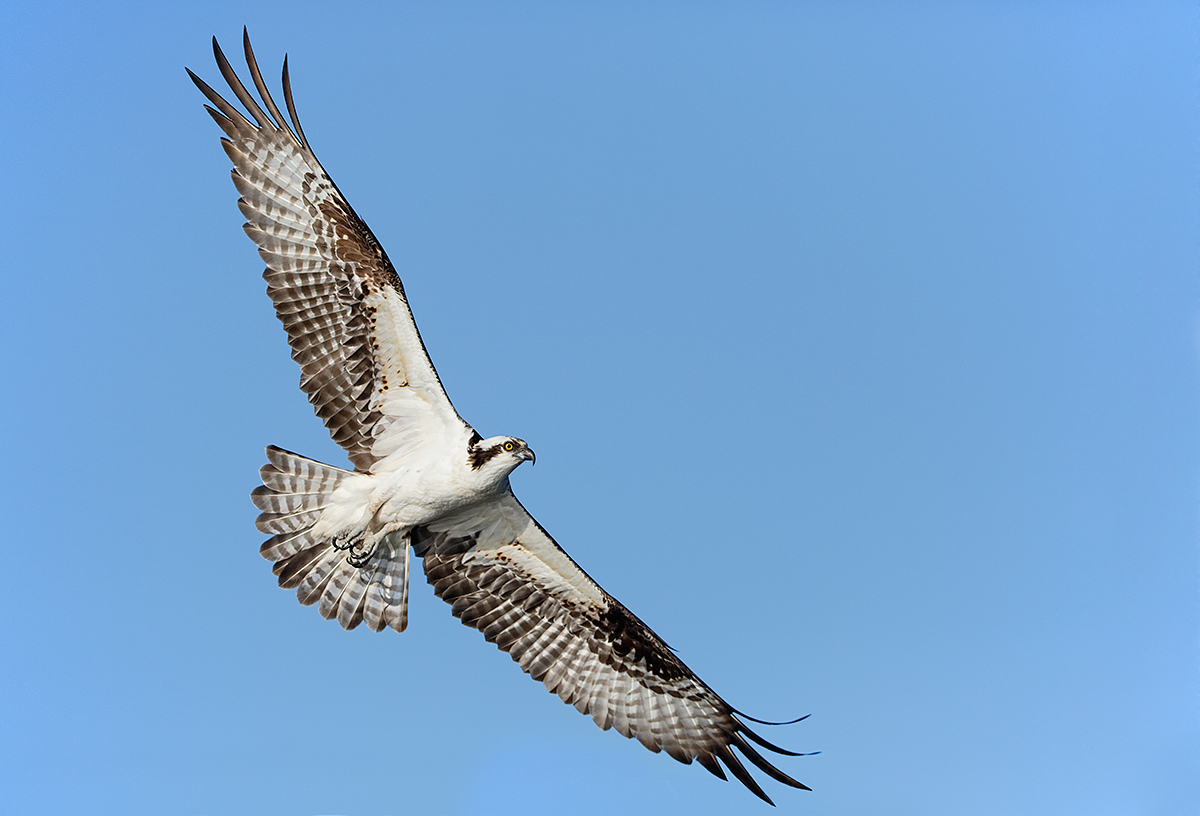
|
|
This image was created on Lake Blue Cypress on March 21, 2014 at 8:46am on a clear morning right down sun angle with the hand held the Canon EF 200-400mm f/4L IS USM Lens with Internal 1.4x Extender (with the internal TC engaged at 320mm) and the Canon EOS-1D X. ISO 800. Evaluative metering +1/3 stop as framed: 1/3200 sec. at f/7.1 in Manual mode. AWB.
Central Sensor/AI Servo-Surround/Rear Focus AF active at the moment of exposure just caught the top of the bird’s head; see the BreezeBrowser screen capture below. Click here to see the latest version of the Rear Focus Tutorial. Click on the image to see a larger version. .
|
Lake Blue Cypress
Lake Blue Cypress is an incredibly beautiful location with hundreds of pairs of Osprey all using natural nest sites. If you spend a morning and afternoon aboard Jim Neiger’s customized pontoon boat it is possible to create a wonderful Osprey portfolio in a single day. This Saturday’s trip is sold out but there is a single opening on Friday, April 11. Scroll down for details.
Update
Friday is now sold out.
|
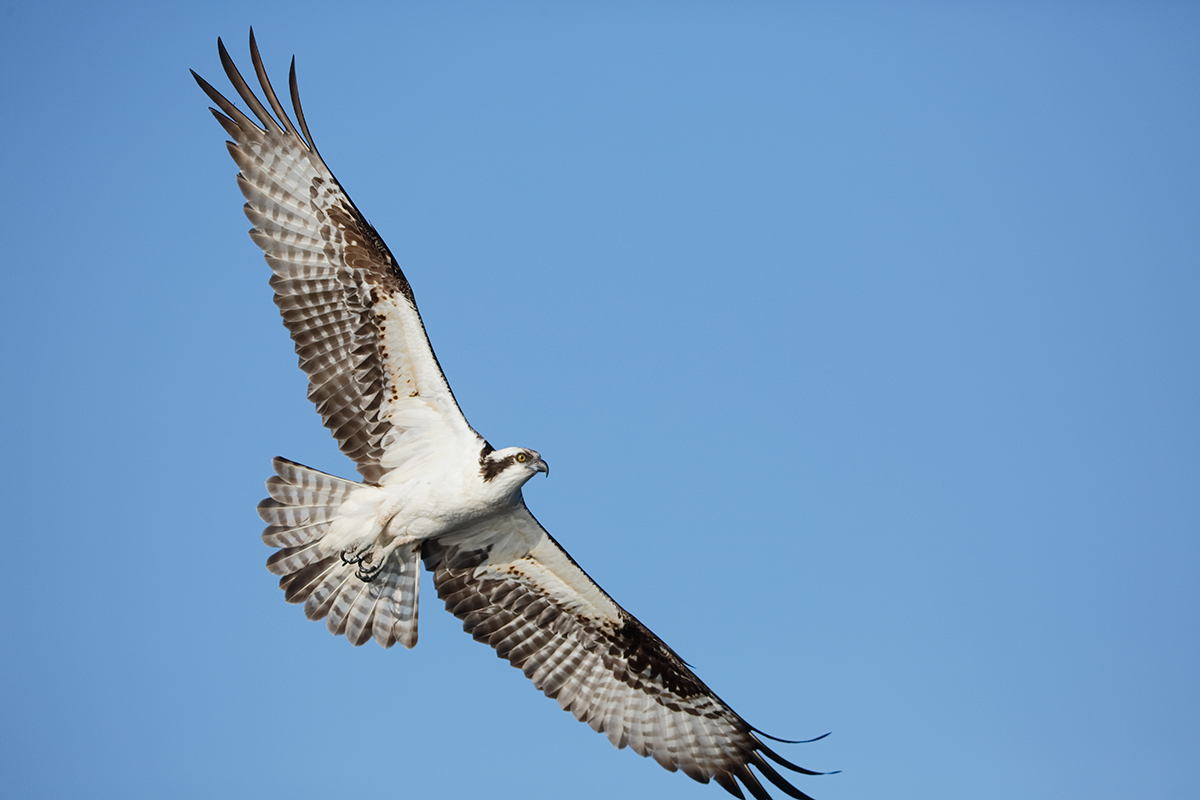
|
|
This is the original capture.
|
Greedy, Greedy, Greedy
Even having zoomed out to 320mm, I clipped the three of the bird’s left wingtips, those of the 3rd, 4th, and 5th primaries. I love the nearly perfect lighting on the underwings, the diagonal, and the placement of the bird well back in the frame so the choice to repair the missing wingtips was an obvious one. After converting the image in DPP, I expanded canvas below, grabbed the corresponding wingtips from the right wing–each on a separate layer, repositioned, transformed, and warped each of them, and then added a Regular Layer Mask to fine-tune things.
APTATS I to the Rescue
Using the techniques detailed in the 4th tutorial in APTATS I, “Clipped Feather Tip Repair,” it took me only fifteen minutes to salvage this image and replace tips of the 3 clipped primaries. I used the tip of the 5th primary to replace the missing tip of the 4th primary. And I used the tip of the first primary to replace the missing tips of the 2nd and 3rd primaries. I did work both large and carefully. The advanced knowledge of Layer Masking that I picked up from APTATS II was of course quite helpful in fine-tuning the various wingtip layers.
APTATS I & II
Learn the details of advanced Quick Masking techniques in APTATS I. Mention this blog post and apply a $5 discount with phone orders only. Learn advanced Layer Masking Techniques in APTATS II. Mention this blog post and apply a $5 discount with phone orders only. Buy the pair, APTATS I and APTATS II and we will be glad to apply at $15 discount with phone orders only.
Eye Doctor Work
Be sure to enlarge the optimized and the original versions and check out the Eye Doctor work. See more in Digital Basics immediately below.
Digital Basics
Are you tired of making your images look worse in Photoshop? Do you have no clue as to how I optimized the images above? The Photoshop stuff mentioned above plus tons more is detailed in my Digital Basics File, an instructional PDF that is sent via e-mail. It includes my complete digital workflow, dozens of great Photoshop tips, the use of Contrast Masks, several different ways of expanding canvas, all of my time-saving Keyboard Shortcuts, Quick Masking, Layer Masking, and NIK Color Efex Pro basics, my killer image clean-up techniques, Digital Eye Doctor, creating time-saving actions, and lots more.
The DPP RAW Conversion Guide
After seeing the accurate colors that I get from my DPP RAW conversions, Japan in Winter co-leader Paul McKenzie switched to DPP conversions and Denise Ippolito is considering doing the same. Now that is amazing…. To learn why I use Canon’s Digital Photo Professional (DPP) to convert every image that I work on, click here.
|
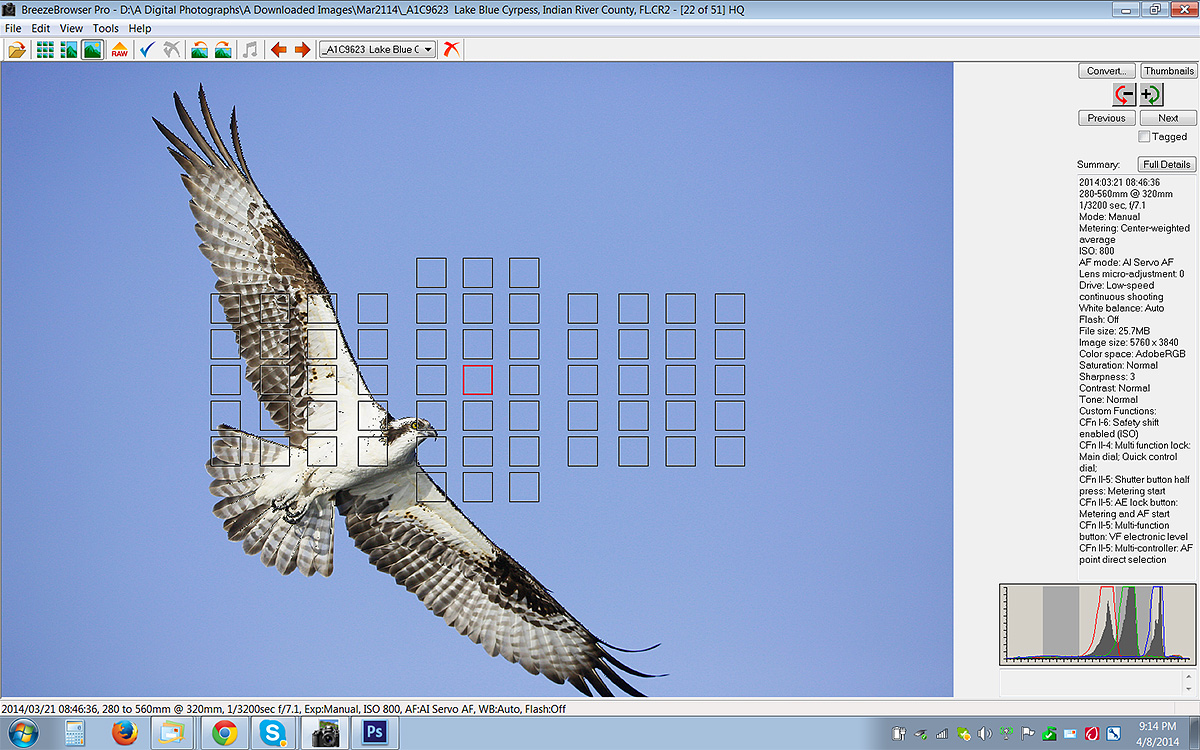
|
|
Our efforts to create flight images with large-in-the-frame subjects often results in clipped wingtips. Above is the Breezebrowser Main View screen capture for today’s image.
|
A Flight Photography Tip That You Have Never Read Anywhere Else….
Note in the BreezeBrowser screen capture above that the lower left corner of the lower left Surround AF point just barely caught the top of the bird’s head. Note: the 8 AF points surrounding the central sensor here were active; it would be nice if the sensor that was active at the moment of exposure were lit up rather than the selected sensor.
What I try to do with images like this where I want the original image file to feature the flying bird well back in the frame is to increase the speed of my panning motion just as I depress the shutter button even if that results in the active AF sensor falling on the sky. As doing this goes against instinct it requires a conscious effort to pull it off. In some cases you need to let go of the focus button (either rear or shutter) and then push the button again in order to re-acquire focus.
The heavy vignetting was corrected in Photoshop using Filter/Lens Correction/Custom on a separate layer as described in Digital Basics File.
The Breezebrowser Main View Screen Capture
Above is the BreezeBrowser Main View screen capture for today’s image. Note that the illuminated red square shows the AF point that was selected. Note: in Breezebrowser you need to check “Show Focus Points” under View to activate this feature. To see the focus points in DPP check “AF Point” under View or hit Alt L. Hit Alt M to see Highlight Alert. To learn how and why I use DPP (Canon Digital Photo Professional) to convert my RAW files, see the info on our DPP RAW Conversion Guide here.
Note the perfect histogram the WHITEs well into the rightmost histogram box. Regular readers know that I use and depend on BreezeBrowser every day of the year. It allows me to sort my keepers and delete the rejects faster than any other Windows browsing program. We use it on the main computer in the home office to catalog our images file-drawer style. And the companion program, Downloader Pro allows me to download my images quickly and conveniently. It automatically adds my IPTC data and the shooting location. I have it set up to create a folder named by the Month/date/year. The Breezebrowser/Downloader Pro combo saves me many hours each week. To learn more or to purchase this great PC only program, click here. As far as the BreezeBrowser/Downloader Pro Combo goes, if you are using a Windows platform and are not using these two great programs you are at best, wasting your valuable time. My understanding is that Photo Mechanic is best for Mac-users who do not opt to run Parallels or VM Ware fusion on their Macs so that they can enjoy the many advantages of BreezeBrowser. See BreezeBrowswer on a Mac for details.
|
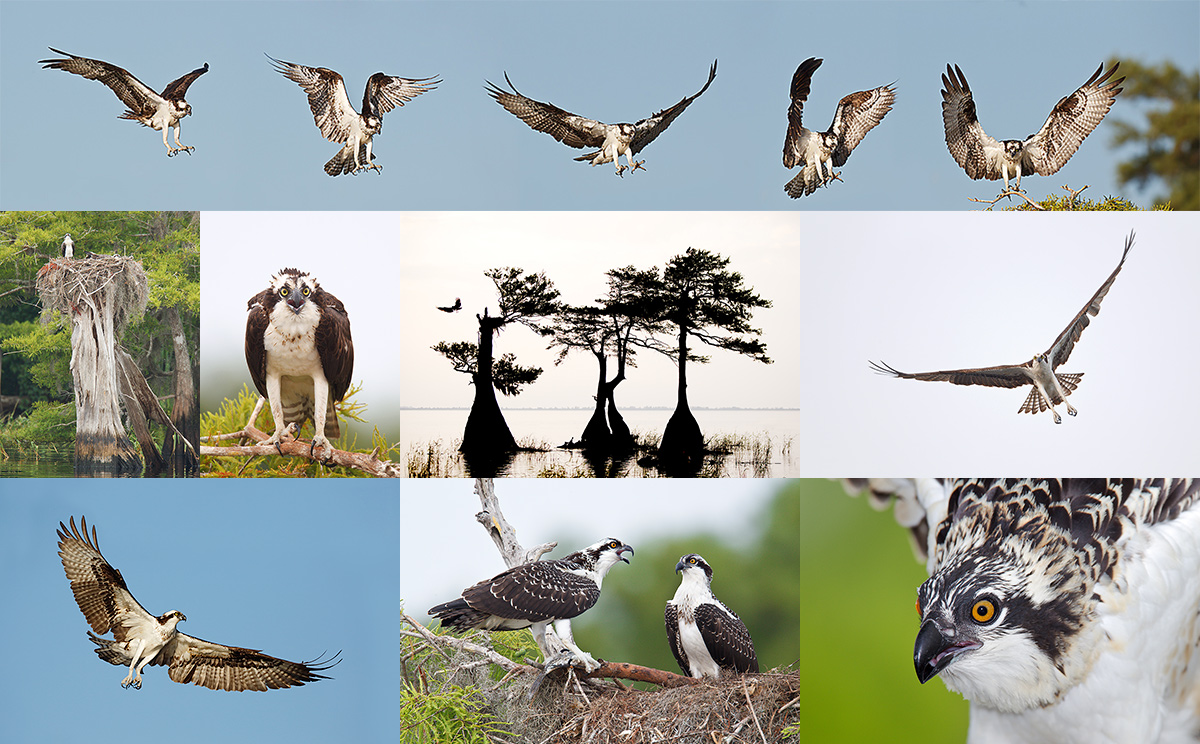
|
|
All images created on Lake Blue Cypress. Copyright Arthur Morris/BIRDS AS ART. Click on the composite to enjoy a larger version.
|
Lake Blue Cypress Osprey Heaven Full-Day In-the-Field Hand Holding Workshops via Customized Pontoon Boat
Two 3+ hour shooting sessions on a beautiful cypress lake teeming with Osprey; Barred Owl almost guaranteed. Red-shouldered Hawk and Pileated Woodpecker likely. Be sure to follow the link to Jim’s gallery below.
2 great leaders: Captain Jim Neiger and Arthur Morris.
Update
Friday and Saturday are now sold out.
Each full day booking includes a delicious healthy lunch at my home. Overnight lodging at my home is available cheap on a limited basis for folks who would like to do more than one day. Please inquire via e-mail.
Because of the late date payment in full by credit card is due now. Please e-mail for additional details of info or call Jim or Jennifer at 863-692-0906 to register.
Check out Jim Neiger’s Osprey Heaven/Lake Blue Cypress Gallery here and you will be amazed as to the quality of the flight and action images and the possibilities.
Flight Plan
If you want to learn to be a better flight photographer, check out Jim Neiger’s great e-Guide here.
Support the BAA Blog. Support the BAA Bulletins: Shop B&H here!
We want and need to keep providing you with the latest free information, photography and Photoshop lessons, and all manner of related information. Show your appreciation by making your purchases immediately after clicking on any of our B&H or Amazon Affiliate links in this blog post. Remember, B&H ain’t just photography!


 


Amazon
Everyone buys something from Amazon, be it a big lens or deodorant. Support the blog by starting your search by clicking on the logo-link below. No purchase is too small to be appreciated; they all add up. Why make it a habit? Because I make it a habit of bringing you new images and information on an almost daily basis.
Typos
In all blog posts and Bulletins, feel free to e-mail or to leave a comment regarding any typos, wrong words, misspellings, omissions, or grammatical errors. Just be right. 🙂
April 8th, 2014 The Streak Continues
This post marks 130 straight days with a new educational blog post. With so many folks getting in the habit of using our B&H and Amazon links why quit now? To show your appreciation for my efforts here, we do ask that you use our the B&H and Amazon affiliate links on the right side of the blog for all of your purchases. Please check the availability of all photographic accessories in the BIRDS AS ART Online Store. We sell only what I use and depend on. We will not sell you junk. We know what you need to make creating great images easy and fun. And we are always glad to answer your gear questions via e-mail.
You can find the following items in the store: Gitzo tripods, Mongoose M3.6 and Wimberley heads, plates, low feet, and accessories, flash brackets, , Delkin e-film Pro Compact Flash Cards, LensCoat products, and our unique line-up of educational materials including ABP I & II, Digital Basics, Site and Set-up e-Guides, Canon and Nikon Camera Users and AF e-Guides, and MP-4 Photoshop video tutorials among others.
I would of course appreciate your using our B&H affiliate links for all of your major gear, video, and electronic purchases. For the photographic stuff mentioned in the paragraph above we, meaning BAA, would of course greatly appreciate your business. Here is a huge thank you to the many who have been using our links on a regular basis and visiting the BAA Online store as well.
This blog post took about 3 hours to assemble. Enjoy!
Dreaming of Africa?
No need. Check out the wonderful video from Gustafson Photo Safaris here and Todd’s amazing image galleries here. You will find details on this summer’s Tanzania Photo Safari below.
|
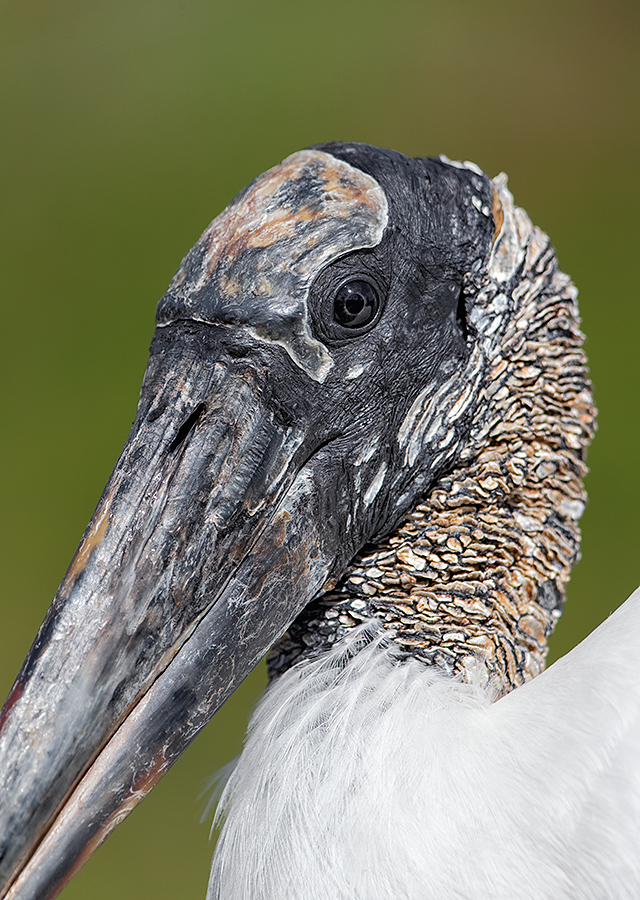
|
|
This image was created at Gatorland on Saturday April 5, 2014 at 4:38pm on a clear afternoon in direct sunlight. I hand held the Canon EF 200-400mm f/4L IS USM Lens with Internal 1.4x Extender (with the internal TC engaged at 490mm) and the Canon EOS-1D X. ISO 400. Evaluative metering +1/3 stop as framed: 1/1600 sec. at f/6.3 in Avmode. AWB.
Three sensors up from the central Sensor/AI Servo-Surround/Rear Focus AF directly on the bird’s eye as originally framed was active at the moment of exposure. Practicing so that you are able to change AF sensors almost instantly is an important skill to work on. Learn everything there is to know about the 1D X and 5D III AF systems including how to manage the various AF Area Selection Modes, when to use which one, and several ways to move the AF sensor around in my 1D X AF Guide and the 5D Mark III User’s Guide. Click here to see the latest version of the Rear Focus Tutorial. Click on the image to see a larger version. .
Image #1: Wood Stork Head and Face Detail.
|
Striking While the Iron is Hot
I have been asking lots of questions lately, and many folks have put their thinking caps on and left comments with their answers. There have been lots of right answers and lots of wrong answers. Some wrong answers however were perfect for another question :).
Here we will take an in-depth look at the questions from yesterday’s post. Enjoy the learning.
Note: I have responded to each comment in yesterday’s post here.
Image Questions
Questions in green
Answers in white.
#1: Why was I in Av mode for Image #1 but in Manual mode for Image #2?
Only Greg Payne got this one right; he nailed it when he wrote: “Aperture priority for #1 because it was possibly a fleeting opportunity and it had just occurred. You could dial in compensation and go to work. As the bird stayed around you could go to manual exposure based on the readings used previously.” The clue was in the story, and I quote: “Dierdre, Lynn, and I had just arrived and gotten our gear set up when some kids began tossing some gator food-pellets into the water. This in turn attracted not only a flock of small gators but some birds as well. Wood Storks rarely sit on the boardwalk railings, but this one pictured here was hungry for a pellet. I grabbed my 200-400 and went to work opting to hand hold so that I could frame accurately and react quickly.”
When presented with a new situation, as I was when creating the image above (having just arrived and grabbed my 2-4), I will most often go to Av mode. Having studied exposure for close to 3 decades now, I can usually set the exposure compensation to within 1/3 stop of perfect. Here I nailed it at +1/3. Once I knew the right exposure for the Wood Stork, 1/1600 sec. at f/6.3, I set that exposure manually. In effect, I had worked in Av mode to do my exposure check.
Here’s the best news: you too can learn to determine the right exposure compensation with just a glance, to see and understand the light, to understand what your camera’s meter is doing, and to understand the influence of the various tonalities, be they black or white, light or dark, on the metering system. How? Study the chapter on Exposure in the original, soft cover, The Art of Bird Photography (ABP), especially the section on exposure theory. And once you have mastered that, study the Exposure Simplified section in The Art of Bird Photography II (ABP II: 916 pages, 900+ images). You can save $10 by ordering the two-book bundle here.
#2: The exposure for Image #1 was perfect. Why did I need to go 1/3 stop darker for Image #2?
There were lots of misconceptions when folks attempted to answer this one. When you are working in Manual mode the shutter speed and the aperture together determine the exposure. The exposure compensation is the result not the cause. When you are working in an automatic mode like Av or Tv the EC is the cause. With image 1 the exposure was 1/1600 sec. at f/6.3. In image #2 the exposure was 1/2000 sec. at f/6.3, 1/3 stop darker.
The difference in the exposure compensations for the 2 images was the result of the differences in subject size, framing, and the amount of dark background.
So why did I go 1/3 stop darker (1/2000 sec. at f/6.3 is 1/3 stop darker than 1/1600 sec. at f/6.3) for image #2? Because the WHITEs on a Great Egret are brighter than the WHITEs on a Wood Stork. Knowing that, I made one image with the two birds in the frame, checked the histogram, saw the blinkies on the Great Egret, and spun the finger wheel dial 1/3 stop clockwise to increase the shutter speed from 1/1600 sec. to 1/2000 sec.
#3: Why should I definitely have gone to a smaller aperture, at least down to f/9, for Image #1?
Though Doug West hinted at the right answer Eve Turek and John Beasely got this one right: stopping down would have sharpened up the back of the stork’s neck.
#4: What is the one thing about Image #2 that bugs me a bit?
Kudos to multiple IPT veteran Doug West who knows me too well. He stated, “The head angle of the egret; it was facing slightly away.”
#5:Considering the fact that the aperture was the same, f/6.3. why does the skin on the Wood Stork’s neck look so much sharper in Image 2 than in Image 1?
Several folks got this one right but John Beasley said it best: “Oops. Question 5 – the neck is sharper because the subject was further away from your camera so your DOF is greater?” Only a wrong word kept him away from perfection. He should have used “farther” as he was referring to distance. Further refers to advancing a thought or idea.
|
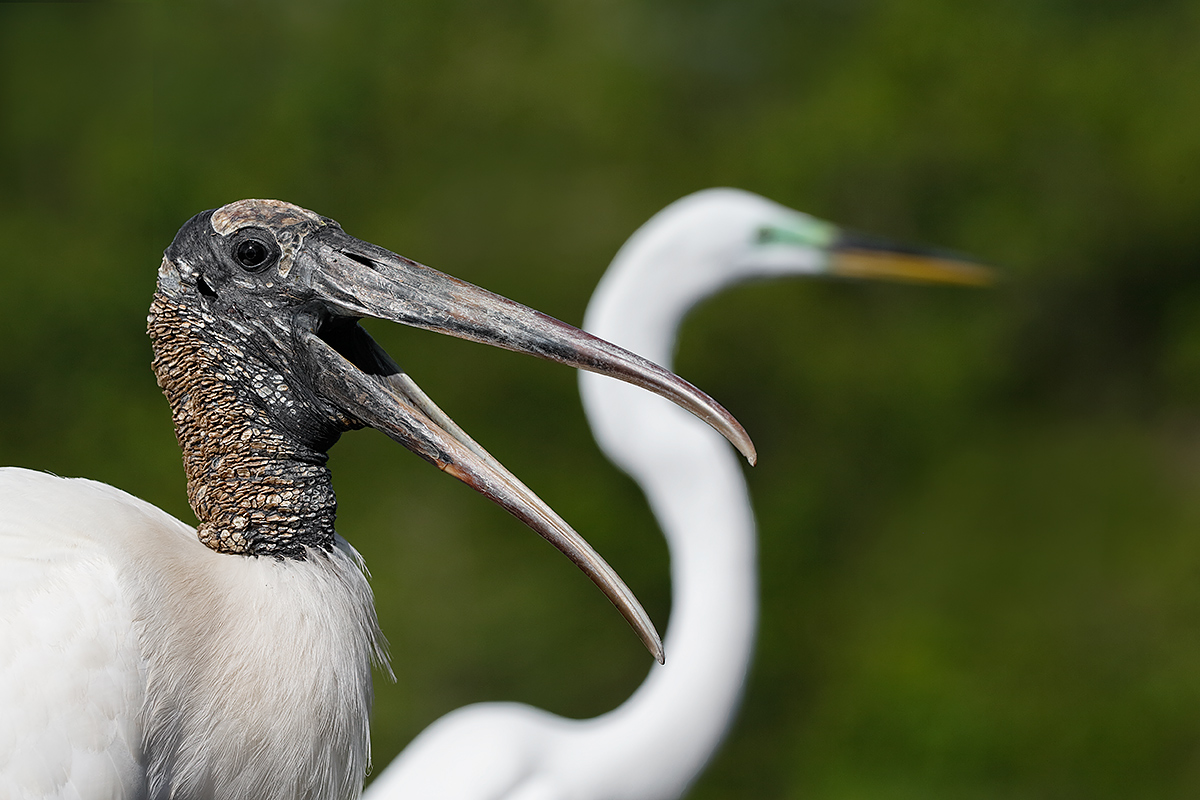
|
|
This image was also created at Gatorland on Saturday April 5, 2014, this one–of the same bird, at 4:39pm, about one minute after I created the opening image in this blog post. Again, on a clear afternoon in direct sunlight. And again I hand held the Canon EF 200-400mm f/4L IS USM Lens with Internal 1.4x Extender (at 250mm) and the Canon EOS-1D X. ISO 400. Evaluative metering -1/3 stop as framed: 1/2000 sec. at f/6.3 in Manual mode. AWB.
Three sensors to the left of the central Sensor/AI Servo-Surround/Rear Focus AF on the base of the stork’s lower mandible (as originally framed) was active at the moment of exposure. Again, practicing so that you are able to change AF sensors almost instantly is an important skill to work develop. You can learn everything that there is to know about the 1D X and 5D III AF systems including how to manage the various AF Area Selection Modes, when to use which one, and several ways to move the AF sensor around in my 1D X AF Guide and the 5D Mark III User’s Guide. Click here to see the latest version of the Rear Focus Tutorial. Click on the image to see a larger version.
Image #2: Wood Stork/Great Egret Juxtaposition.
|
My Favorite?
I like both images equally. Had the Great Egret had its head square to the back of the camera in the second image, it would have been my favorite by far.
Confused?
If you are confused by anything that I wrote above, do let me know by leaving a comment below and I will try to help.
Comments and Answers
After I publish this at about 11:15am, I will address the many comments left at the original post here.
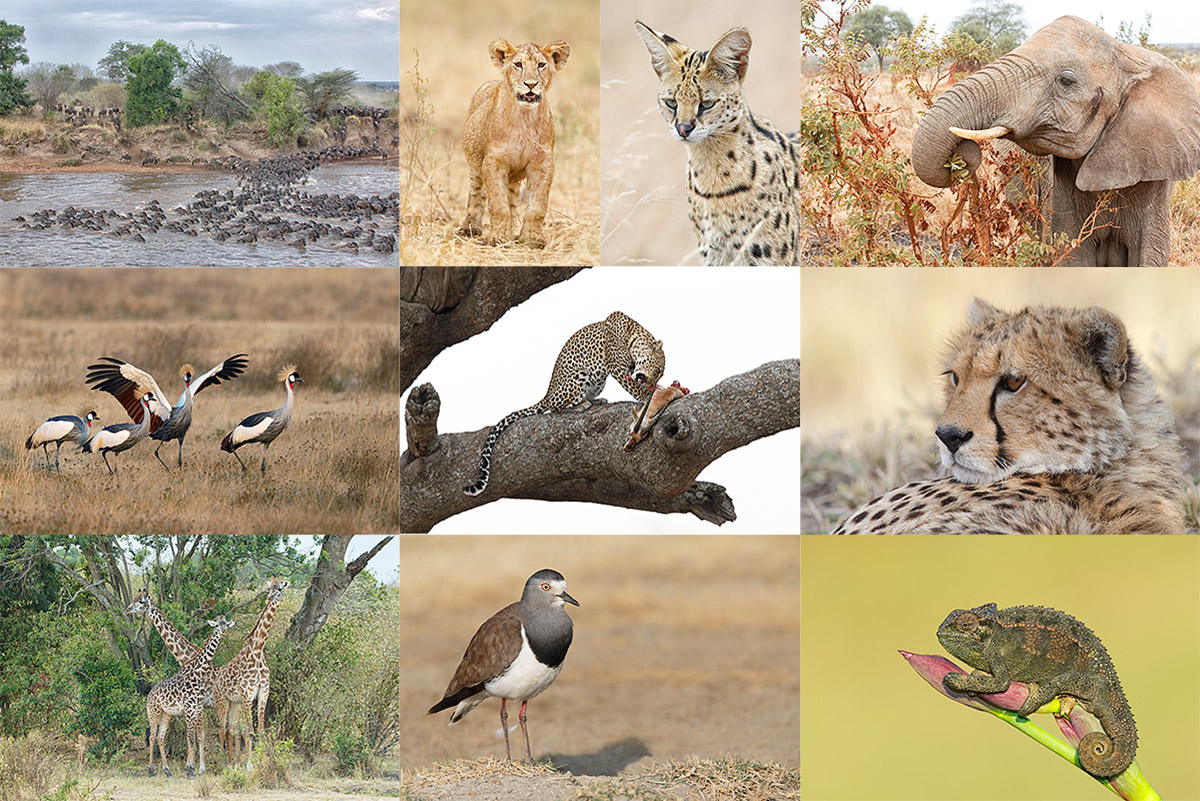
|
|
Now is about your last chance to join me for the 2014 Tanzania Summer Safari!
|
2014 Tanzania Summer Safari, 14-day African Adventure/leave the US on August 9. Fly home on August 24: $12,999.
Leader: Arthur Morris. Three photographers/van; you get your own row of seats. Our trip is a bit more expensive than the average safari for good reason. It is the best. We have the best driver guides with a total of decades of experience. They have been trained over the years by Todd and by me to drive with photography in mind. We stay in the best lodges and camps. We hope that you will join me for my 8th 35th African photo safari.
If you are seriously interested please e-mail me; I will be glad to send you the illustrated PDF with the complete itinerary and deposit info.
What else makes this expedition unique?
•Pre-trip consultation and camera equipment advice
•Award-winning photographers as your guides
•A seamless itinerary visiting the right locations at the best time of year
•Hands-on photography instruction in the field
•Specially designed three roof-hatch photo safari vehicles
•Proprietary materials for preparation, including free copy of “A Photographer’s Guide to Photographing in East Africa.”
•Post-safari image critiques
All-inclusive (double-occupancy) except for your flights to and from Kilamajaro Airport, bar drinks, soda & water (except at the Intimate Tented Camp where everything is free for our entire stay), tips for drivers and camp staff, personal items, and trip insurance.
Support the BAA Blog. Support the BAA Bulletins: Shop B&H here!
We want and need to keep providing you with the latest free information, photography and Photoshop lessons, and all manner of related information. Show your appreciation by making your purchases immediately after clicking on any of our B&H or Amazon Affiliate links in this blog post. Remember, B&H ain’t just photography!


 


Amazon
Everyone buys something from Amazon, be it a big lens or deodorant. Support the blog by starting your search by clicking on the logo-link below. No purchase is too small to be appreciated; they all add up. Why make it a habit? Because I make it a habit of bringing you new images and information on an almost daily basis.
Typos
In all blog posts and Bulletins, feel free to e-mail or to leave a comment regarding any typos, wrong words, misspellings, omissions, or grammatical errors. Just be right. 🙂
|
|



